Crime, the Criminal Justice System, and Socioeconomic Inequality
VerifiedAdded on 2023/04/21
|24
|12850
|413
AI Summary
This article explores the relationship between crime, the criminal justice system, and socioeconomic inequality in the United States. It discusses the decline in crime rates and the simultaneous increase in incarceration rates, highlighting the disproportionate impact on poor and minority communities. The article also examines the role of incarceration in reducing crime and suggests that public policy should focus on reducing crime and inequality in victimization.
Contribute Materials
Your contribution can guide someone’s learning journey. Share your
documents today.
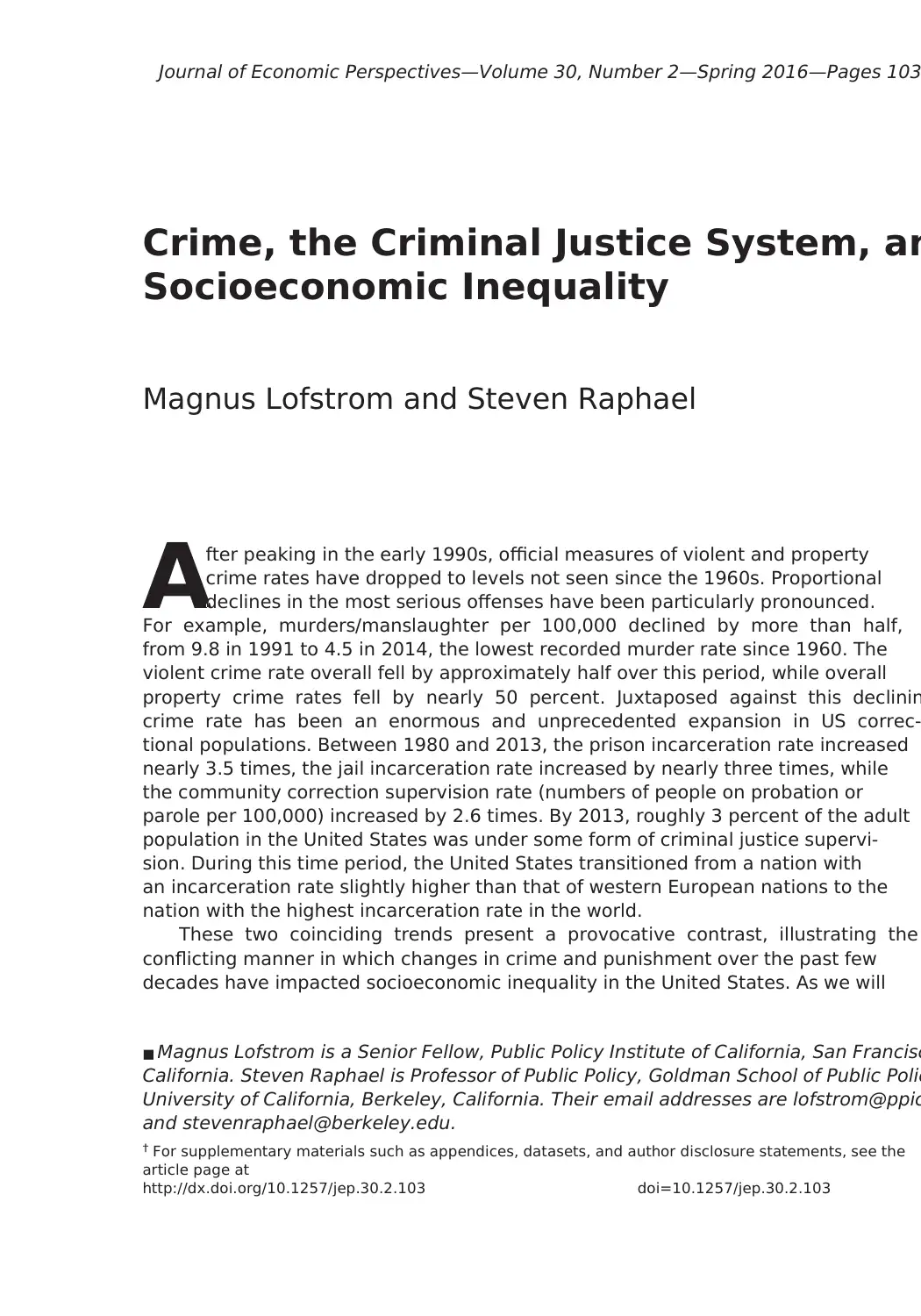
Journal of Economic Perspectives—Volume 30, Number 2—Spring 2016—Pages 103
After peaking in the early 1990s, official measures of violent and property
crime rates have dropped to levels not seen since the 1960s. Proportional
declines in the most serious offenses have been particularly pronounced.
For example, murders/manslaughter per 100,000 declined by more than half,
from 9.8 in 1991 to 4.5 in 2014, the lowest recorded murder rate since 1960. The
violent crime rate overall fell by approximately half over this period, while overall
property crime rates fell by nearly 50 percent. Juxtaposed against this declinin
crime rate has been an enormous and unprecedented expansion in US correc-
tional populations. Between 1980 and 2013, the prison incarceration rate increased
nearly 3.5 times, the jail incarceration rate increased by nearly three times, while
the community correction supervision rate (numbers of people on probation or
parole per 100,000) increased by 2.6 times. By 2013, roughly 3 percent of the adult
population in the United States was under some form of criminal justice supervi-
sion. During this time period, the United States transitioned from a nation with
an incarceration rate slightly higher than that of western European nations to the
nation with the highest incarceration rate in the world.
These two coinciding trends present a provocative contrast, illustrating the
conflicting manner in which changes in crime and punishment over the past few
decades have impacted socioeconomic inequality in the United States. As we will
Crime, the Criminal Justice System, an
Socioeconomic Inequality
■ Magnus Lofstrom is a Senior Fellow, Public Policy Institute of California, San Francisc
California. Steven Raphael is Professor of Public Policy, Goldman School of Public Polic
University of California, Berkeley, California. Their email addresses are lofstrom@ppic
and stevenraphael@berkeley.edu.
† For supplementary materials such as appendices, datasets, and author disclosure statements, see the
article page at
http://dx.doi.org/10.1257/jep.30.2.103 doi=10.1257/jep.30.2.103
Magnus Lofstrom and Steven Raphael
After peaking in the early 1990s, official measures of violent and property
crime rates have dropped to levels not seen since the 1960s. Proportional
declines in the most serious offenses have been particularly pronounced.
For example, murders/manslaughter per 100,000 declined by more than half,
from 9.8 in 1991 to 4.5 in 2014, the lowest recorded murder rate since 1960. The
violent crime rate overall fell by approximately half over this period, while overall
property crime rates fell by nearly 50 percent. Juxtaposed against this declinin
crime rate has been an enormous and unprecedented expansion in US correc-
tional populations. Between 1980 and 2013, the prison incarceration rate increased
nearly 3.5 times, the jail incarceration rate increased by nearly three times, while
the community correction supervision rate (numbers of people on probation or
parole per 100,000) increased by 2.6 times. By 2013, roughly 3 percent of the adult
population in the United States was under some form of criminal justice supervi-
sion. During this time period, the United States transitioned from a nation with
an incarceration rate slightly higher than that of western European nations to the
nation with the highest incarceration rate in the world.
These two coinciding trends present a provocative contrast, illustrating the
conflicting manner in which changes in crime and punishment over the past few
decades have impacted socioeconomic inequality in the United States. As we will
Crime, the Criminal Justice System, an
Socioeconomic Inequality
■ Magnus Lofstrom is a Senior Fellow, Public Policy Institute of California, San Francisc
California. Steven Raphael is Professor of Public Policy, Goldman School of Public Polic
University of California, Berkeley, California. Their email addresses are lofstrom@ppic
and stevenraphael@berkeley.edu.
† For supplementary materials such as appendices, datasets, and author disclosure statements, see the
article page at
http://dx.doi.org/10.1257/jep.30.2.103 doi=10.1257/jep.30.2.103
Magnus Lofstrom and Steven Raphael
Secure Best Marks with AI Grader
Need help grading? Try our AI Grader for instant feedback on your assignments.
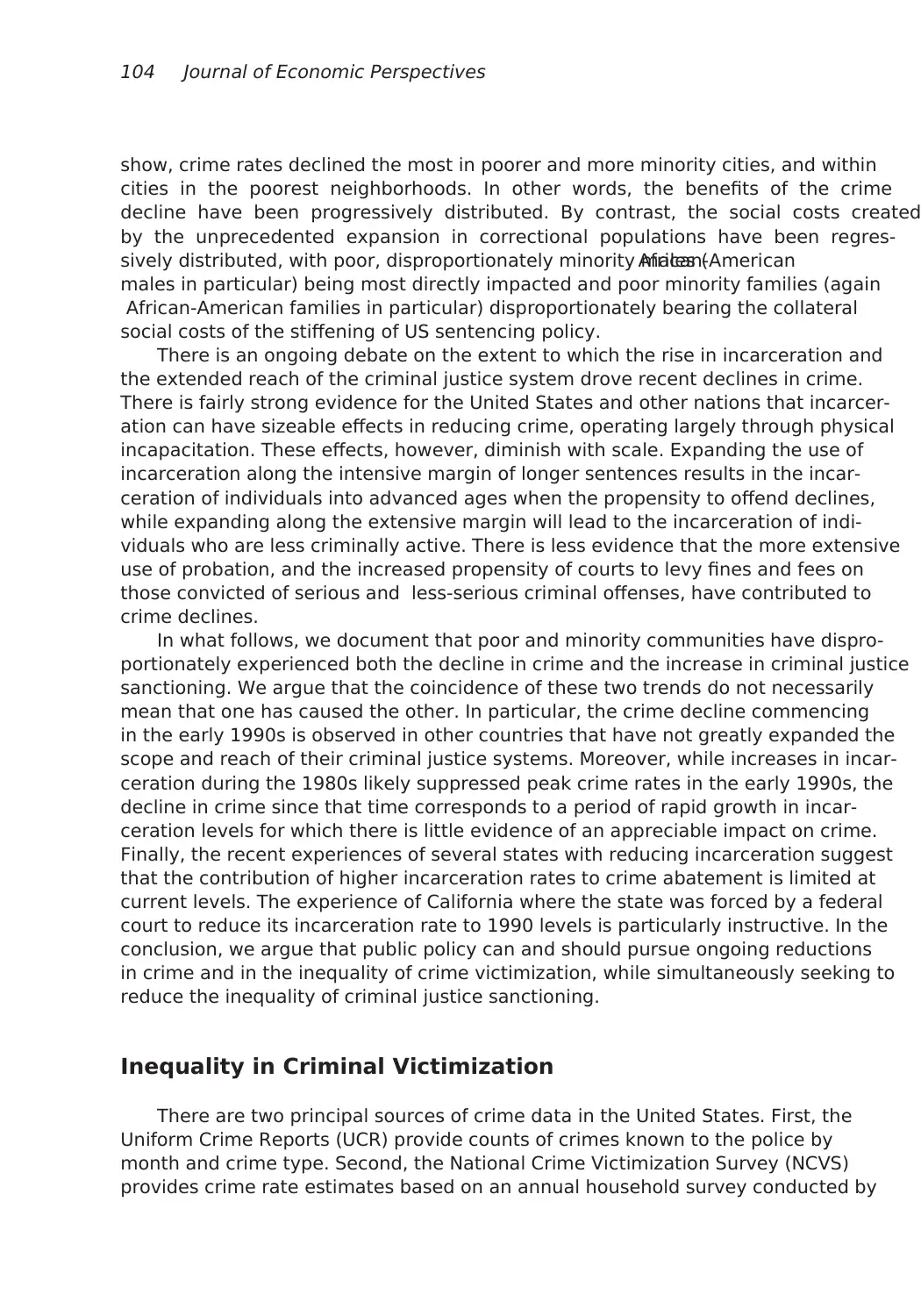
104 Journal of Economic Perspectives
show, crime rates declined the most in poorer and more minority cities, and within
cities in the poorest neighborhoods. In other words, the benefits of the crime
decline have been progressively distributed. By contrast, the social costs created
by the unprecedented expansion in correctional populations have been regres-
sively distributed, with poor, disproportionately minority males (African-American
males in particular) being most directly impacted and poor minority families (again
African-American families in particular) disproportionately bearing the collateral
social costs of the stiffening of US sentencing policy.
There is an ongoing debate on the extent to which the rise in incarceration and
the extended reach of the criminal justice system drove recent declines in crime.
There is fairly strong evidence for the United States and other nations that incarcer-
ation can have sizeable effects in reducing crime, operating largely through physical
incapacitation. These effects, however, diminish with scale. Expanding the use of
incarceration along the intensive margin of longer sentences results in the incar-
ceration of individuals into advanced ages when the propensity to offend declines,
while expanding along the extensive margin will lead to the incarceration of indi-
viduals who are less criminally active. There is less evidence that the more extensive
use of probation, and the increased propensity of courts to levy fines and fees on
those convicted of serious and less-serious criminal offenses, have contributed to
crime declines.
In what follows, we document that poor and minority communities have dispro-
portionately experienced both the decline in crime and the increase in criminal justice
sanctioning. We argue that the coincidence of these two trends do not necessarily
mean that one has caused the other. In particular, the crime decline commencing
in the early 1990s is observed in other countries that have not greatly expanded the
scope and reach of their criminal justice systems. Moreover, while increases in incar-
ceration during the 1980s likely suppressed peak crime rates in the early 1990s, the
decline in crime since that time corresponds to a period of rapid growth in incar-
ceration levels for which there is little evidence of an appreciable impact on crime.
Finally, the recent experiences of several states with reducing incarceration suggest
that the contribution of higher incarceration rates to crime abatement is limited at
current levels. The experience of California where the state was forced by a federal
court to reduce its incarceration rate to 1990 levels is particularly instructive. In the
conclusion, we argue that public policy can and should pursue ongoing reductions
in crime and in the inequality of crime victimization, while simultaneously seeking to
reduce the inequality of criminal justice sanctioning.
Inequality in Criminal Victimization
There are two principal sources of crime data in the United States. First, the
Uniform Crime Reports (UCR) provide counts of crimes known to the police by
month and crime type. Second, the National Crime Victimization Survey (NCVS)
provides crime rate estimates based on an annual household survey conducted by
show, crime rates declined the most in poorer and more minority cities, and within
cities in the poorest neighborhoods. In other words, the benefits of the crime
decline have been progressively distributed. By contrast, the social costs created
by the unprecedented expansion in correctional populations have been regres-
sively distributed, with poor, disproportionately minority males (African-American
males in particular) being most directly impacted and poor minority families (again
African-American families in particular) disproportionately bearing the collateral
social costs of the stiffening of US sentencing policy.
There is an ongoing debate on the extent to which the rise in incarceration and
the extended reach of the criminal justice system drove recent declines in crime.
There is fairly strong evidence for the United States and other nations that incarcer-
ation can have sizeable effects in reducing crime, operating largely through physical
incapacitation. These effects, however, diminish with scale. Expanding the use of
incarceration along the intensive margin of longer sentences results in the incar-
ceration of individuals into advanced ages when the propensity to offend declines,
while expanding along the extensive margin will lead to the incarceration of indi-
viduals who are less criminally active. There is less evidence that the more extensive
use of probation, and the increased propensity of courts to levy fines and fees on
those convicted of serious and less-serious criminal offenses, have contributed to
crime declines.
In what follows, we document that poor and minority communities have dispro-
portionately experienced both the decline in crime and the increase in criminal justice
sanctioning. We argue that the coincidence of these two trends do not necessarily
mean that one has caused the other. In particular, the crime decline commencing
in the early 1990s is observed in other countries that have not greatly expanded the
scope and reach of their criminal justice systems. Moreover, while increases in incar-
ceration during the 1980s likely suppressed peak crime rates in the early 1990s, the
decline in crime since that time corresponds to a period of rapid growth in incar-
ceration levels for which there is little evidence of an appreciable impact on crime.
Finally, the recent experiences of several states with reducing incarceration suggest
that the contribution of higher incarceration rates to crime abatement is limited at
current levels. The experience of California where the state was forced by a federal
court to reduce its incarceration rate to 1990 levels is particularly instructive. In the
conclusion, we argue that public policy can and should pursue ongoing reductions
in crime and in the inequality of crime victimization, while simultaneously seeking to
reduce the inequality of criminal justice sanctioning.
Inequality in Criminal Victimization
There are two principal sources of crime data in the United States. First, the
Uniform Crime Reports (UCR) provide counts of crimes known to the police by
month and crime type. Second, the National Crime Victimization Survey (NCVS)
provides crime rate estimates based on an annual household survey conducted by
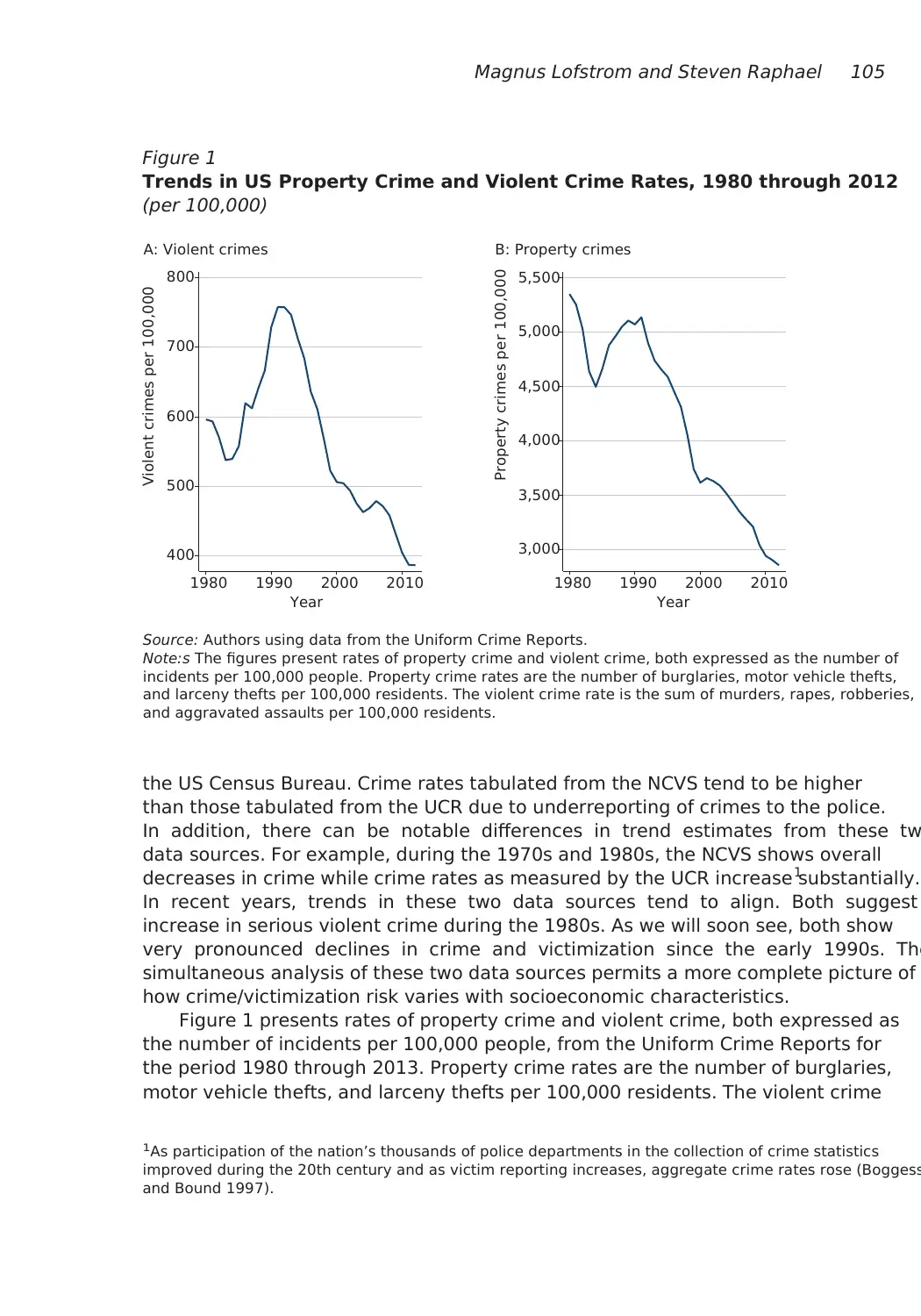
Magnus Lofstrom and Steven Raphael 105
the US Census Bureau. Crime rates tabulated from the NCVS tend to be higher
than those tabulated from the UCR due to underreporting of crimes to the police.
In addition, there can be notable differences in trend estimates from these tw
data sources. For example, during the 1970s and 1980s, the NCVS shows overall
decreases in crime while crime rates as measured by the UCR increase substantially.1
In recent years, trends in these two data sources tend to align. Both suggest
increase in serious violent crime during the 1980s. As we will soon see, both show
very pronounced declines in crime and victimization since the early 1990s. The
simultaneous analysis of these two data sources permits a more complete picture of
how crime/victimization risk varies with socioeconomic characteristics.
Figure 1 presents rates of property crime and violent crime, both expressed as
the number of incidents per 100,000 people, from the Uniform Crime Reports for
the period 1980 through 2013. Property crime rates are the number of burglaries,
motor vehicle thefts, and larceny thefts per 100,000 residents. The violent crime
1As participation of the nation’s thousands of police departments in the collection of crime statistics
improved during the 20th century and as victim reporting increases, aggregate crime rates rose (Boggess
and Bound 1997).
Figure 1
Trends in US Property Crime and Violent Crime Rates, 1980 through 2012
(per 100,000)
Source: Authors using data from the Uniform Crime Reports.
Note:s The figures present rates of property crime and violent crime, both expressed as the number of
incidents per 100,000 people. Property crime rates are the number of burglaries, motor vehicle thefts,
and larceny thefts per 100,000 residents. The violent crime rate is the sum of murders, rapes, robberies,
and aggravated assaults per 100,000 residents.
A: Violent crimes
400
500
600
700
800
Violent crimes per 100,000
1980 1990 2000 2010
Year
3,000
3,500
4,000
4,500
5,000
5,500
Property crimes per 100,000
1980 1990 2000 2010
Year
B: Property crimes
the US Census Bureau. Crime rates tabulated from the NCVS tend to be higher
than those tabulated from the UCR due to underreporting of crimes to the police.
In addition, there can be notable differences in trend estimates from these tw
data sources. For example, during the 1970s and 1980s, the NCVS shows overall
decreases in crime while crime rates as measured by the UCR increase substantially.1
In recent years, trends in these two data sources tend to align. Both suggest
increase in serious violent crime during the 1980s. As we will soon see, both show
very pronounced declines in crime and victimization since the early 1990s. The
simultaneous analysis of these two data sources permits a more complete picture of
how crime/victimization risk varies with socioeconomic characteristics.
Figure 1 presents rates of property crime and violent crime, both expressed as
the number of incidents per 100,000 people, from the Uniform Crime Reports for
the period 1980 through 2013. Property crime rates are the number of burglaries,
motor vehicle thefts, and larceny thefts per 100,000 residents. The violent crime
1As participation of the nation’s thousands of police departments in the collection of crime statistics
improved during the 20th century and as victim reporting increases, aggregate crime rates rose (Boggess
and Bound 1997).
Figure 1
Trends in US Property Crime and Violent Crime Rates, 1980 through 2012
(per 100,000)
Source: Authors using data from the Uniform Crime Reports.
Note:s The figures present rates of property crime and violent crime, both expressed as the number of
incidents per 100,000 people. Property crime rates are the number of burglaries, motor vehicle thefts,
and larceny thefts per 100,000 residents. The violent crime rate is the sum of murders, rapes, robberies,
and aggravated assaults per 100,000 residents.
A: Violent crimes
400
500
600
700
800
Violent crimes per 100,000
1980 1990 2000 2010
Year
3,000
3,500
4,000
4,500
5,000
5,500
Property crimes per 100,000
1980 1990 2000 2010
Year
B: Property crimes
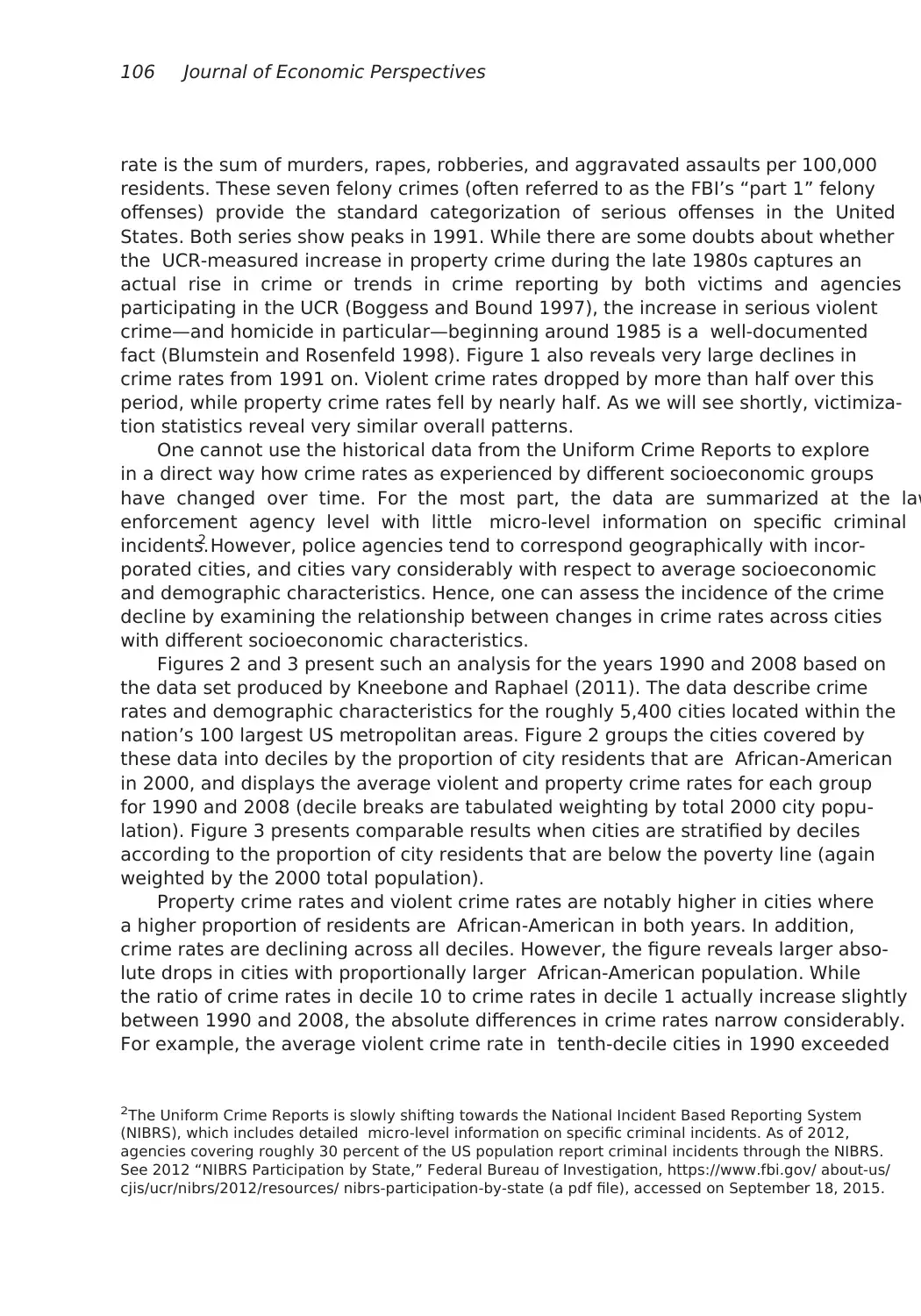
106 Journal of Economic Perspectives
rate is the sum of murders, rapes, robberies, and aggravated assaults per 100,000
residents. These seven felony crimes (often referred to as the FBI’s “part 1” felony
offenses) provide the standard categorization of serious offenses in the United
States. Both series show peaks in 1991. While there are some doubts about whether
the UCR-measured increase in property crime during the late 1980s captures an
actual rise in crime or trends in crime reporting by both victims and agencies
participating in the UCR (Boggess and Bound 1997), the increase in serious violent
crime—and homicide in particular—beginning around 1985 is a well-documented
fact (Blumstein and Rosenfeld 1998). Figure 1 also reveals very large declines in
crime rates from 1991 on. Violent crime rates dropped by more than half over this
period, while property crime rates fell by nearly half. As we will see shortly, victimiza-
tion statistics reveal very similar overall patterns.
One cannot use the historical data from the Uniform Crime Reports to explore
in a direct way how crime rates as experienced by different socioeconomic groups
have changed over time. For the most part, the data are summarized at the law
enforcement agency level with little micro-level information on specific criminal
incidents.2 However, police agencies tend to correspond geographically with incor-
porated cities, and cities vary considerably with respect to average socioeconomic
and demographic characteristics. Hence, one can assess the incidence of the crime
decline by examining the relationship between changes in crime rates across cities
with different socioeconomic characteristics.
Figures 2 and 3 present such an analysis for the years 1990 and 2008 based on
the data set produced by Kneebone and Raphael (2011). The data describe crime
rates and demographic characteristics for the roughly 5,400 cities located within the
nation’s 100 largest US metropolitan areas. Figure 2 groups the cities covered by
these data into deciles by the proportion of city residents that are African-American
in 2000, and displays the average violent and property crime rates for each group
for 1990 and 2008 (decile breaks are tabulated weighting by total 2000 city popu-
lation). Figure 3 presents comparable results when cities are stratified by deciles
according to the proportion of city residents that are below the poverty line (again
weighted by the 2000 total population).
Property crime rates and violent crime rates are notably higher in cities where
a higher proportion of residents are African-American in both years. In addition,
crime rates are declining across all deciles. However, the figure reveals larger abso-
lute drops in cities with proportionally larger African-American population. While
the ratio of crime rates in decile 10 to crime rates in decile 1 actually increase slightly
between 1990 and 2008, the absolute differences in crime rates narrow considerably.
For example, the average violent crime rate in tenth-decile cities in 1990 exceeded
2The Uniform Crime Reports is slowly shifting towards the National Incident Based Reporting System
(NIBRS), which includes detailed micro-level information on specific criminal incidents. As of 2012,
agencies covering roughly 30 percent of the US population report criminal incidents through the NIBRS.
See 2012 “NIBRS Participation by State,” Federal Bureau of Investigation, https://www.fbi.gov/ about-us/
cjis/ucr/nibrs/2012/resources/ nibrs-participation-by-state (a pdf file), accessed on September 18, 2015.
rate is the sum of murders, rapes, robberies, and aggravated assaults per 100,000
residents. These seven felony crimes (often referred to as the FBI’s “part 1” felony
offenses) provide the standard categorization of serious offenses in the United
States. Both series show peaks in 1991. While there are some doubts about whether
the UCR-measured increase in property crime during the late 1980s captures an
actual rise in crime or trends in crime reporting by both victims and agencies
participating in the UCR (Boggess and Bound 1997), the increase in serious violent
crime—and homicide in particular—beginning around 1985 is a well-documented
fact (Blumstein and Rosenfeld 1998). Figure 1 also reveals very large declines in
crime rates from 1991 on. Violent crime rates dropped by more than half over this
period, while property crime rates fell by nearly half. As we will see shortly, victimiza-
tion statistics reveal very similar overall patterns.
One cannot use the historical data from the Uniform Crime Reports to explore
in a direct way how crime rates as experienced by different socioeconomic groups
have changed over time. For the most part, the data are summarized at the law
enforcement agency level with little micro-level information on specific criminal
incidents.2 However, police agencies tend to correspond geographically with incor-
porated cities, and cities vary considerably with respect to average socioeconomic
and demographic characteristics. Hence, one can assess the incidence of the crime
decline by examining the relationship between changes in crime rates across cities
with different socioeconomic characteristics.
Figures 2 and 3 present such an analysis for the years 1990 and 2008 based on
the data set produced by Kneebone and Raphael (2011). The data describe crime
rates and demographic characteristics for the roughly 5,400 cities located within the
nation’s 100 largest US metropolitan areas. Figure 2 groups the cities covered by
these data into deciles by the proportion of city residents that are African-American
in 2000, and displays the average violent and property crime rates for each group
for 1990 and 2008 (decile breaks are tabulated weighting by total 2000 city popu-
lation). Figure 3 presents comparable results when cities are stratified by deciles
according to the proportion of city residents that are below the poverty line (again
weighted by the 2000 total population).
Property crime rates and violent crime rates are notably higher in cities where
a higher proportion of residents are African-American in both years. In addition,
crime rates are declining across all deciles. However, the figure reveals larger abso-
lute drops in cities with proportionally larger African-American population. While
the ratio of crime rates in decile 10 to crime rates in decile 1 actually increase slightly
between 1990 and 2008, the absolute differences in crime rates narrow considerably.
For example, the average violent crime rate in tenth-decile cities in 1990 exceeded
2The Uniform Crime Reports is slowly shifting towards the National Incident Based Reporting System
(NIBRS), which includes detailed micro-level information on specific criminal incidents. As of 2012,
agencies covering roughly 30 percent of the US population report criminal incidents through the NIBRS.
See 2012 “NIBRS Participation by State,” Federal Bureau of Investigation, https://www.fbi.gov/ about-us/
cjis/ucr/nibrs/2012/resources/ nibrs-participation-by-state (a pdf file), accessed on September 18, 2015.
Secure Best Marks with AI Grader
Need help grading? Try our AI Grader for instant feedback on your assignments.
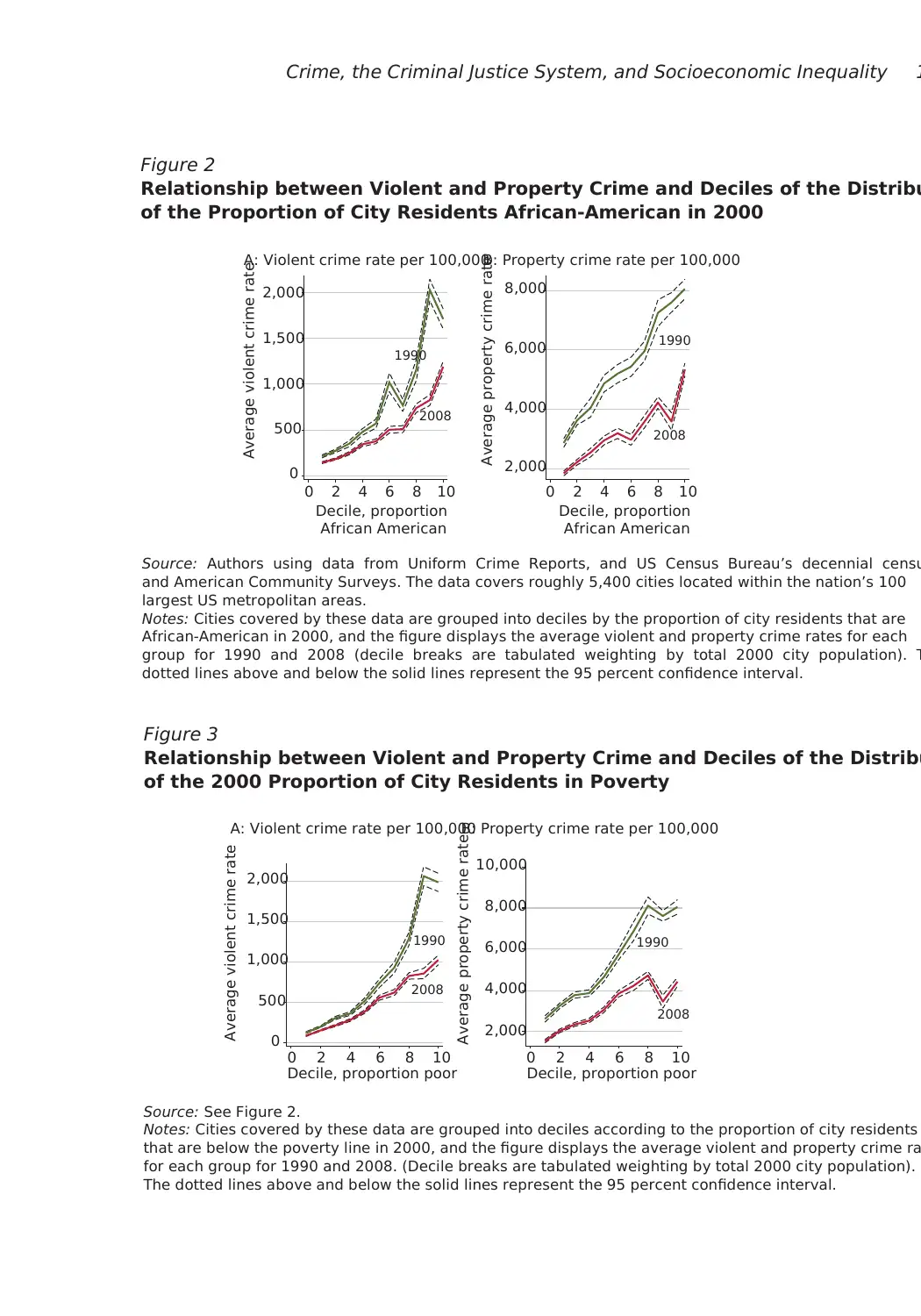
Crime, the Criminal Justice System, and Socioeconomic Inequality 1
Figure 2
Relationship between Violent and Property Crime and Deciles of the Distribu
of the Proportion of City Residents African-American in 2000
Source: Authors using data from Uniform Crime Reports, and US Census Bureau’s decennial censu
and American Community Surveys. The data covers roughly 5,400 cities located within the nation’s 100
largest US metropolitan areas.
Notes: Cities covered by these data are grouped into deciles by the proportion of city residents that are
African-American in 2000, and the figure displays the average violent and property crime rates for each
group for 1990 and 2008 (decile breaks are tabulated weighting by total 2000 city population). T
dotted lines above and below the solid lines represent the 95 percent confidence interval.
A: Violent crime rate per 100,000B: Property crime rate per 100,000
1990
2008
0
500
1,000
1,500
2,000
Average violent crime rate
0 2 4 6 8 10
Decile, proportion
African American
1990
2008
2,000
4,000
6,000
8,000
Average property crime rate
0 2 4 6 8 10
Decile, proportion
African American
Figure 3
Relationship between Violent and Property Crime and Deciles of the Distribu
of the 2000 Proportion of City Residents in Poverty
Source: See Figure 2.
Notes: Cities covered by these data are grouped into deciles according to the proportion of city residents
that are below the poverty line in 2000, and the figure displays the average violent and property crime ra
for each group for 1990 and 2008. (Decile breaks are tabulated weighting by total 2000 city population).
The dotted lines above and below the solid lines represent the 95 percent confidence interval.
1990
2008
0
500
1,000
1,500
2,000
Average violent crime rate
0 2 4 6 8 10
Decile, proportion poor
1990
2008
2,000
4,000
6,000
8,000
10,000
Average property crime rate
0 2 4 6 8 10
Decile, proportion poor
A: Violent crime rate per 100,000B: Property crime rate per 100,000
Figure 2
Relationship between Violent and Property Crime and Deciles of the Distribu
of the Proportion of City Residents African-American in 2000
Source: Authors using data from Uniform Crime Reports, and US Census Bureau’s decennial censu
and American Community Surveys. The data covers roughly 5,400 cities located within the nation’s 100
largest US metropolitan areas.
Notes: Cities covered by these data are grouped into deciles by the proportion of city residents that are
African-American in 2000, and the figure displays the average violent and property crime rates for each
group for 1990 and 2008 (decile breaks are tabulated weighting by total 2000 city population). T
dotted lines above and below the solid lines represent the 95 percent confidence interval.
A: Violent crime rate per 100,000B: Property crime rate per 100,000
1990
2008
0
500
1,000
1,500
2,000
Average violent crime rate
0 2 4 6 8 10
Decile, proportion
African American
1990
2008
2,000
4,000
6,000
8,000
Average property crime rate
0 2 4 6 8 10
Decile, proportion
African American
Figure 3
Relationship between Violent and Property Crime and Deciles of the Distribu
of the 2000 Proportion of City Residents in Poverty
Source: See Figure 2.
Notes: Cities covered by these data are grouped into deciles according to the proportion of city residents
that are below the poverty line in 2000, and the figure displays the average violent and property crime ra
for each group for 1990 and 2008. (Decile breaks are tabulated weighting by total 2000 city population).
The dotted lines above and below the solid lines represent the 95 percent confidence interval.
1990
2008
0
500
1,000
1,500
2,000
Average violent crime rate
0 2 4 6 8 10
Decile, proportion poor
1990
2008
2,000
4,000
6,000
8,000
10,000
Average property crime rate
0 2 4 6 8 10
Decile, proportion poor
A: Violent crime rate per 100,000B: Property crime rate per 100,000
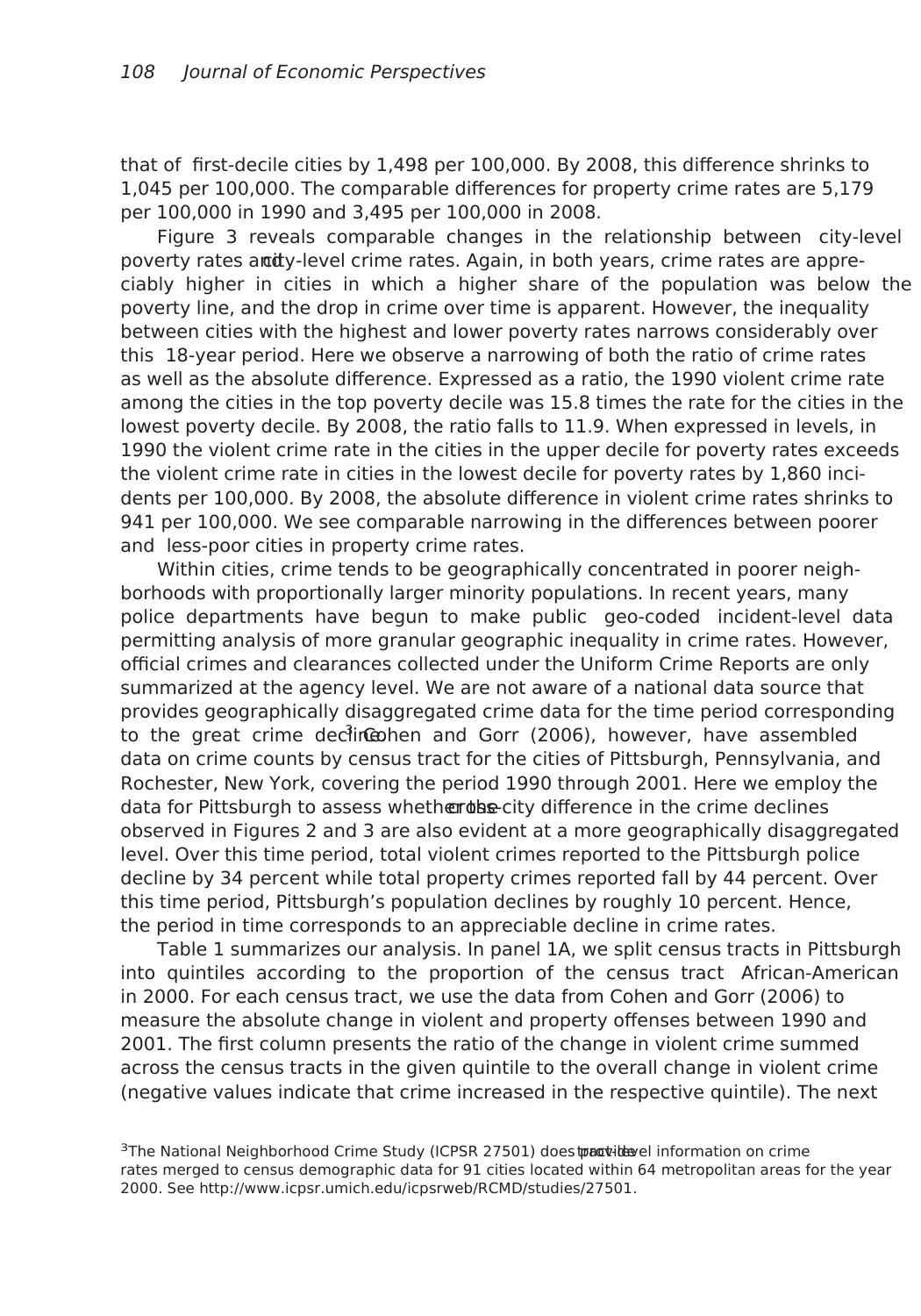
108 Journal of Economic Perspectives
that of first-decile cities by 1,498 per 100,000. By 2008, this difference shrinks to
1,045 per 100,000. The comparable differences for property crime rates are 5,179
per 100,000 in 1990 and 3,495 per 100,000 in 2008.
Figure 3 reveals comparable changes in the relationship between city-level
poverty rates andcity-level crime rates. Again, in both years, crime rates are appre-
ciably higher in cities in which a higher share of the population was below the
poverty line, and the drop in crime over time is apparent. However, the inequality
between cities with the highest and lower poverty rates narrows considerably over
this 18-year period. Here we observe a narrowing of both the ratio of crime rates
as well as the absolute difference. Expressed as a ratio, the 1990 violent crime rate
among the cities in the top poverty decile was 15.8 times the rate for the cities in the
lowest poverty decile. By 2008, the ratio falls to 11.9. When expressed in levels, in
1990 the violent crime rate in the cities in the upper decile for poverty rates exceeds
the violent crime rate in cities in the lowest decile for poverty rates by 1,860 inci-
dents per 100,000. By 2008, the absolute difference in violent crime rates shrinks to
941 per 100,000. We see comparable narrowing in the differences between poorer
and less-poor cities in property crime rates.
Within cities, crime tends to be geographically concentrated in poorer neigh-
borhoods with proportionally larger minority populations. In recent years, many
police departments have begun to make public geo-coded incident-level data
permitting analysis of more granular geographic inequality in crime rates. However,
official crimes and clearances collected under the Uniform Crime Reports are only
summarized at the agency level. We are not aware of a national data source that
provides geographically disaggregated crime data for the time period corresponding
to the great crime decline.3 Cohen and Gorr (2006), however, have assembled
data on crime counts by census tract for the cities of Pittsburgh, Pennsylvania, and
Rochester, New York, covering the period 1990 through 2001. Here we employ the
data for Pittsburgh to assess whether thecross-city difference in the crime declines
observed in Figures 2 and 3 are also evident at a more geographically disaggregated
level. Over this time period, total violent crimes reported to the Pittsburgh police
decline by 34 percent while total property crimes reported fall by 44 percent. Over
this time period, Pittsburgh’s population declines by roughly 10 percent. Hence,
the period in time corresponds to an appreciable decline in crime rates.
Table 1 summarizes our analysis. In panel 1A, we split census tracts in Pittsburgh
into quintiles according to the proportion of the census tract African-American
in 2000. For each census tract, we use the data from Cohen and Gorr (2006) to
measure the absolute change in violent and property offenses between 1990 and
2001. The first column presents the ratio of the change in violent crime summed
across the census tracts in the given quintile to the overall change in violent crime
(negative values indicate that crime increased in the respective quintile). The next
3The National Neighborhood Crime Study (ICPSR 27501) does providetract-level information on crime
rates merged to census demographic data for 91 cities located within 64 metropolitan areas for the year
2000. See http://www.icpsr.umich.edu/icpsrweb/RCMD/studies/27501.
that of first-decile cities by 1,498 per 100,000. By 2008, this difference shrinks to
1,045 per 100,000. The comparable differences for property crime rates are 5,179
per 100,000 in 1990 and 3,495 per 100,000 in 2008.
Figure 3 reveals comparable changes in the relationship between city-level
poverty rates andcity-level crime rates. Again, in both years, crime rates are appre-
ciably higher in cities in which a higher share of the population was below the
poverty line, and the drop in crime over time is apparent. However, the inequality
between cities with the highest and lower poverty rates narrows considerably over
this 18-year period. Here we observe a narrowing of both the ratio of crime rates
as well as the absolute difference. Expressed as a ratio, the 1990 violent crime rate
among the cities in the top poverty decile was 15.8 times the rate for the cities in the
lowest poverty decile. By 2008, the ratio falls to 11.9. When expressed in levels, in
1990 the violent crime rate in the cities in the upper decile for poverty rates exceeds
the violent crime rate in cities in the lowest decile for poverty rates by 1,860 inci-
dents per 100,000. By 2008, the absolute difference in violent crime rates shrinks to
941 per 100,000. We see comparable narrowing in the differences between poorer
and less-poor cities in property crime rates.
Within cities, crime tends to be geographically concentrated in poorer neigh-
borhoods with proportionally larger minority populations. In recent years, many
police departments have begun to make public geo-coded incident-level data
permitting analysis of more granular geographic inequality in crime rates. However,
official crimes and clearances collected under the Uniform Crime Reports are only
summarized at the agency level. We are not aware of a national data source that
provides geographically disaggregated crime data for the time period corresponding
to the great crime decline.3 Cohen and Gorr (2006), however, have assembled
data on crime counts by census tract for the cities of Pittsburgh, Pennsylvania, and
Rochester, New York, covering the period 1990 through 2001. Here we employ the
data for Pittsburgh to assess whether thecross-city difference in the crime declines
observed in Figures 2 and 3 are also evident at a more geographically disaggregated
level. Over this time period, total violent crimes reported to the Pittsburgh police
decline by 34 percent while total property crimes reported fall by 44 percent. Over
this time period, Pittsburgh’s population declines by roughly 10 percent. Hence,
the period in time corresponds to an appreciable decline in crime rates.
Table 1 summarizes our analysis. In panel 1A, we split census tracts in Pittsburgh
into quintiles according to the proportion of the census tract African-American
in 2000. For each census tract, we use the data from Cohen and Gorr (2006) to
measure the absolute change in violent and property offenses between 1990 and
2001. The first column presents the ratio of the change in violent crime summed
across the census tracts in the given quintile to the overall change in violent crime
(negative values indicate that crime increased in the respective quintile). The next
3The National Neighborhood Crime Study (ICPSR 27501) does providetract-level information on crime
rates merged to census demographic data for 91 cities located within 64 metropolitan areas for the year
2000. See http://www.icpsr.umich.edu/icpsrweb/RCMD/studies/27501.
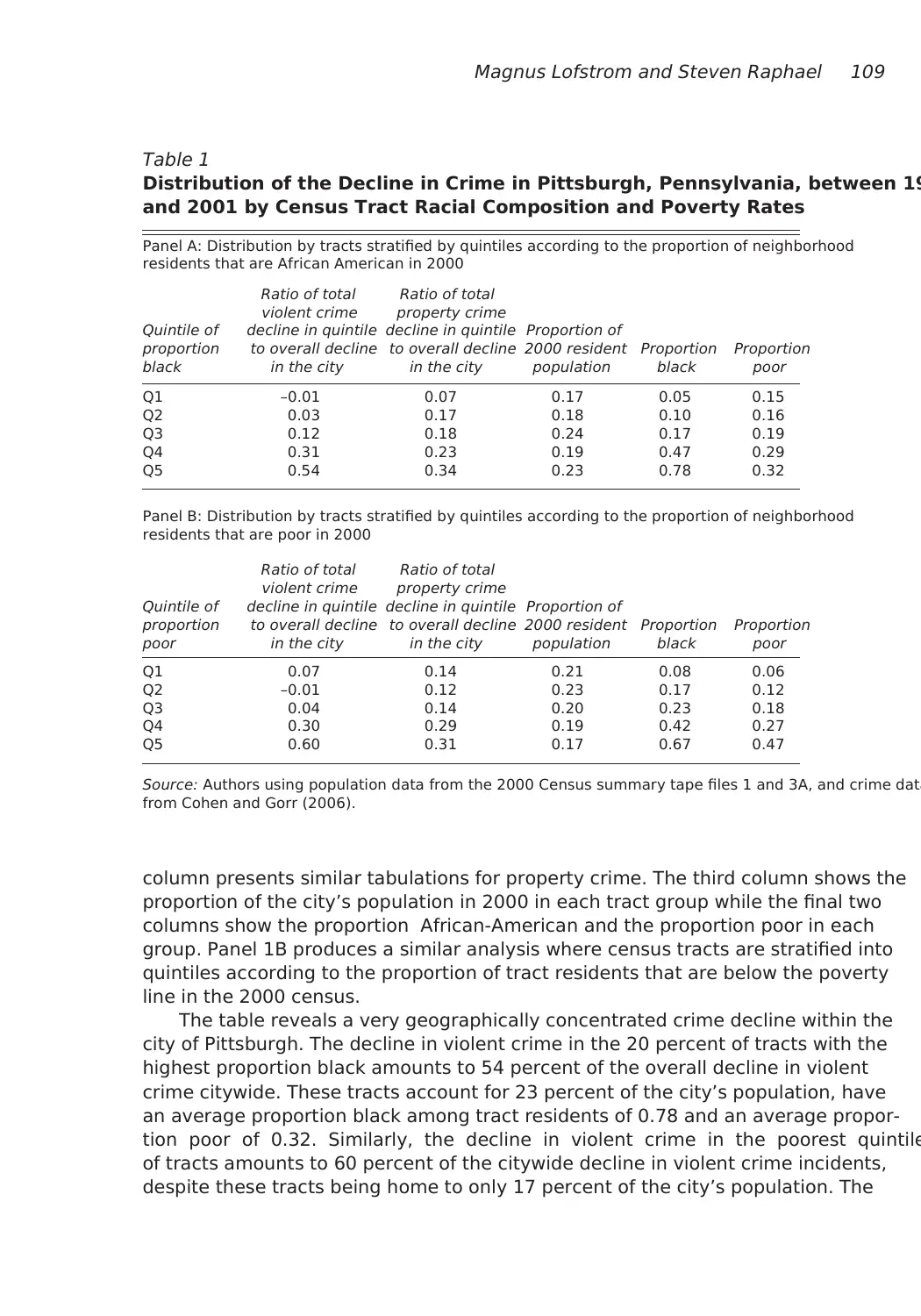
Magnus Lofstrom and Steven Raphael 109
column presents similar tabulations for property crime. The third column shows the
proportion of the city’s population in 2000 in each tract group while the final two
columns show the proportion African-American and the proportion poor in each
group. Panel 1B produces a similar analysis where census tracts are stratified into
quintiles according to the proportion of tract residents that are below the poverty
line in the 2000 census.
The table reveals a very geographically concentrated crime decline within the
city of Pittsburgh. The decline in violent crime in the 20 percent of tracts with the
highest proportion black amounts to 54 percent of the overall decline in violent
crime citywide. These tracts account for 23 percent of the city’s population, have
an average proportion black among tract residents of 0.78 and an average propor-
tion poor of 0.32. Similarly, the decline in violent crime in the poorest quintile
of tracts amounts to 60 percent of the citywide decline in violent crime incidents,
despite these tracts being home to only 17 percent of the city’s population. The
Table 1
Distribution of the Decline in Crime in Pittsburgh, Pennsylvania, between 19
and 2001 by Census Tract Racial Composition and Poverty Rates
Panel A: Distribution by tracts stratified by quintiles according to the proportion of neighborhood
residents that are African American in 2000
Quintile of
proportion
black
Ratio of total
violent crime
decline in quintile
to overall decline
in the city
Ratio of total
property crime
decline in quintile
to overall decline
in the city
Proportion of
2000 resident
population
Proportion
black
Proportion
poor
Q1 –0.01 0.07 0.17 0.05 0.15
Q2 0.03 0.17 0.18 0.10 0.16
Q3 0.12 0.18 0.24 0.17 0.19
Q4 0.31 0.23 0.19 0.47 0.29
Q5 0.54 0.34 0.23 0.78 0.32
Panel B: Distribution by tracts stratified by quintiles according to the proportion of neighborhood
residents that are poor in 2000
Quintile of
proportion
poor
Ratio of total
violent crime
decline in quintile
to overall decline
in the city
Ratio of total
property crime
decline in quintile
to overall decline
in the city
Proportion of
2000 resident
population
Proportion
black
Proportion
poor
Q1 0.07 0.14 0.21 0.08 0.06
Q2 –0.01 0.12 0.23 0.17 0.12
Q3 0.04 0.14 0.20 0.23 0.18
Q4 0.30 0.29 0.19 0.42 0.27
Q5 0.60 0.31 0.17 0.67 0.47
Source: Authors using population data from the 2000 Census summary tape files 1 and 3A, and crime data
from Cohen and Gorr (2006).
column presents similar tabulations for property crime. The third column shows the
proportion of the city’s population in 2000 in each tract group while the final two
columns show the proportion African-American and the proportion poor in each
group. Panel 1B produces a similar analysis where census tracts are stratified into
quintiles according to the proportion of tract residents that are below the poverty
line in the 2000 census.
The table reveals a very geographically concentrated crime decline within the
city of Pittsburgh. The decline in violent crime in the 20 percent of tracts with the
highest proportion black amounts to 54 percent of the overall decline in violent
crime citywide. These tracts account for 23 percent of the city’s population, have
an average proportion black among tract residents of 0.78 and an average propor-
tion poor of 0.32. Similarly, the decline in violent crime in the poorest quintile
of tracts amounts to 60 percent of the citywide decline in violent crime incidents,
despite these tracts being home to only 17 percent of the city’s population. The
Table 1
Distribution of the Decline in Crime in Pittsburgh, Pennsylvania, between 19
and 2001 by Census Tract Racial Composition and Poverty Rates
Panel A: Distribution by tracts stratified by quintiles according to the proportion of neighborhood
residents that are African American in 2000
Quintile of
proportion
black
Ratio of total
violent crime
decline in quintile
to overall decline
in the city
Ratio of total
property crime
decline in quintile
to overall decline
in the city
Proportion of
2000 resident
population
Proportion
black
Proportion
poor
Q1 –0.01 0.07 0.17 0.05 0.15
Q2 0.03 0.17 0.18 0.10 0.16
Q3 0.12 0.18 0.24 0.17 0.19
Q4 0.31 0.23 0.19 0.47 0.29
Q5 0.54 0.34 0.23 0.78 0.32
Panel B: Distribution by tracts stratified by quintiles according to the proportion of neighborhood
residents that are poor in 2000
Quintile of
proportion
poor
Ratio of total
violent crime
decline in quintile
to overall decline
in the city
Ratio of total
property crime
decline in quintile
to overall decline
in the city
Proportion of
2000 resident
population
Proportion
black
Proportion
poor
Q1 0.07 0.14 0.21 0.08 0.06
Q2 –0.01 0.12 0.23 0.17 0.12
Q3 0.04 0.14 0.20 0.23 0.18
Q4 0.30 0.29 0.19 0.42 0.27
Q5 0.60 0.31 0.17 0.67 0.47
Source: Authors using population data from the 2000 Census summary tape files 1 and 3A, and crime data
from Cohen and Gorr (2006).
Paraphrase This Document
Need a fresh take? Get an instant paraphrase of this document with our AI Paraphraser
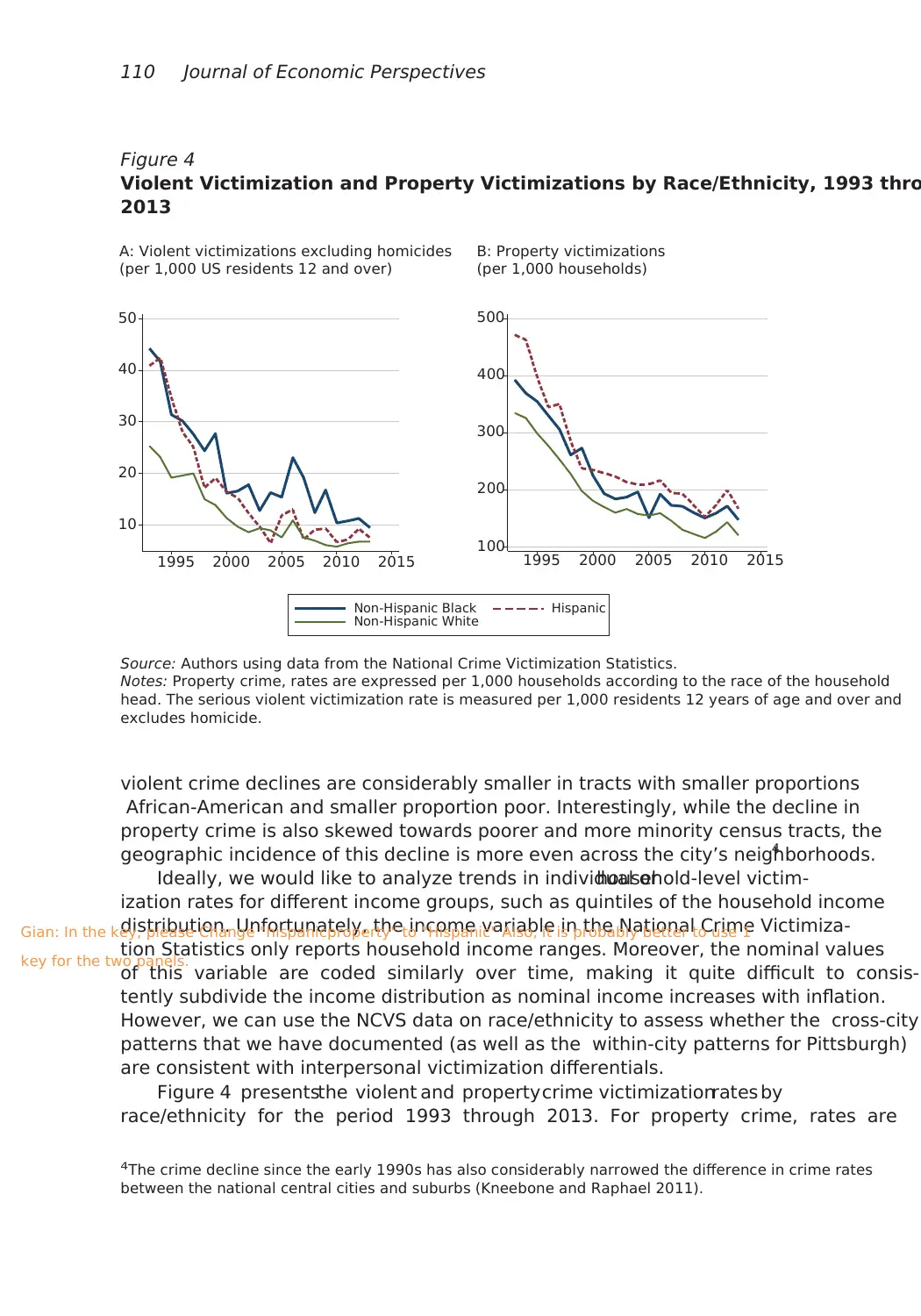
110 Journal of Economic Perspectives
violent crime declines are considerably smaller in tracts with smaller proportions
African-American and smaller proportion poor. Interestingly, while the decline in
property crime is also skewed towards poorer and more minority census tracts, the
geographic incidence of this decline is more even across the city’s neighborhoods.4
Ideally, we would like to analyze trends in individual orhousehold-level victim-
ization rates for different income groups, such as quintiles of the household income
distribution. Unfortunately, the income variable in the National Crime Victimiza-
tion Statistics only reports household income ranges. Moreover, the nominal values
of this variable are coded similarly over time, making it quite difficult to consis-
tently subdivide the income distribution as nominal income increases with inflation.
However, we can use the NCVS data on race/ethnicity to assess whether the cross-city
patterns that we have documented (as well as the within-city patterns for Pittsburgh)
are consistent with interpersonal victimization differentials.
Figure 4 presentsthe violent and property crime victimizationrates by
race/ethnicity for the period 1993 through 2013. For property crime, rates are
4The crime decline since the early 1990s has also considerably narrowed the difference in crime rates
between the national central cities and suburbs (Kneebone and Raphael 2011).
Figure 4
Violent Victimization and Property Victimizations by Race/Ethnicity, 1993 thro
2013
Source: Authors using data from the National Crime Victimization Statistics.
Notes: Property crime, rates are expressed per 1,000 households according to the race of the household
head. The serious violent victimization rate is measured per 1,000 residents 12 years of age and over and
excludes homicide.
A: Violent victimizations excluding homicides
(per 1,000 US residents 12 and over)
B: Property victimizations
(per 1,000 households)
Gian: In the key, please Change "hispanicproperty" to "Hispanic" Also, it is probably better to use 1
key for the two panels.
10
20
30
40
50
1995 2000 2005 2010 2015
Non-Hispanic Black Hispanic
Non-Hispanic White
100
200
300
400
500
1995 2000 2005 2010 2015
violent crime declines are considerably smaller in tracts with smaller proportions
African-American and smaller proportion poor. Interestingly, while the decline in
property crime is also skewed towards poorer and more minority census tracts, the
geographic incidence of this decline is more even across the city’s neighborhoods.4
Ideally, we would like to analyze trends in individual orhousehold-level victim-
ization rates for different income groups, such as quintiles of the household income
distribution. Unfortunately, the income variable in the National Crime Victimiza-
tion Statistics only reports household income ranges. Moreover, the nominal values
of this variable are coded similarly over time, making it quite difficult to consis-
tently subdivide the income distribution as nominal income increases with inflation.
However, we can use the NCVS data on race/ethnicity to assess whether the cross-city
patterns that we have documented (as well as the within-city patterns for Pittsburgh)
are consistent with interpersonal victimization differentials.
Figure 4 presentsthe violent and property crime victimizationrates by
race/ethnicity for the period 1993 through 2013. For property crime, rates are
4The crime decline since the early 1990s has also considerably narrowed the difference in crime rates
between the national central cities and suburbs (Kneebone and Raphael 2011).
Figure 4
Violent Victimization and Property Victimizations by Race/Ethnicity, 1993 thro
2013
Source: Authors using data from the National Crime Victimization Statistics.
Notes: Property crime, rates are expressed per 1,000 households according to the race of the household
head. The serious violent victimization rate is measured per 1,000 residents 12 years of age and over and
excludes homicide.
A: Violent victimizations excluding homicides
(per 1,000 US residents 12 and over)
B: Property victimizations
(per 1,000 households)
Gian: In the key, please Change "hispanicproperty" to "Hispanic" Also, it is probably better to use 1
key for the two panels.
10
20
30
40
50
1995 2000 2005 2010 2015
Non-Hispanic Black Hispanic
Non-Hispanic White
100
200
300
400
500
1995 2000 2005 2010 2015
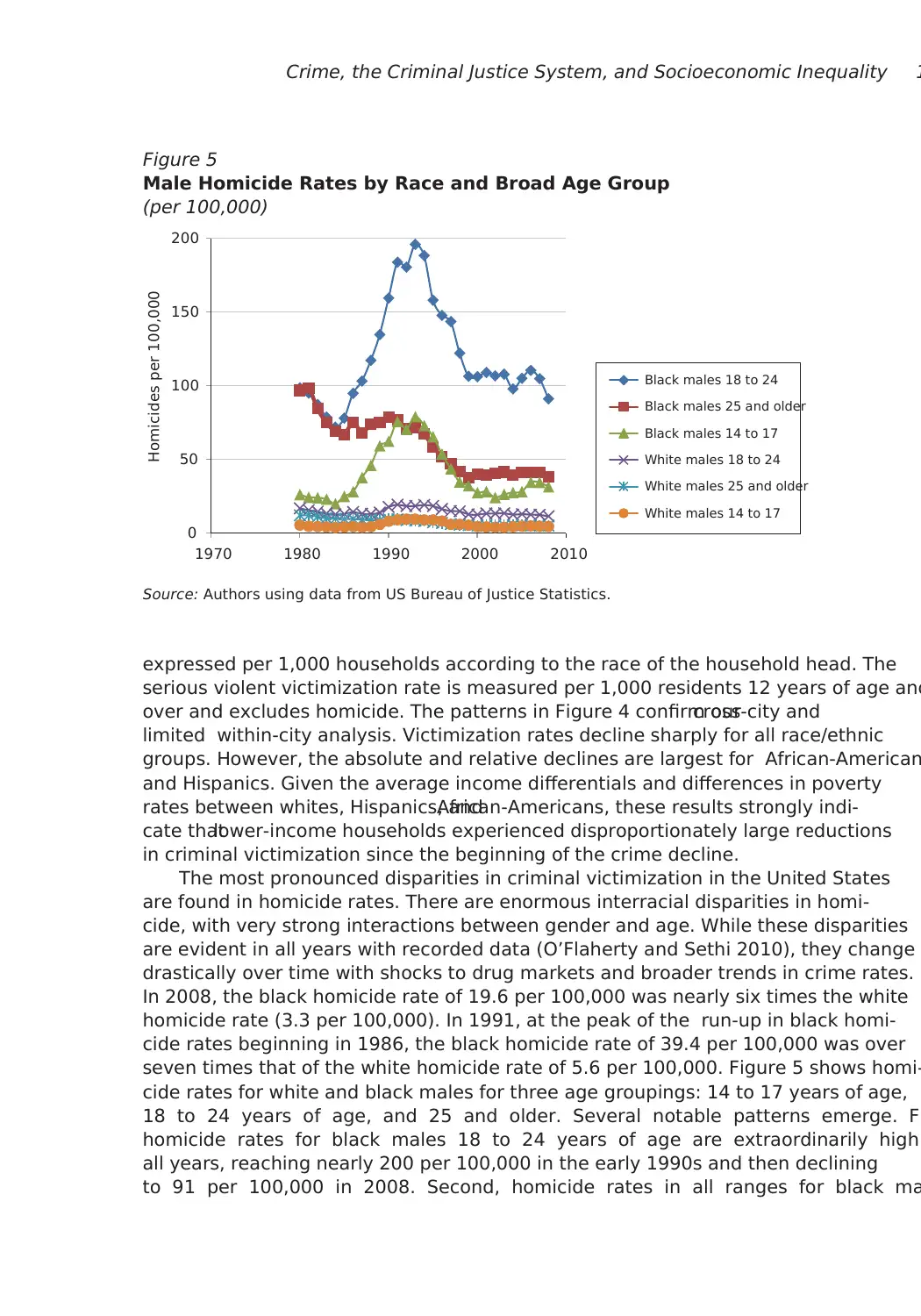
Crime, the Criminal Justice System, and Socioeconomic Inequality 1
expressed per 1,000 households according to the race of the household head. The
serious violent victimization rate is measured per 1,000 residents 12 years of age and
over and excludes homicide. The patterns in Figure 4 confirm ourcross-city and
limited within-city analysis. Victimization rates decline sharply for all race/ethnic
groups. However, the absolute and relative declines are largest for African-American
and Hispanics. Given the average income differentials and differences in poverty
rates between whites, Hispanics, andAfrican-Americans, these results strongly indi-
cate thatlower-income households experienced disproportionately large reductions
in criminal victimization since the beginning of the crime decline.
The most pronounced disparities in criminal victimization in the United States
are found in homicide rates. There are enormous interracial disparities in homi-
cide, with very strong interactions between gender and age. While these disparities
are evident in all years with recorded data (O’Flaherty and Sethi 2010), they change
drastically over time with shocks to drug markets and broader trends in crime rates.
In 2008, the black homicide rate of 19.6 per 100,000 was nearly six times the white
homicide rate (3.3 per 100,000). In 1991, at the peak of the run-up in black homi-
cide rates beginning in 1986, the black homicide rate of 39.4 per 100,000 was over
seven times that of the white homicide rate of 5.6 per 100,000. Figure 5 shows homi-
cide rates for white and black males for three age groupings: 14 to 17 years of age,
18 to 24 years of age, and 25 and older. Several notable patterns emerge. Fi
homicide rates for black males 18 to 24 years of age are extraordinarily high
all years, reaching nearly 200 per 100,000 in the early 1990s and then declining
to 91 per 100,000 in 2008. Second, homicide rates in all ranges for black ma
Figure 5
Male Homicide Rates by Race and Broad Age Group
(per 100,000)
Source: Authors using data from US Bureau of Justice Statistics.
0
50
100
150
200
1970 1980 1990 2000 2010
Black males 18 to 24
Black males 25 and older
Black males 14 to 17
White males 18 to 24
White males 25 and older
White males 14 to 17
Homicides per 100,000
expressed per 1,000 households according to the race of the household head. The
serious violent victimization rate is measured per 1,000 residents 12 years of age and
over and excludes homicide. The patterns in Figure 4 confirm ourcross-city and
limited within-city analysis. Victimization rates decline sharply for all race/ethnic
groups. However, the absolute and relative declines are largest for African-American
and Hispanics. Given the average income differentials and differences in poverty
rates between whites, Hispanics, andAfrican-Americans, these results strongly indi-
cate thatlower-income households experienced disproportionately large reductions
in criminal victimization since the beginning of the crime decline.
The most pronounced disparities in criminal victimization in the United States
are found in homicide rates. There are enormous interracial disparities in homi-
cide, with very strong interactions between gender and age. While these disparities
are evident in all years with recorded data (O’Flaherty and Sethi 2010), they change
drastically over time with shocks to drug markets and broader trends in crime rates.
In 2008, the black homicide rate of 19.6 per 100,000 was nearly six times the white
homicide rate (3.3 per 100,000). In 1991, at the peak of the run-up in black homi-
cide rates beginning in 1986, the black homicide rate of 39.4 per 100,000 was over
seven times that of the white homicide rate of 5.6 per 100,000. Figure 5 shows homi-
cide rates for white and black males for three age groupings: 14 to 17 years of age,
18 to 24 years of age, and 25 and older. Several notable patterns emerge. Fi
homicide rates for black males 18 to 24 years of age are extraordinarily high
all years, reaching nearly 200 per 100,000 in the early 1990s and then declining
to 91 per 100,000 in 2008. Second, homicide rates in all ranges for black ma
Figure 5
Male Homicide Rates by Race and Broad Age Group
(per 100,000)
Source: Authors using data from US Bureau of Justice Statistics.
0
50
100
150
200
1970 1980 1990 2000 2010
Black males 18 to 24
Black males 25 and older
Black males 14 to 17
White males 18 to 24
White males 25 and older
White males 14 to 17
Homicides per 100,000
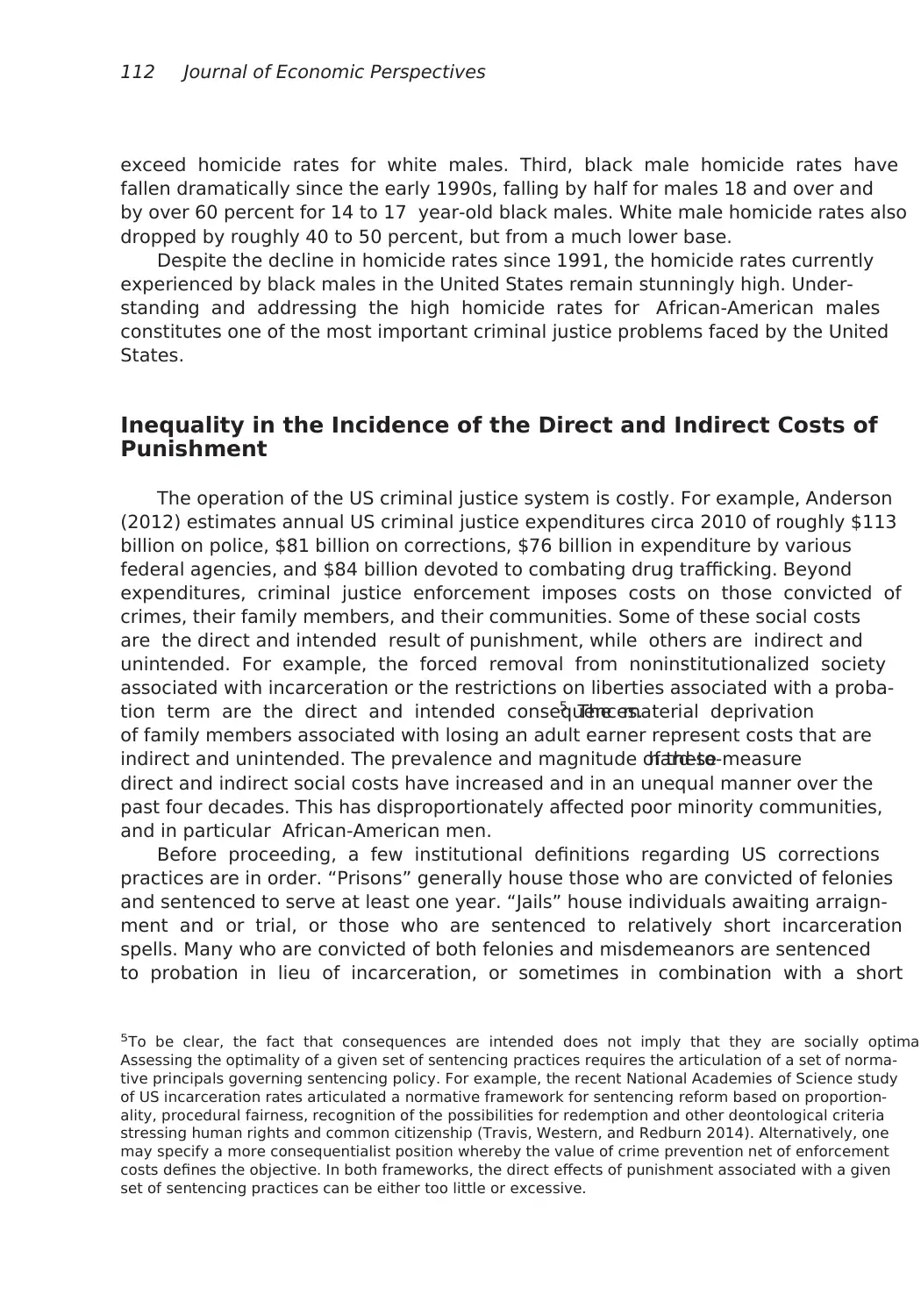
112 Journal of Economic Perspectives
exceed homicide rates for white males. Third, black male homicide rates have
fallen dramatically since the early 1990s, falling by half for males 18 and over and
by over 60 percent for 14 to 17 year-old black males. White male homicide rates also
dropped by roughly 40 to 50 percent, but from a much lower base.
Despite the decline in homicide rates since 1991, the homicide rates currently
experienced by black males in the United States remain stunningly high. Under-
standing and addressing the high homicide rates for African-American males
constitutes one of the most important criminal justice problems faced by the United
States.
Inequality in the Incidence of the Direct and Indirect Costs of
Punishment
The operation of the US criminal justice system is costly. For example, Anderson
(2012) estimates annual US criminal justice expenditures circa 2010 of roughly $113
billion on police, $81 billion on corrections, $76 billion in expenditure by various
federal agencies, and $84 billion devoted to combating drug trafficking. Beyond
expenditures, criminal justice enforcement imposes costs on those convicted of
crimes, their family members, and their communities. Some of these social costs
are the direct and intended result of punishment, while others are indirect and
unintended. For example, the forced removal from noninstitutionalized society
associated with incarceration or the restrictions on liberties associated with a proba-
tion term are the direct and intended consequences.5 The material deprivation
of family members associated with losing an adult earner represent costs that are
indirect and unintended. The prevalence and magnitude of thesehard-to-measure
direct and indirect social costs have increased and in an unequal manner over the
past four decades. This has disproportionately affected poor minority communities,
and in particular African-American men.
Before proceeding, a few institutional definitions regarding US corrections
practices are in order. “Prisons” generally house those who are convicted of felonies
and sentenced to serve at least one year. “Jails” house individuals awaiting arraign-
ment and or trial, or those who are sentenced to relatively short incarceration
spells. Many who are convicted of both felonies and misdemeanors are sentenced
to probation in lieu of incarceration, or sometimes in combination with a short
5To be clear, the fact that consequences are intended does not imply that they are socially optimal
Assessing the optimality of a given set of sentencing practices requires the articulation of a set of norma-
tive principals governing sentencing policy. For example, the recent National Academies of Science study
of US incarceration rates articulated a normative framework for sentencing reform based on proportion-
ality, procedural fairness, recognition of the possibilities for redemption and other deontological criteria
stressing human rights and common citizenship (Travis, Western, and Redburn 2014). Alternatively, one
may specify a more consequentialist position whereby the value of crime prevention net of enforcement
costs defines the objective. In both frameworks, the direct effects of punishment associated with a given
set of sentencing practices can be either too little or excessive.
exceed homicide rates for white males. Third, black male homicide rates have
fallen dramatically since the early 1990s, falling by half for males 18 and over and
by over 60 percent for 14 to 17 year-old black males. White male homicide rates also
dropped by roughly 40 to 50 percent, but from a much lower base.
Despite the decline in homicide rates since 1991, the homicide rates currently
experienced by black males in the United States remain stunningly high. Under-
standing and addressing the high homicide rates for African-American males
constitutes one of the most important criminal justice problems faced by the United
States.
Inequality in the Incidence of the Direct and Indirect Costs of
Punishment
The operation of the US criminal justice system is costly. For example, Anderson
(2012) estimates annual US criminal justice expenditures circa 2010 of roughly $113
billion on police, $81 billion on corrections, $76 billion in expenditure by various
federal agencies, and $84 billion devoted to combating drug trafficking. Beyond
expenditures, criminal justice enforcement imposes costs on those convicted of
crimes, their family members, and their communities. Some of these social costs
are the direct and intended result of punishment, while others are indirect and
unintended. For example, the forced removal from noninstitutionalized society
associated with incarceration or the restrictions on liberties associated with a proba-
tion term are the direct and intended consequences.5 The material deprivation
of family members associated with losing an adult earner represent costs that are
indirect and unintended. The prevalence and magnitude of thesehard-to-measure
direct and indirect social costs have increased and in an unequal manner over the
past four decades. This has disproportionately affected poor minority communities,
and in particular African-American men.
Before proceeding, a few institutional definitions regarding US corrections
practices are in order. “Prisons” generally house those who are convicted of felonies
and sentenced to serve at least one year. “Jails” house individuals awaiting arraign-
ment and or trial, or those who are sentenced to relatively short incarceration
spells. Many who are convicted of both felonies and misdemeanors are sentenced
to probation in lieu of incarceration, or sometimes in combination with a short
5To be clear, the fact that consequences are intended does not imply that they are socially optimal
Assessing the optimality of a given set of sentencing practices requires the articulation of a set of norma-
tive principals governing sentencing policy. For example, the recent National Academies of Science study
of US incarceration rates articulated a normative framework for sentencing reform based on proportion-
ality, procedural fairness, recognition of the possibilities for redemption and other deontological criteria
stressing human rights and common citizenship (Travis, Western, and Redburn 2014). Alternatively, one
may specify a more consequentialist position whereby the value of crime prevention net of enforcement
costs defines the objective. In both frameworks, the direct effects of punishment associated with a given
set of sentencing practices can be either too little or excessive.
Secure Best Marks with AI Grader
Need help grading? Try our AI Grader for instant feedback on your assignments.
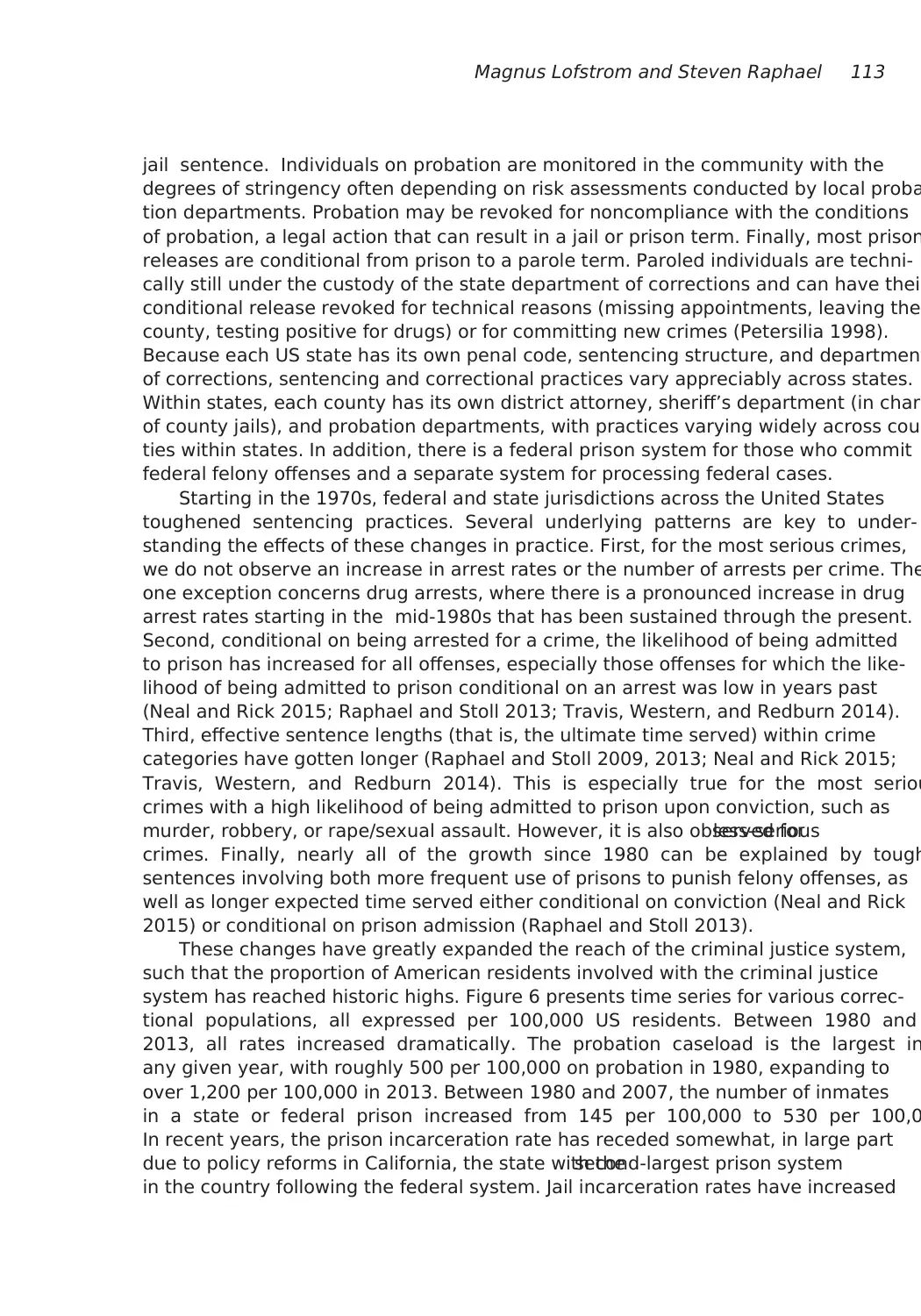
Magnus Lofstrom and Steven Raphael 113
jail sentence. Individuals on probation are monitored in the community with the
degrees of stringency often depending on risk assessments conducted by local proba
tion departments. Probation may be revoked for noncompliance with the conditions
of probation, a legal action that can result in a jail or prison term. Finally, most prison
releases are conditional from prison to a parole term. Paroled individuals are techni-
cally still under the custody of the state department of corrections and can have their
conditional release revoked for technical reasons (missing appointments, leaving the
county, testing positive for drugs) or for committing new crimes (Petersilia 1998).
Because each US state has its own penal code, sentencing structure, and department
of corrections, sentencing and correctional practices vary appreciably across states.
Within states, each county has its own district attorney, sheriff’s department (in charg
of county jails), and probation departments, with practices varying widely across coun
ties within states. In addition, there is a federal prison system for those who commit
federal felony offenses and a separate system for processing federal cases.
Starting in the 1970s, federal and state jurisdictions across the United States
toughened sentencing practices. Several underlying patterns are key to under-
standing the effects of these changes in practice. First, for the most serious crimes,
we do not observe an increase in arrest rates or the number of arrests per crime. The
one exception concerns drug arrests, where there is a pronounced increase in drug
arrest rates starting in the mid-1980s that has been sustained through the present.
Second, conditional on being arrested for a crime, the likelihood of being admitted
to prison has increased for all offenses, especially those offenses for which the like-
lihood of being admitted to prison conditional on an arrest was low in years past
(Neal and Rick 2015; Raphael and Stoll 2013; Travis, Western, and Redburn 2014).
Third, effective sentence lengths (that is, the ultimate time served) within crime
categories have gotten longer (Raphael and Stoll 2009, 2013; Neal and Rick 2015;
Travis, Western, and Redburn 2014). This is especially true for the most seriou
crimes with a high likelihood of being admitted to prison upon conviction, such as
murder, robbery, or rape/sexual assault. However, it is also observed forless-serious
crimes. Finally, nearly all of the growth since 1980 can be explained by tough
sentences involving both more frequent use of prisons to punish felony offenses, as
well as longer expected time served either conditional on conviction (Neal and Rick
2015) or conditional on prison admission (Raphael and Stoll 2013).
These changes have greatly expanded the reach of the criminal justice system,
such that the proportion of American residents involved with the criminal justice
system has reached historic highs. Figure 6 presents time series for various correc-
tional populations, all expressed per 100,000 US residents. Between 1980 and
2013, all rates increased dramatically. The probation caseload is the largest in
any given year, with roughly 500 per 100,000 on probation in 1980, expanding to
over 1,200 per 100,000 in 2013. Between 1980 and 2007, the number of inmates
in a state or federal prison increased from 145 per 100,000 to 530 per 100,0
In recent years, the prison incarceration rate has receded somewhat, in large part
due to policy reforms in California, the state with thesecond-largest prison system
in the country following the federal system. Jail incarceration rates have increased
jail sentence. Individuals on probation are monitored in the community with the
degrees of stringency often depending on risk assessments conducted by local proba
tion departments. Probation may be revoked for noncompliance with the conditions
of probation, a legal action that can result in a jail or prison term. Finally, most prison
releases are conditional from prison to a parole term. Paroled individuals are techni-
cally still under the custody of the state department of corrections and can have their
conditional release revoked for technical reasons (missing appointments, leaving the
county, testing positive for drugs) or for committing new crimes (Petersilia 1998).
Because each US state has its own penal code, sentencing structure, and department
of corrections, sentencing and correctional practices vary appreciably across states.
Within states, each county has its own district attorney, sheriff’s department (in charg
of county jails), and probation departments, with practices varying widely across coun
ties within states. In addition, there is a federal prison system for those who commit
federal felony offenses and a separate system for processing federal cases.
Starting in the 1970s, federal and state jurisdictions across the United States
toughened sentencing practices. Several underlying patterns are key to under-
standing the effects of these changes in practice. First, for the most serious crimes,
we do not observe an increase in arrest rates or the number of arrests per crime. The
one exception concerns drug arrests, where there is a pronounced increase in drug
arrest rates starting in the mid-1980s that has been sustained through the present.
Second, conditional on being arrested for a crime, the likelihood of being admitted
to prison has increased for all offenses, especially those offenses for which the like-
lihood of being admitted to prison conditional on an arrest was low in years past
(Neal and Rick 2015; Raphael and Stoll 2013; Travis, Western, and Redburn 2014).
Third, effective sentence lengths (that is, the ultimate time served) within crime
categories have gotten longer (Raphael and Stoll 2009, 2013; Neal and Rick 2015;
Travis, Western, and Redburn 2014). This is especially true for the most seriou
crimes with a high likelihood of being admitted to prison upon conviction, such as
murder, robbery, or rape/sexual assault. However, it is also observed forless-serious
crimes. Finally, nearly all of the growth since 1980 can be explained by tough
sentences involving both more frequent use of prisons to punish felony offenses, as
well as longer expected time served either conditional on conviction (Neal and Rick
2015) or conditional on prison admission (Raphael and Stoll 2013).
These changes have greatly expanded the reach of the criminal justice system,
such that the proportion of American residents involved with the criminal justice
system has reached historic highs. Figure 6 presents time series for various correc-
tional populations, all expressed per 100,000 US residents. Between 1980 and
2013, all rates increased dramatically. The probation caseload is the largest in
any given year, with roughly 500 per 100,000 on probation in 1980, expanding to
over 1,200 per 100,000 in 2013. Between 1980 and 2007, the number of inmates
in a state or federal prison increased from 145 per 100,000 to 530 per 100,0
In recent years, the prison incarceration rate has receded somewhat, in large part
due to policy reforms in California, the state with thesecond-largest prison system
in the country following the federal system. Jail incarceration rates have increased
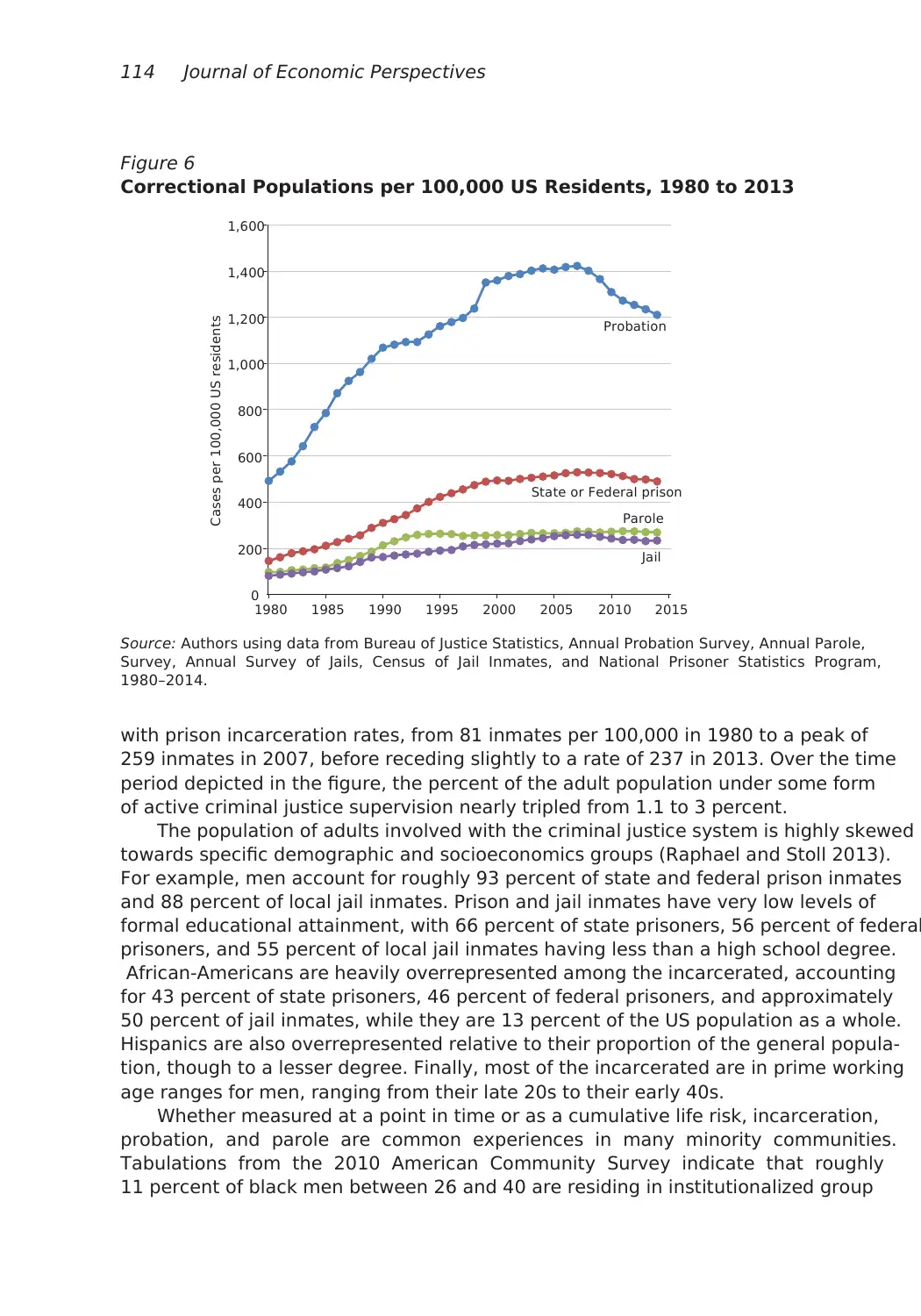
114 Journal of Economic Perspectives
with prison incarceration rates, from 81 inmates per 100,000 in 1980 to a peak of
259 inmates in 2007, before receding slightly to a rate of 237 in 2013. Over the time
period depicted in the figure, the percent of the adult population under some form
of active criminal justice supervision nearly tripled from 1.1 to 3 percent.
The population of adults involved with the criminal justice system is highly skewed
towards specific demographic and socioeconomics groups (Raphael and Stoll 2013).
For example, men account for roughly 93 percent of state and federal prison inmates
and 88 percent of local jail inmates. Prison and jail inmates have very low levels of
formal educational attainment, with 66 percent of state prisoners, 56 percent of federal
prisoners, and 55 percent of local jail inmates having less than a high school degree.
African-Americans are heavily overrepresented among the incarcerated, accounting
for 43 percent of state prisoners, 46 percent of federal prisoners, and approximately
50 percent of jail inmates, while they are 13 percent of the US population as a whole.
Hispanics are also overrepresented relative to their proportion of the general popula-
tion, though to a lesser degree. Finally, most of the incarcerated are in prime working
age ranges for men, ranging from their late 20s to their early 40s.
Whether measured at a point in time or as a cumulative life risk, incarceration,
probation, and parole are common experiences in many minority communities.
Tabulations from the 2010 American Community Survey indicate that roughly
11 percent of black men between 26 and 40 are residing in institutionalized group
Figure 6
Correctional Populations per 100,000 US Residents, 1980 to 2013
Source: Authors using data from Bureau of Justice Statistics, Annual Probation Survey, Annual Parole,
Survey, Annual Survey of Jails, Census of Jail Inmates, and National Prisoner Statistics Program,
1980–2014.
0
200
400
600
800
1,000
1,200
1,400
1,600
1980 1985 1990 1995 2000 2005 2010 2015
Cases per 100,000 US residents
Probation
State or Federal prison
Parole
Jail
with prison incarceration rates, from 81 inmates per 100,000 in 1980 to a peak of
259 inmates in 2007, before receding slightly to a rate of 237 in 2013. Over the time
period depicted in the figure, the percent of the adult population under some form
of active criminal justice supervision nearly tripled from 1.1 to 3 percent.
The population of adults involved with the criminal justice system is highly skewed
towards specific demographic and socioeconomics groups (Raphael and Stoll 2013).
For example, men account for roughly 93 percent of state and federal prison inmates
and 88 percent of local jail inmates. Prison and jail inmates have very low levels of
formal educational attainment, with 66 percent of state prisoners, 56 percent of federal
prisoners, and 55 percent of local jail inmates having less than a high school degree.
African-Americans are heavily overrepresented among the incarcerated, accounting
for 43 percent of state prisoners, 46 percent of federal prisoners, and approximately
50 percent of jail inmates, while they are 13 percent of the US population as a whole.
Hispanics are also overrepresented relative to their proportion of the general popula-
tion, though to a lesser degree. Finally, most of the incarcerated are in prime working
age ranges for men, ranging from their late 20s to their early 40s.
Whether measured at a point in time or as a cumulative life risk, incarceration,
probation, and parole are common experiences in many minority communities.
Tabulations from the 2010 American Community Survey indicate that roughly
11 percent of black men between 26 and 40 are residing in institutionalized group
Figure 6
Correctional Populations per 100,000 US Residents, 1980 to 2013
Source: Authors using data from Bureau of Justice Statistics, Annual Probation Survey, Annual Parole,
Survey, Annual Survey of Jails, Census of Jail Inmates, and National Prisoner Statistics Program,
1980–2014.
0
200
400
600
800
1,000
1,200
1,400
1,600
1980 1985 1990 1995 2000 2005 2010 2015
Cases per 100,000 US residents
Probation
State or Federal prison
Parole
Jail
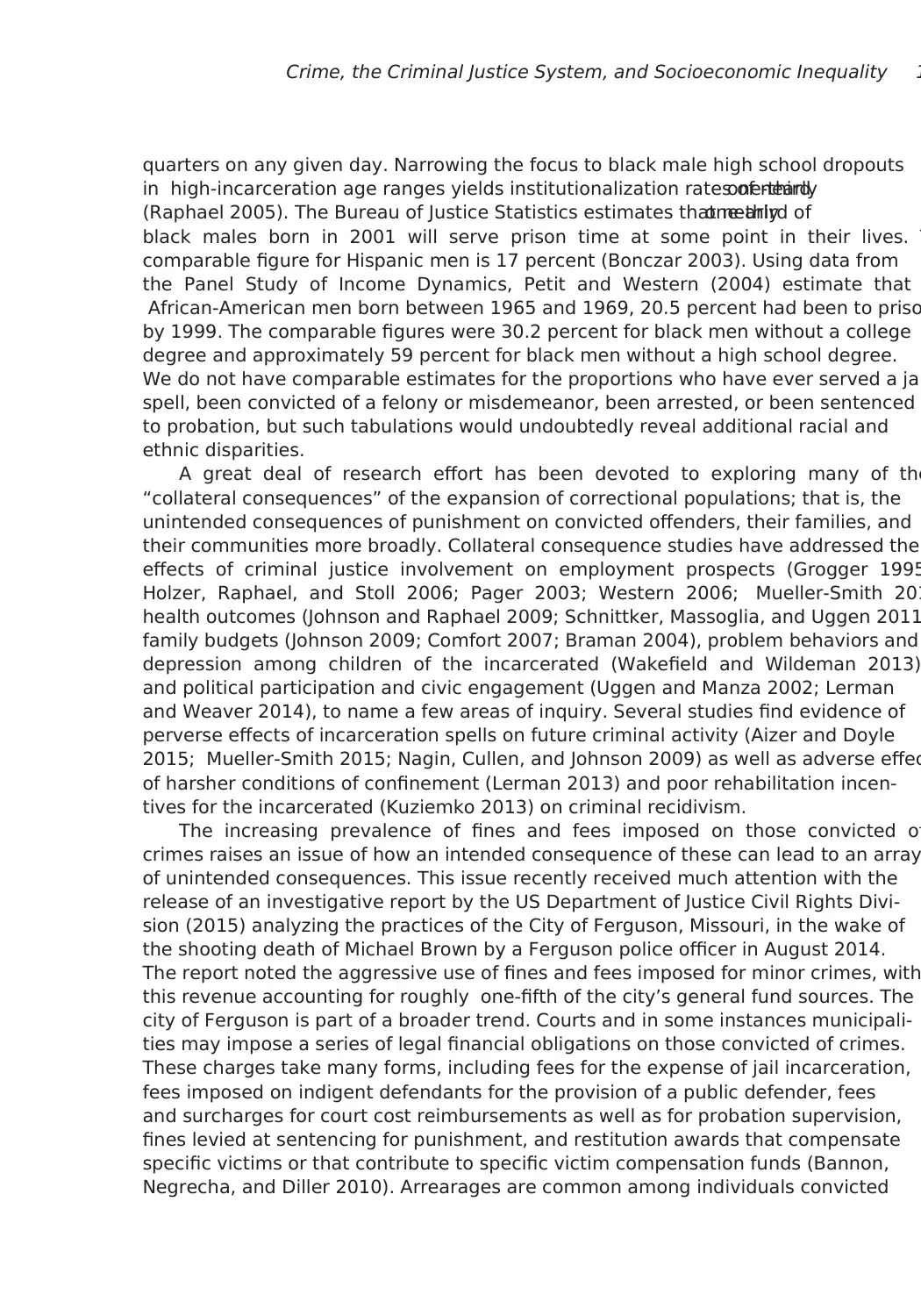
Crime, the Criminal Justice System, and Socioeconomic Inequality 1
quarters on any given day. Narrowing the focus to black male high school dropouts
in high-incarceration age ranges yields institutionalization rates of nearlyone-third
(Raphael 2005). The Bureau of Justice Statistics estimates that nearlyone-third of
black males born in 2001 will serve prison time at some point in their lives. T
comparable figure for Hispanic men is 17 percent (Bonczar 2003). Using data from
the Panel Study of Income Dynamics, Petit and Western (2004) estimate that
African-American men born between 1965 and 1969, 20.5 percent had been to priso
by 1999. The comparable figures were 30.2 percent for black men without a college
degree and approximately 59 percent for black men without a high school degree.
We do not have comparable estimates for the proportions who have ever served a jai
spell, been convicted of a felony or misdemeanor, been arrested, or been sentenced
to probation, but such tabulations would undoubtedly reveal additional racial and
ethnic disparities.
A great deal of research effort has been devoted to exploring many of the
“collateral consequences” of the expansion of correctional populations; that is, the
unintended consequences of punishment on convicted offenders, their families, and
their communities more broadly. Collateral consequence studies have addressed the
effects of criminal justice involvement on employment prospects (Grogger 1995
Holzer, Raphael, and Stoll 2006; Pager 2003; Western 2006; Mueller-Smith 201
health outcomes (Johnson and Raphael 2009; Schnittker, Massoglia, and Uggen 2011
family budgets (Johnson 2009; Comfort 2007; Braman 2004), problem behaviors and
depression among children of the incarcerated (Wakefield and Wildeman 2013)
and political participation and civic engagement (Uggen and Manza 2002; Lerman
and Weaver 2014), to name a few areas of inquiry. Several studies find evidence of
perverse effects of incarceration spells on future criminal activity (Aizer and Doyle
2015; Mueller-Smith 2015; Nagin, Cullen, and Johnson 2009) as well as adverse effec
of harsher conditions of confinement (Lerman 2013) and poor rehabilitation incen-
tives for the incarcerated (Kuziemko 2013) on criminal recidivism.
The increasing prevalence of fines and fees imposed on those convicted of
crimes raises an issue of how an intended consequence of these can lead to an array
of unintended consequences. This issue recently received much attention with the
release of an investigative report by the US Department of Justice Civil Rights Divi-
sion (2015) analyzing the practices of the City of Ferguson, Missouri, in the wake of
the shooting death of Michael Brown by a Ferguson police officer in August 2014.
The report noted the aggressive use of fines and fees imposed for minor crimes, with
this revenue accounting for roughly one-fifth of the city’s general fund sources. The
city of Ferguson is part of a broader trend. Courts and in some instances municipali-
ties may impose a series of legal financial obligations on those convicted of crimes.
These charges take many forms, including fees for the expense of jail incarceration,
fees imposed on indigent defendants for the provision of a public defender, fees
and surcharges for court cost reimbursements as well as for probation supervision,
fines levied at sentencing for punishment, and restitution awards that compensate
specific victims or that contribute to specific victim compensation funds (Bannon,
Negrecha, and Diller 2010). Arrearages are common among individuals convicted
quarters on any given day. Narrowing the focus to black male high school dropouts
in high-incarceration age ranges yields institutionalization rates of nearlyone-third
(Raphael 2005). The Bureau of Justice Statistics estimates that nearlyone-third of
black males born in 2001 will serve prison time at some point in their lives. T
comparable figure for Hispanic men is 17 percent (Bonczar 2003). Using data from
the Panel Study of Income Dynamics, Petit and Western (2004) estimate that
African-American men born between 1965 and 1969, 20.5 percent had been to priso
by 1999. The comparable figures were 30.2 percent for black men without a college
degree and approximately 59 percent for black men without a high school degree.
We do not have comparable estimates for the proportions who have ever served a jai
spell, been convicted of a felony or misdemeanor, been arrested, or been sentenced
to probation, but such tabulations would undoubtedly reveal additional racial and
ethnic disparities.
A great deal of research effort has been devoted to exploring many of the
“collateral consequences” of the expansion of correctional populations; that is, the
unintended consequences of punishment on convicted offenders, their families, and
their communities more broadly. Collateral consequence studies have addressed the
effects of criminal justice involvement on employment prospects (Grogger 1995
Holzer, Raphael, and Stoll 2006; Pager 2003; Western 2006; Mueller-Smith 201
health outcomes (Johnson and Raphael 2009; Schnittker, Massoglia, and Uggen 2011
family budgets (Johnson 2009; Comfort 2007; Braman 2004), problem behaviors and
depression among children of the incarcerated (Wakefield and Wildeman 2013)
and political participation and civic engagement (Uggen and Manza 2002; Lerman
and Weaver 2014), to name a few areas of inquiry. Several studies find evidence of
perverse effects of incarceration spells on future criminal activity (Aizer and Doyle
2015; Mueller-Smith 2015; Nagin, Cullen, and Johnson 2009) as well as adverse effec
of harsher conditions of confinement (Lerman 2013) and poor rehabilitation incen-
tives for the incarcerated (Kuziemko 2013) on criminal recidivism.
The increasing prevalence of fines and fees imposed on those convicted of
crimes raises an issue of how an intended consequence of these can lead to an array
of unintended consequences. This issue recently received much attention with the
release of an investigative report by the US Department of Justice Civil Rights Divi-
sion (2015) analyzing the practices of the City of Ferguson, Missouri, in the wake of
the shooting death of Michael Brown by a Ferguson police officer in August 2014.
The report noted the aggressive use of fines and fees imposed for minor crimes, with
this revenue accounting for roughly one-fifth of the city’s general fund sources. The
city of Ferguson is part of a broader trend. Courts and in some instances municipali-
ties may impose a series of legal financial obligations on those convicted of crimes.
These charges take many forms, including fees for the expense of jail incarceration,
fees imposed on indigent defendants for the provision of a public defender, fees
and surcharges for court cost reimbursements as well as for probation supervision,
fines levied at sentencing for punishment, and restitution awards that compensate
specific victims or that contribute to specific victim compensation funds (Bannon,
Negrecha, and Diller 2010). Arrearages are common among individuals convicted
Paraphrase This Document
Need a fresh take? Get an instant paraphrase of this document with our AI Paraphraser
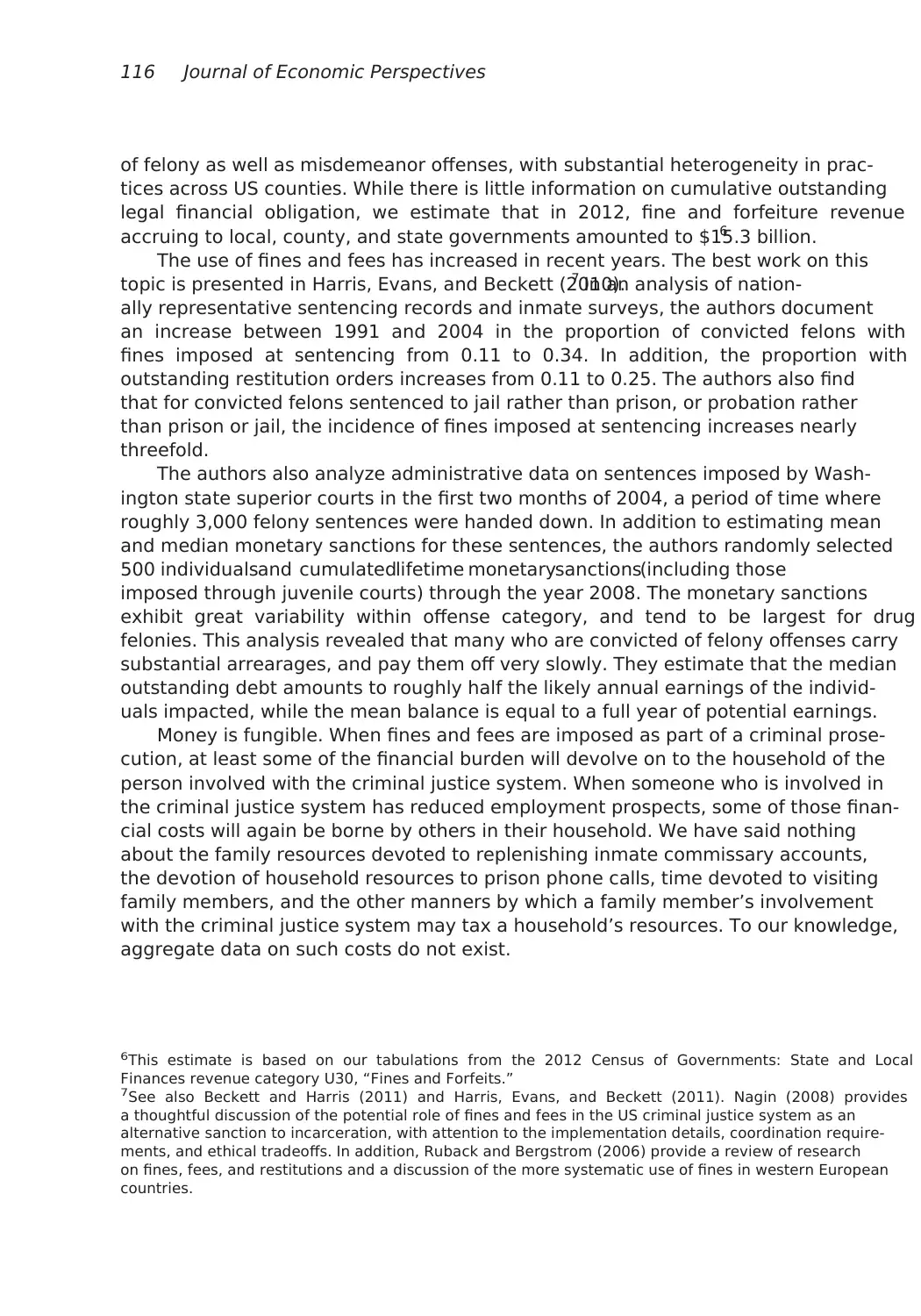
116 Journal of Economic Perspectives
of felony as well as misdemeanor offenses, with substantial heterogeneity in prac-
tices across US counties. While there is little information on cumulative outstanding
legal financial obligation, we estimate that in 2012, fine and forfeiture revenue
accruing to local, county, and state governments amounted to $15.3 billion.6
The use of fines and fees has increased in recent years. The best work on this
topic is presented in Harris, Evans, and Beckett (2010).7 In an analysis of nation-
ally representative sentencing records and inmate surveys, the authors document
an increase between 1991 and 2004 in the proportion of convicted felons with
fines imposed at sentencing from 0.11 to 0.34. In addition, the proportion with
outstanding restitution orders increases from 0.11 to 0.25. The authors also find
that for convicted felons sentenced to jail rather than prison, or probation rather
than prison or jail, the incidence of fines imposed at sentencing increases nearly
threefold.
The authors also analyze administrative data on sentences imposed by Wash-
ington state superior courts in the first two months of 2004, a period of time where
roughly 3,000 felony sentences were handed down. In addition to estimating mean
and median monetary sanctions for these sentences, the authors randomly selected
500 individualsand cumulatedlifetime monetarysanctions(including those
imposed through juvenile courts) through the year 2008. The monetary sanctions
exhibit great variability within offense category, and tend to be largest for drug
felonies. This analysis revealed that many who are convicted of felony offenses carry
substantial arrearages, and pay them off very slowly. They estimate that the median
outstanding debt amounts to roughly half the likely annual earnings of the individ-
uals impacted, while the mean balance is equal to a full year of potential earnings.
Money is fungible. When fines and fees are imposed as part of a criminal prose-
cution, at least some of the financial burden will devolve on to the household of the
person involved with the criminal justice system. When someone who is involved in
the criminal justice system has reduced employment prospects, some of those finan-
cial costs will again be borne by others in their household. We have said nothing
about the family resources devoted to replenishing inmate commissary accounts,
the devotion of household resources to prison phone calls, time devoted to visiting
family members, and the other manners by which a family member’s involvement
with the criminal justice system may tax a household’s resources. To our knowledge,
aggregate data on such costs do not exist.
6This estimate is based on our tabulations from the 2012 Census of Governments: State and Local
Finances revenue category U30, “Fines and Forfeits.”
7See also Beckett and Harris (2011) and Harris, Evans, and Beckett (2011). Nagin (2008) provides
a thoughtful discussion of the potential role of fines and fees in the US criminal justice system as an
alternative sanction to incarceration, with attention to the implementation details, coordination require-
ments, and ethical tradeoffs. In addition, Ruback and Bergstrom (2006) provide a review of research
on fines, fees, and restitutions and a discussion of the more systematic use of fines in western European
countries.
of felony as well as misdemeanor offenses, with substantial heterogeneity in prac-
tices across US counties. While there is little information on cumulative outstanding
legal financial obligation, we estimate that in 2012, fine and forfeiture revenue
accruing to local, county, and state governments amounted to $15.3 billion.6
The use of fines and fees has increased in recent years. The best work on this
topic is presented in Harris, Evans, and Beckett (2010).7 In an analysis of nation-
ally representative sentencing records and inmate surveys, the authors document
an increase between 1991 and 2004 in the proportion of convicted felons with
fines imposed at sentencing from 0.11 to 0.34. In addition, the proportion with
outstanding restitution orders increases from 0.11 to 0.25. The authors also find
that for convicted felons sentenced to jail rather than prison, or probation rather
than prison or jail, the incidence of fines imposed at sentencing increases nearly
threefold.
The authors also analyze administrative data on sentences imposed by Wash-
ington state superior courts in the first two months of 2004, a period of time where
roughly 3,000 felony sentences were handed down. In addition to estimating mean
and median monetary sanctions for these sentences, the authors randomly selected
500 individualsand cumulatedlifetime monetarysanctions(including those
imposed through juvenile courts) through the year 2008. The monetary sanctions
exhibit great variability within offense category, and tend to be largest for drug
felonies. This analysis revealed that many who are convicted of felony offenses carry
substantial arrearages, and pay them off very slowly. They estimate that the median
outstanding debt amounts to roughly half the likely annual earnings of the individ-
uals impacted, while the mean balance is equal to a full year of potential earnings.
Money is fungible. When fines and fees are imposed as part of a criminal prose-
cution, at least some of the financial burden will devolve on to the household of the
person involved with the criminal justice system. When someone who is involved in
the criminal justice system has reduced employment prospects, some of those finan-
cial costs will again be borne by others in their household. We have said nothing
about the family resources devoted to replenishing inmate commissary accounts,
the devotion of household resources to prison phone calls, time devoted to visiting
family members, and the other manners by which a family member’s involvement
with the criminal justice system may tax a household’s resources. To our knowledge,
aggregate data on such costs do not exist.
6This estimate is based on our tabulations from the 2012 Census of Governments: State and Local
Finances revenue category U30, “Fines and Forfeits.”
7See also Beckett and Harris (2011) and Harris, Evans, and Beckett (2011). Nagin (2008) provides
a thoughtful discussion of the potential role of fines and fees in the US criminal justice system as an
alternative sanction to incarceration, with attention to the implementation details, coordination require-
ments, and ethical tradeoffs. In addition, Ruback and Bergstrom (2006) provide a review of research
on fines, fees, and restitutions and a discussion of the more systematic use of fines in western European
countries.
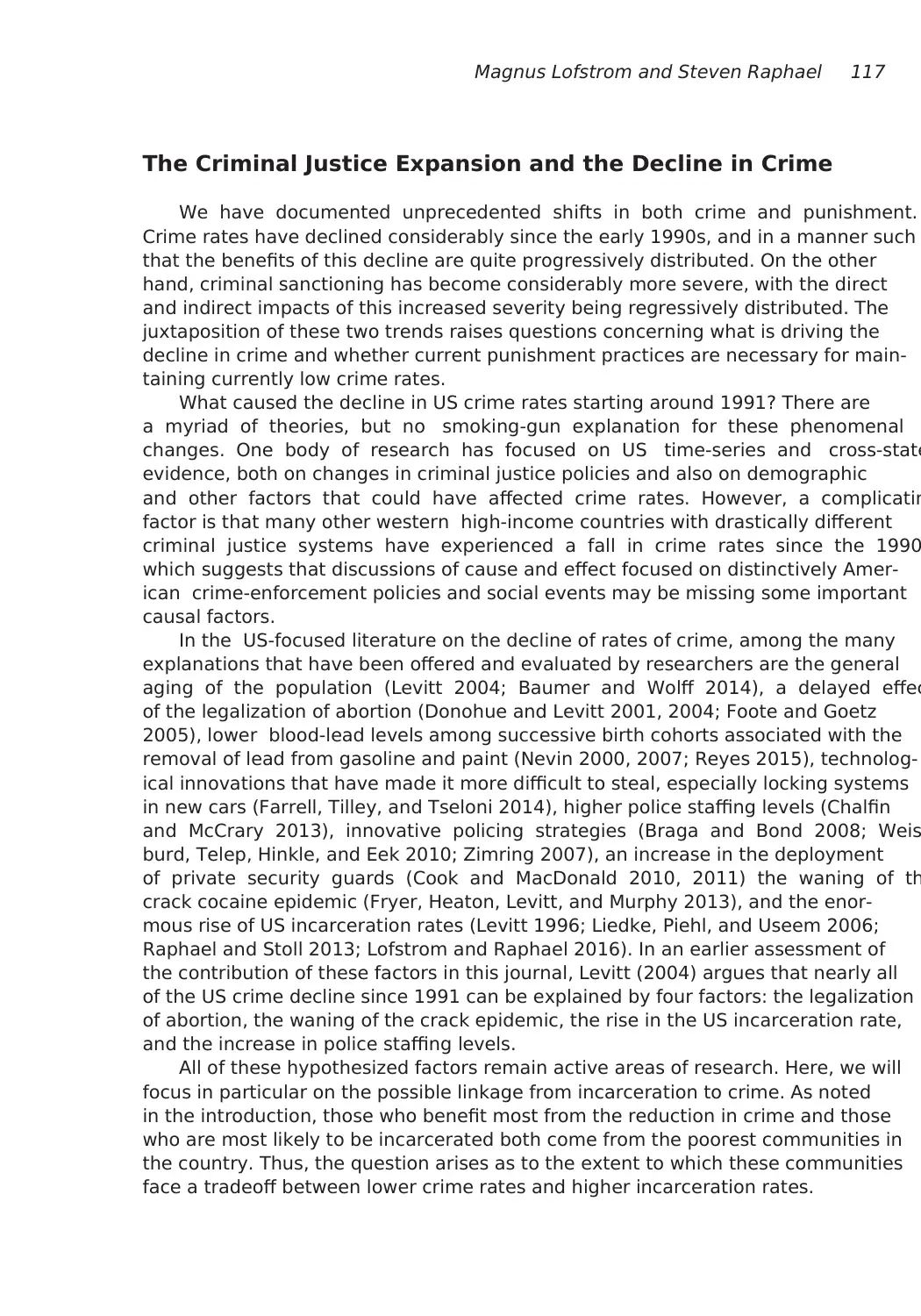
Magnus Lofstrom and Steven Raphael 117
The Criminal Justice Expansion and the Decline in Crime
We have documented unprecedented shifts in both crime and punishment.
Crime rates have declined considerably since the early 1990s, and in a manner such
that the benefits of this decline are quite progressively distributed. On the other
hand, criminal sanctioning has become considerably more severe, with the direct
and indirect impacts of this increased severity being regressively distributed. The
juxtaposition of these two trends raises questions concerning what is driving the
decline in crime and whether current punishment practices are necessary for main-
taining currently low crime rates.
What caused the decline in US crime rates starting around 1991? There are
a myriad of theories, but no smoking-gun explanation for these phenomenal
changes. One body of research has focused on US time-series and cross-state
evidence, both on changes in criminal justice policies and also on demographic
and other factors that could have affected crime rates. However, a complicatin
factor is that many other western high-income countries with drastically different
criminal justice systems have experienced a fall in crime rates since the 1990
which suggests that discussions of cause and effect focused on distinctively Amer-
ican crime-enforcement policies and social events may be missing some important
causal factors.
In the US-focused literature on the decline of rates of crime, among the many
explanations that have been offered and evaluated by researchers are the general
aging of the population (Levitt 2004; Baumer and Wolff 2014), a delayed effec
of the legalization of abortion (Donohue and Levitt 2001, 2004; Foote and Goetz
2005), lower blood-lead levels among successive birth cohorts associated with the
removal of lead from gasoline and paint (Nevin 2000, 2007; Reyes 2015), technolog-
ical innovations that have made it more difficult to steal, especially locking systems
in new cars (Farrell, Tilley, and Tseloni 2014), higher police staffing levels (Chalfin
and McCrary 2013), innovative policing strategies (Braga and Bond 2008; Weis
burd, Telep, Hinkle, and Eek 2010; Zimring 2007), an increase in the deployment
of private security guards (Cook and MacDonald 2010, 2011) the waning of th
crack cocaine epidemic (Fryer, Heaton, Levitt, and Murphy 2013), and the enor-
mous rise of US incarceration rates (Levitt 1996; Liedke, Piehl, and Useem 2006;
Raphael and Stoll 2013; Lofstrom and Raphael 2016). In an earlier assessment of
the contribution of these factors in this journal, Levitt (2004) argues that nearly all
of the US crime decline since 1991 can be explained by four factors: the legalization
of abortion, the waning of the crack epidemic, the rise in the US incarceration rate,
and the increase in police staffing levels.
All of these hypothesized factors remain active areas of research. Here, we will
focus in particular on the possible linkage from incarceration to crime. As noted
in the introduction, those who benefit most from the reduction in crime and those
who are most likely to be incarcerated both come from the poorest communities in
the country. Thus, the question arises as to the extent to which these communities
face a tradeoff between lower crime rates and higher incarceration rates.
The Criminal Justice Expansion and the Decline in Crime
We have documented unprecedented shifts in both crime and punishment.
Crime rates have declined considerably since the early 1990s, and in a manner such
that the benefits of this decline are quite progressively distributed. On the other
hand, criminal sanctioning has become considerably more severe, with the direct
and indirect impacts of this increased severity being regressively distributed. The
juxtaposition of these two trends raises questions concerning what is driving the
decline in crime and whether current punishment practices are necessary for main-
taining currently low crime rates.
What caused the decline in US crime rates starting around 1991? There are
a myriad of theories, but no smoking-gun explanation for these phenomenal
changes. One body of research has focused on US time-series and cross-state
evidence, both on changes in criminal justice policies and also on demographic
and other factors that could have affected crime rates. However, a complicatin
factor is that many other western high-income countries with drastically different
criminal justice systems have experienced a fall in crime rates since the 1990
which suggests that discussions of cause and effect focused on distinctively Amer-
ican crime-enforcement policies and social events may be missing some important
causal factors.
In the US-focused literature on the decline of rates of crime, among the many
explanations that have been offered and evaluated by researchers are the general
aging of the population (Levitt 2004; Baumer and Wolff 2014), a delayed effec
of the legalization of abortion (Donohue and Levitt 2001, 2004; Foote and Goetz
2005), lower blood-lead levels among successive birth cohorts associated with the
removal of lead from gasoline and paint (Nevin 2000, 2007; Reyes 2015), technolog-
ical innovations that have made it more difficult to steal, especially locking systems
in new cars (Farrell, Tilley, and Tseloni 2014), higher police staffing levels (Chalfin
and McCrary 2013), innovative policing strategies (Braga and Bond 2008; Weis
burd, Telep, Hinkle, and Eek 2010; Zimring 2007), an increase in the deployment
of private security guards (Cook and MacDonald 2010, 2011) the waning of th
crack cocaine epidemic (Fryer, Heaton, Levitt, and Murphy 2013), and the enor-
mous rise of US incarceration rates (Levitt 1996; Liedke, Piehl, and Useem 2006;
Raphael and Stoll 2013; Lofstrom and Raphael 2016). In an earlier assessment of
the contribution of these factors in this journal, Levitt (2004) argues that nearly all
of the US crime decline since 1991 can be explained by four factors: the legalization
of abortion, the waning of the crack epidemic, the rise in the US incarceration rate,
and the increase in police staffing levels.
All of these hypothesized factors remain active areas of research. Here, we will
focus in particular on the possible linkage from incarceration to crime. As noted
in the introduction, those who benefit most from the reduction in crime and those
who are most likely to be incarcerated both come from the poorest communities in
the country. Thus, the question arises as to the extent to which these communities
face a tradeoff between lower crime rates and higher incarceration rates.
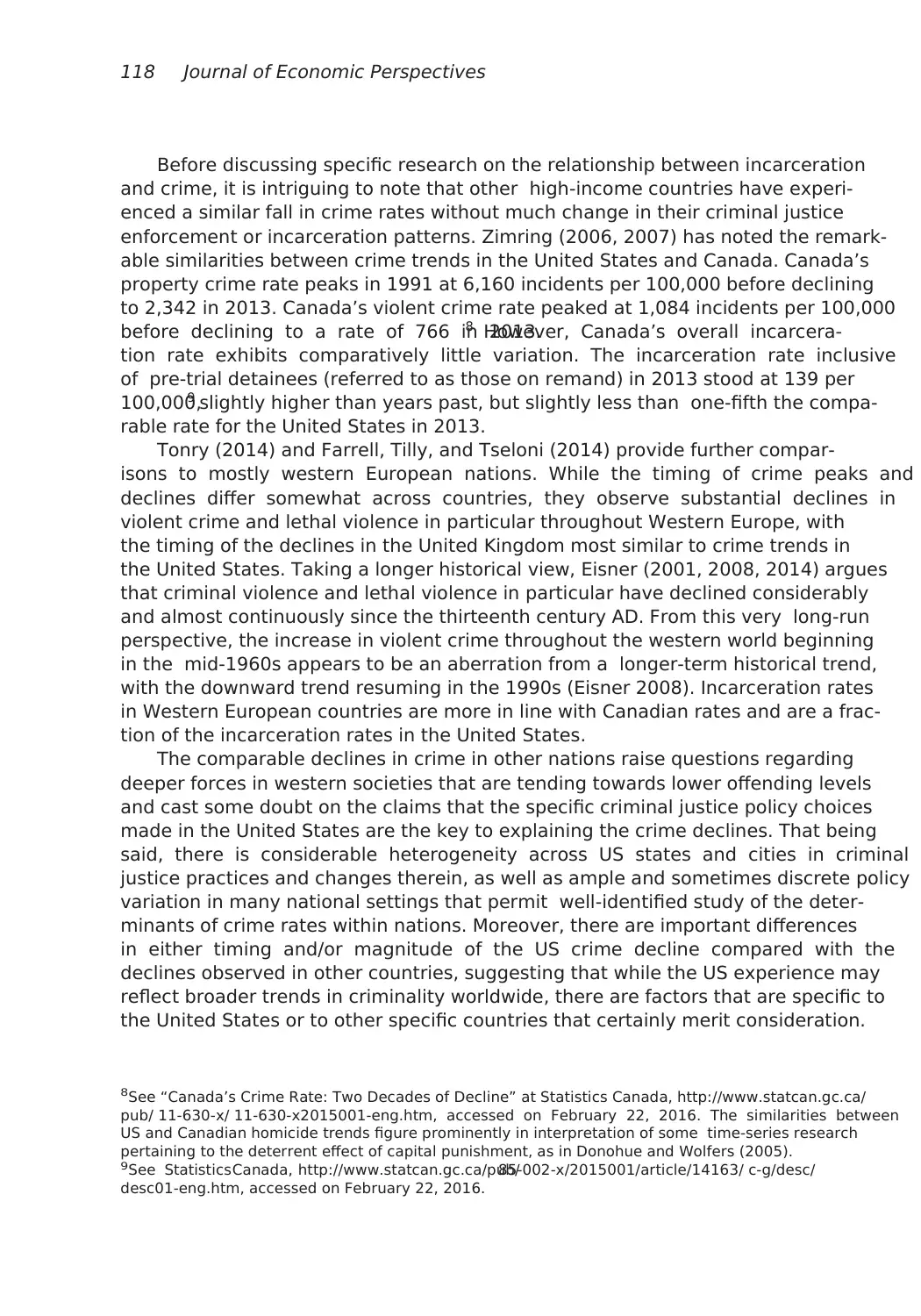
118 Journal of Economic Perspectives
Before discussing specific research on the relationship between incarceration
and crime, it is intriguing to note that other high-income countries have experi-
enced a similar fall in crime rates without much change in their criminal justice
enforcement or incarceration patterns. Zimring (2006, 2007) has noted the remark-
able similarities between crime trends in the United States and Canada. Canada’s
property crime rate peaks in 1991 at 6,160 incidents per 100,000 before declining
to 2,342 in 2013. Canada’s violent crime rate peaked at 1,084 incidents per 100,000
before declining to a rate of 766 in 2013.8 However, Canada’s overall incarcera-
tion rate exhibits comparatively little variation. The incarceration rate inclusive
of pre-trial detainees (referred to as those on remand) in 2013 stood at 139 per
100,000,9 slightly higher than years past, but slightly less than one-fifth the compa-
rable rate for the United States in 2013.
Tonry (2014) and Farrell, Tilly, and Tseloni (2014) provide further compar-
isons to mostly western European nations. While the timing of crime peaks and
declines differ somewhat across countries, they observe substantial declines in
violent crime and lethal violence in particular throughout Western Europe, with
the timing of the declines in the United Kingdom most similar to crime trends in
the United States. Taking a longer historical view, Eisner (2001, 2008, 2014) argues
that criminal violence and lethal violence in particular have declined considerably
and almost continuously since the thirteenth century AD. From this very long-run
perspective, the increase in violent crime throughout the western world beginning
in the mid-1960s appears to be an aberration from a longer-term historical trend,
with the downward trend resuming in the 1990s (Eisner 2008). Incarceration rates
in Western European countries are more in line with Canadian rates and are a frac-
tion of the incarceration rates in the United States.
The comparable declines in crime in other nations raise questions regarding
deeper forces in western societies that are tending towards lower offending levels
and cast some doubt on the claims that the specific criminal justice policy choices
made in the United States are the key to explaining the crime declines. That being
said, there is considerable heterogeneity across US states and cities in criminal
justice practices and changes therein, as well as ample and sometimes discrete policy
variation in many national settings that permit well-identified study of the deter-
minants of crime rates within nations. Moreover, there are important differences
in either timing and/or magnitude of the US crime decline compared with the
declines observed in other countries, suggesting that while the US experience may
reflect broader trends in criminality worldwide, there are factors that are specific to
the United States or to other specific countries that certainly merit consideration.
8See “Canada’s Crime Rate: Two Decades of Decline” at Statistics Canada, http://www.statcan.gc.ca/
pub/ 11-630-x/ 11-630-x2015001-eng.htm, accessed on February 22, 2016. The similarities between
US and Canadian homicide trends figure prominently in interpretation of some time-series research
pertaining to the deterrent effect of capital punishment, as in Donohue and Wolfers (2005).
9See Statistics Canada, http://www.statcan.gc.ca/pub/85-002-x/2015001/article/14163/ c-g/desc/
desc01-eng.htm, accessed on February 22, 2016.
Before discussing specific research on the relationship between incarceration
and crime, it is intriguing to note that other high-income countries have experi-
enced a similar fall in crime rates without much change in their criminal justice
enforcement or incarceration patterns. Zimring (2006, 2007) has noted the remark-
able similarities between crime trends in the United States and Canada. Canada’s
property crime rate peaks in 1991 at 6,160 incidents per 100,000 before declining
to 2,342 in 2013. Canada’s violent crime rate peaked at 1,084 incidents per 100,000
before declining to a rate of 766 in 2013.8 However, Canada’s overall incarcera-
tion rate exhibits comparatively little variation. The incarceration rate inclusive
of pre-trial detainees (referred to as those on remand) in 2013 stood at 139 per
100,000,9 slightly higher than years past, but slightly less than one-fifth the compa-
rable rate for the United States in 2013.
Tonry (2014) and Farrell, Tilly, and Tseloni (2014) provide further compar-
isons to mostly western European nations. While the timing of crime peaks and
declines differ somewhat across countries, they observe substantial declines in
violent crime and lethal violence in particular throughout Western Europe, with
the timing of the declines in the United Kingdom most similar to crime trends in
the United States. Taking a longer historical view, Eisner (2001, 2008, 2014) argues
that criminal violence and lethal violence in particular have declined considerably
and almost continuously since the thirteenth century AD. From this very long-run
perspective, the increase in violent crime throughout the western world beginning
in the mid-1960s appears to be an aberration from a longer-term historical trend,
with the downward trend resuming in the 1990s (Eisner 2008). Incarceration rates
in Western European countries are more in line with Canadian rates and are a frac-
tion of the incarceration rates in the United States.
The comparable declines in crime in other nations raise questions regarding
deeper forces in western societies that are tending towards lower offending levels
and cast some doubt on the claims that the specific criminal justice policy choices
made in the United States are the key to explaining the crime declines. That being
said, there is considerable heterogeneity across US states and cities in criminal
justice practices and changes therein, as well as ample and sometimes discrete policy
variation in many national settings that permit well-identified study of the deter-
minants of crime rates within nations. Moreover, there are important differences
in either timing and/or magnitude of the US crime decline compared with the
declines observed in other countries, suggesting that while the US experience may
reflect broader trends in criminality worldwide, there are factors that are specific to
the United States or to other specific countries that certainly merit consideration.
8See “Canada’s Crime Rate: Two Decades of Decline” at Statistics Canada, http://www.statcan.gc.ca/
pub/ 11-630-x/ 11-630-x2015001-eng.htm, accessed on February 22, 2016. The similarities between
US and Canadian homicide trends figure prominently in interpretation of some time-series research
pertaining to the deterrent effect of capital punishment, as in Donohue and Wolfers (2005).
9See Statistics Canada, http://www.statcan.gc.ca/pub/85-002-x/2015001/article/14163/ c-g/desc/
desc01-eng.htm, accessed on February 22, 2016.
Secure Best Marks with AI Grader
Need help grading? Try our AI Grader for instant feedback on your assignments.

Crime, the Criminal Justice System, and Socioeconomic Inequality 1
Levitt’s (2004) review of the crime decline attributes one-third of the decline
to increases in incarceration during the 1990s. This assessment was based largely
on research studying the incarceration–crime relationship using data spanning
the late 1970s, 1980s, and very early 1990s (specifically, the estimates in Lev
1996). Since the publication of Levitt’s (2004) assessment, there have been several
quasi-experimentalstudies of the prison–crimerelationshipexploiting large,
discrete, and policy-induced changes in incarceration rates in the US and elsewhere.
There have also been advances in panel data estimates that explore the possibility
of diminishing marginal effectiveness of incarceration as a crime-fighting tool. This
research demonstrates that at relatively low incarceration rates, exogenous shocks to
incarceration levels tend to have fairly large effects on crime, mostly through crim-
inal incapacitation. However, this research also shows very small effects of changes
in incarceration rates on crime when the incarceration rate is high—and evidence
that diminishing effectiveness sets in at relatively low levels of incarceration.
For example, recent studies of policy shocks in European countries (Barbarino
and Mastrobuoni 2014; Buonanno and Raphael 2013; Vollard 2012) show fairly large
incapacitation effects in national settings with incarceration rates roughly one-sixth
that of the United States. However, even in these very low-incarceration natio
settings, evidence of diminishing effectiveness is apparent. For example, Buonanno
and Raphael (2013) find large reverse incapacitation effects of a mass Italian prison
release in 2006 on felony offending, on the order of 13 to 18 reported felony offenses
for each prison year not served. However, the effects are much smaller in Italian prov
inces with highpre-shock incarceration rates and larger in provinces with lower rates,
with “high” incarceration provinces in Italy having combined post- andpre-trial incar-
ceration rates that are generally below 200 per 100,000 population. Vollard (2012)
finds that the application of a Dutch sentence enhancement for habitual offenders
(those convicted of a new crime with ten or more prior felony convictions) netted
considerably less-active offenders in Dutch municipalities that dipped further into the
pool of local suspects in applying the sentencing enhancements.
In Lofstrom and Raphael (2016), we look at a recent policy shock to California.
In October 2011, the state implemented sentencing reforms under pressure from
a federal court order that greatly limited the use of prison for technical parole
violations and defined a class of less-serious offenders to be diverted from prison
sentences to locally imposed sanctions. Within one year, the state’s prison popu-
lation declined by nearly 28,000 inmates (roughly 13 percent), with an offsetting
increase in the jail population of approximately 8,000 inmates. The reform reduced
the state’s incarceration rate (combining prison and jail together) to levels not seen
since the early 1990s, effectively wiping away most of the prison growth coinciding
with state’s decline in crime, as illustrated in Figure 7.
The sharp decline in incarceration in 2011/2012 had very small effects on the
state’s crime rates. Crime trends in California have been comparable to those of the
nation, with reported property crime rates peaking in 1991 and violent crime rates
peaking in 1992. California crime rates decline considerably through 2010—the
last full year before the sentencing reforms. There is a slight uptick in violent crime
Levitt’s (2004) review of the crime decline attributes one-third of the decline
to increases in incarceration during the 1990s. This assessment was based largely
on research studying the incarceration–crime relationship using data spanning
the late 1970s, 1980s, and very early 1990s (specifically, the estimates in Lev
1996). Since the publication of Levitt’s (2004) assessment, there have been several
quasi-experimentalstudies of the prison–crimerelationshipexploiting large,
discrete, and policy-induced changes in incarceration rates in the US and elsewhere.
There have also been advances in panel data estimates that explore the possibility
of diminishing marginal effectiveness of incarceration as a crime-fighting tool. This
research demonstrates that at relatively low incarceration rates, exogenous shocks to
incarceration levels tend to have fairly large effects on crime, mostly through crim-
inal incapacitation. However, this research also shows very small effects of changes
in incarceration rates on crime when the incarceration rate is high—and evidence
that diminishing effectiveness sets in at relatively low levels of incarceration.
For example, recent studies of policy shocks in European countries (Barbarino
and Mastrobuoni 2014; Buonanno and Raphael 2013; Vollard 2012) show fairly large
incapacitation effects in national settings with incarceration rates roughly one-sixth
that of the United States. However, even in these very low-incarceration natio
settings, evidence of diminishing effectiveness is apparent. For example, Buonanno
and Raphael (2013) find large reverse incapacitation effects of a mass Italian prison
release in 2006 on felony offending, on the order of 13 to 18 reported felony offenses
for each prison year not served. However, the effects are much smaller in Italian prov
inces with highpre-shock incarceration rates and larger in provinces with lower rates,
with “high” incarceration provinces in Italy having combined post- andpre-trial incar-
ceration rates that are generally below 200 per 100,000 population. Vollard (2012)
finds that the application of a Dutch sentence enhancement for habitual offenders
(those convicted of a new crime with ten or more prior felony convictions) netted
considerably less-active offenders in Dutch municipalities that dipped further into the
pool of local suspects in applying the sentencing enhancements.
In Lofstrom and Raphael (2016), we look at a recent policy shock to California.
In October 2011, the state implemented sentencing reforms under pressure from
a federal court order that greatly limited the use of prison for technical parole
violations and defined a class of less-serious offenders to be diverted from prison
sentences to locally imposed sanctions. Within one year, the state’s prison popu-
lation declined by nearly 28,000 inmates (roughly 13 percent), with an offsetting
increase in the jail population of approximately 8,000 inmates. The reform reduced
the state’s incarceration rate (combining prison and jail together) to levels not seen
since the early 1990s, effectively wiping away most of the prison growth coinciding
with state’s decline in crime, as illustrated in Figure 7.
The sharp decline in incarceration in 2011/2012 had very small effects on the
state’s crime rates. Crime trends in California have been comparable to those of the
nation, with reported property crime rates peaking in 1991 and violent crime rates
peaking in 1992. California crime rates decline considerably through 2010—the
last full year before the sentencing reforms. There is a slight uptick in violent crime
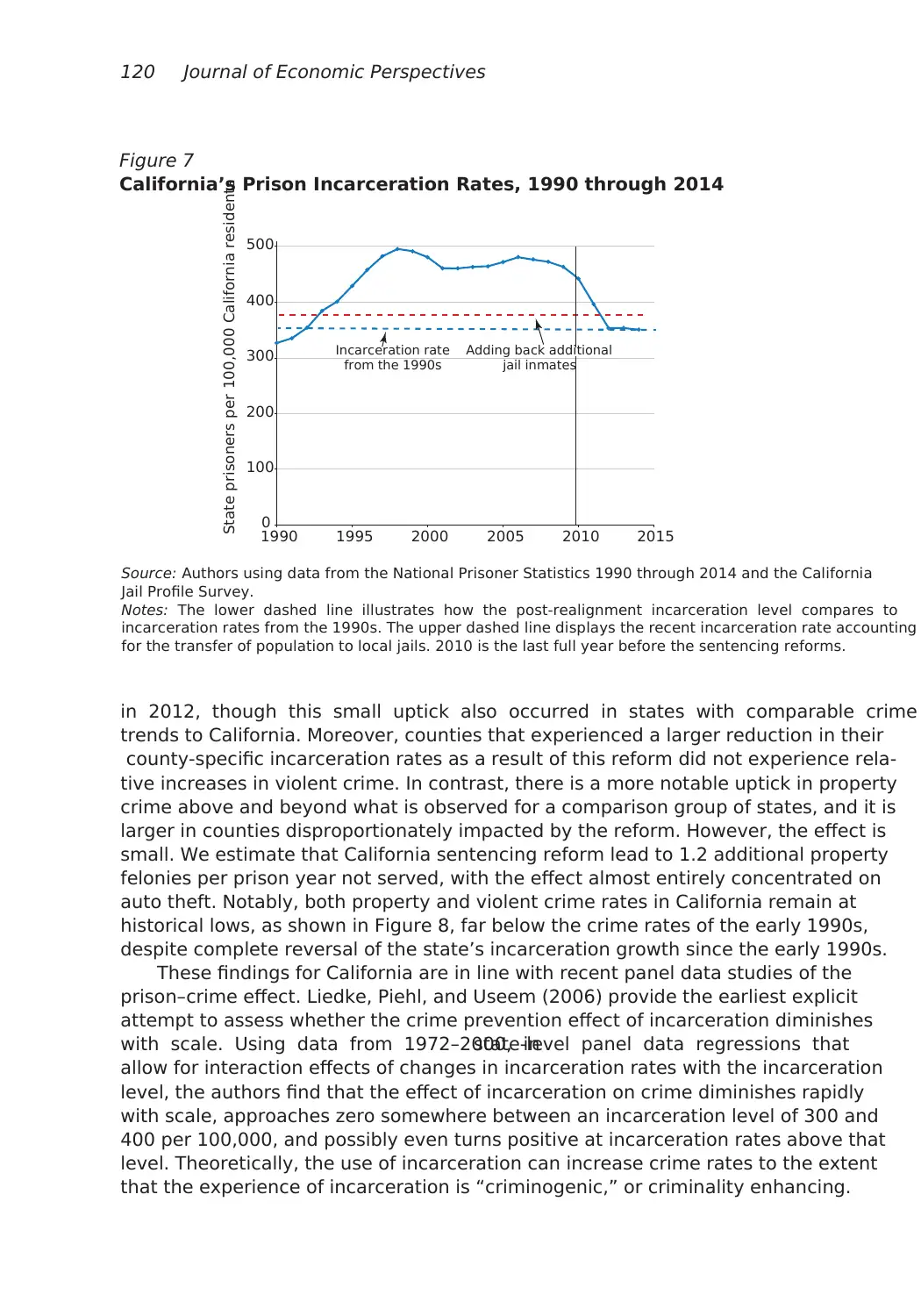
120 Journal of Economic Perspectives
in 2012, though this small uptick also occurred in states with comparable crime
trends to California. Moreover, counties that experienced a larger reduction in their
county-specific incarceration rates as a result of this reform did not experience rela-
tive increases in violent crime. In contrast, there is a more notable uptick in property
crime above and beyond what is observed for a comparison group of states, and it is
larger in counties disproportionately impacted by the reform. However, the effect is
small. We estimate that California sentencing reform lead to 1.2 additional property
felonies per prison year not served, with the effect almost entirely concentrated on
auto theft. Notably, both property and violent crime rates in California remain at
historical lows, as shown in Figure 8, far below the crime rates of the early 1990s,
despite complete reversal of the state’s incarceration growth since the early 1990s.
These findings for California are in line with recent panel data studies of the
prison–crime effect. Liedke, Piehl, and Useem (2006) provide the earliest explicit
attempt to assess whether the crime prevention effect of incarceration diminishes
with scale. Using data from 1972–2000, instate-level panel data regressions that
allow for interaction effects of changes in incarceration rates with the incarceration
level, the authors find that the effect of incarceration on crime diminishes rapidly
with scale, approaches zero somewhere between an incarceration level of 300 and
400 per 100,000, and possibly even turns positive at incarceration rates above that
level. Theoretically, the use of incarceration can increase crime rates to the extent
that the experience of incarceration is “criminogenic,” or criminality enhancing.
Figure 7
California’s Prison Incarceration Rates, 1990 through 2014
Source: Authors using data from the National Prisoner Statistics 1990 through 2014 and the California
Jail Profile Survey.
Notes: The lower dashed line illustrates how the post-realignment incarceration level compares to
incarceration rates from the 1990s. The upper dashed line displays the recent incarceration rate accounting
for the transfer of population to local jails. 2010 is the last full year before the sentencing reforms.
1990
0
100
200
300
400
500
1995 2000 2005 2010 2015
State prisoners per 100,000 California residents
Incarceration rate
from the 1990s
Adding back additional
jail inmates
in 2012, though this small uptick also occurred in states with comparable crime
trends to California. Moreover, counties that experienced a larger reduction in their
county-specific incarceration rates as a result of this reform did not experience rela-
tive increases in violent crime. In contrast, there is a more notable uptick in property
crime above and beyond what is observed for a comparison group of states, and it is
larger in counties disproportionately impacted by the reform. However, the effect is
small. We estimate that California sentencing reform lead to 1.2 additional property
felonies per prison year not served, with the effect almost entirely concentrated on
auto theft. Notably, both property and violent crime rates in California remain at
historical lows, as shown in Figure 8, far below the crime rates of the early 1990s,
despite complete reversal of the state’s incarceration growth since the early 1990s.
These findings for California are in line with recent panel data studies of the
prison–crime effect. Liedke, Piehl, and Useem (2006) provide the earliest explicit
attempt to assess whether the crime prevention effect of incarceration diminishes
with scale. Using data from 1972–2000, instate-level panel data regressions that
allow for interaction effects of changes in incarceration rates with the incarceration
level, the authors find that the effect of incarceration on crime diminishes rapidly
with scale, approaches zero somewhere between an incarceration level of 300 and
400 per 100,000, and possibly even turns positive at incarceration rates above that
level. Theoretically, the use of incarceration can increase crime rates to the extent
that the experience of incarceration is “criminogenic,” or criminality enhancing.
Figure 7
California’s Prison Incarceration Rates, 1990 through 2014
Source: Authors using data from the National Prisoner Statistics 1990 through 2014 and the California
Jail Profile Survey.
Notes: The lower dashed line illustrates how the post-realignment incarceration level compares to
incarceration rates from the 1990s. The upper dashed line displays the recent incarceration rate accounting
for the transfer of population to local jails. 2010 is the last full year before the sentencing reforms.
1990
0
100
200
300
400
500
1995 2000 2005 2010 2015
State prisoners per 100,000 California residents
Incarceration rate
from the 1990s
Adding back additional
jail inmates
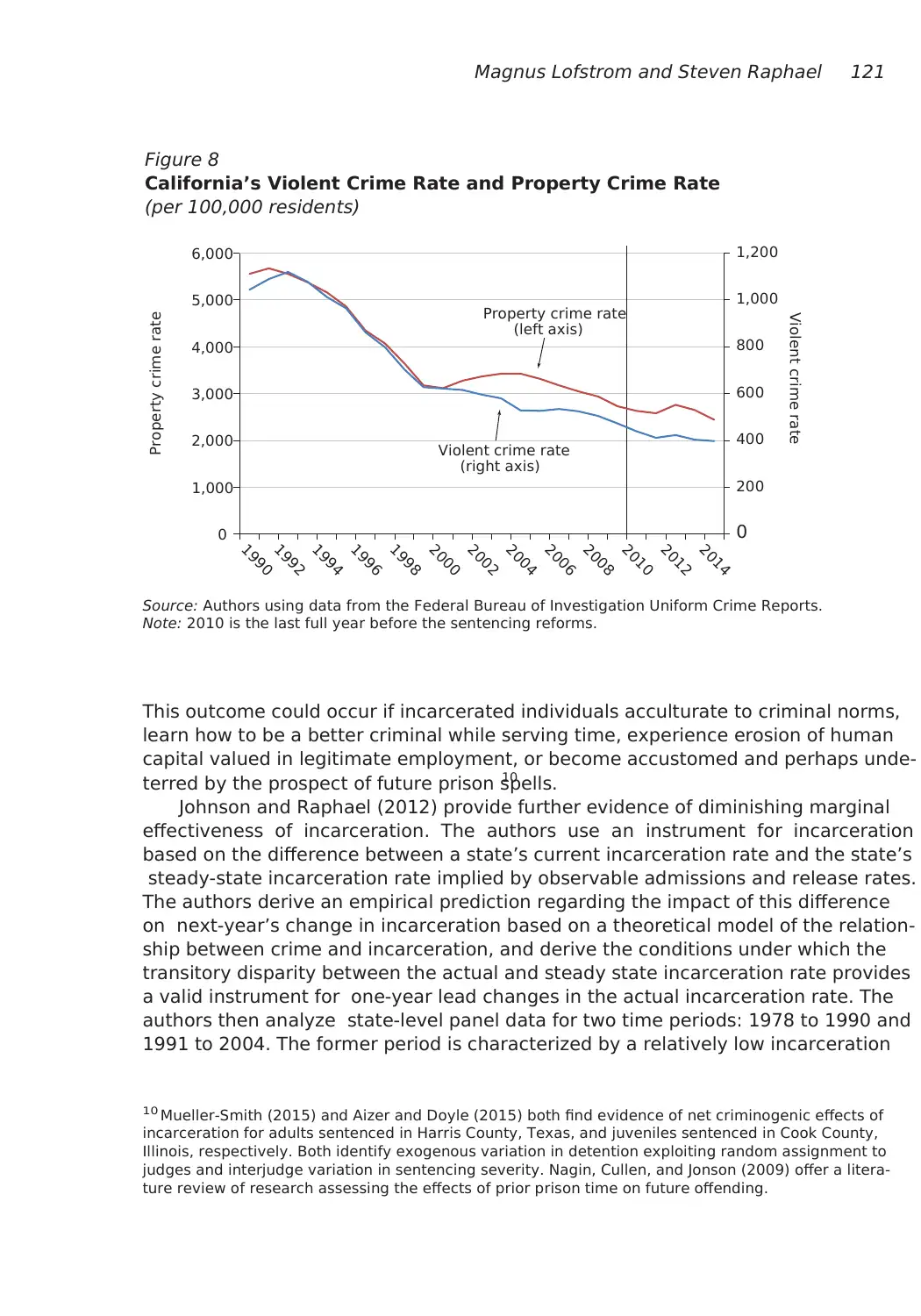
Magnus Lofstrom and Steven Raphael 121
This outcome could occur if incarcerated individuals acculturate to criminal norms,
learn how to be a better criminal while serving time, experience erosion of human
capital valued in legitimate employment, or become accustomed and perhaps unde-
terred by the prospect of future prison spells.10
Johnson and Raphael (2012) provide further evidence of diminishing marginal
effectiveness of incarceration. The authors use an instrument for incarceration
based on the difference between a state’s current incarceration rate and the state’s
steady-state incarceration rate implied by observable admissions and release rates.
The authors derive an empirical prediction regarding the impact of this difference
on next-year’s change in incarceration based on a theoretical model of the relation-
ship between crime and incarceration, and derive the conditions under which the
transitory disparity between the actual and steady state incarceration rate provides
a valid instrument for one-year lead changes in the actual incarceration rate. The
authors then analyze state-level panel data for two time periods: 1978 to 1990 and
1991 to 2004. The former period is characterized by a relatively low incarceration
10 Mueller-Smith (2015) and Aizer and Doyle (2015) both find evidence of net criminogenic effects of
incarceration for adults sentenced in Harris County, Texas, and juveniles sentenced in Cook County,
Illinois, respectively. Both identify exogenous variation in detention exploiting random assignment to
judges and interjudge variation in sentencing severity. Nagin, Cullen, and Jonson (2009) offer a litera-
ture review of research assessing the effects of prior prison time on future offending.
Figure 8
California’s Violent Crime Rate and Property Crime Rate
(per 100,000 residents)
Source: Authors using data from the Federal Bureau of Investigation Uniform Crime Reports.
Note: 2010 is the last full year before the sentencing reforms.
0
200
400
600
800
1,000
1,200
0
1,000
2,000
3,000
4,000
5,000
6,000
Violent crime rate
Property crime rate Property crime rate
(left axis)
Violent crime rate
(right axis)
1990
1992
1994
1996
1998
2000
2002
2004
2006
2008
2010
2012
2014
This outcome could occur if incarcerated individuals acculturate to criminal norms,
learn how to be a better criminal while serving time, experience erosion of human
capital valued in legitimate employment, or become accustomed and perhaps unde-
terred by the prospect of future prison spells.10
Johnson and Raphael (2012) provide further evidence of diminishing marginal
effectiveness of incarceration. The authors use an instrument for incarceration
based on the difference between a state’s current incarceration rate and the state’s
steady-state incarceration rate implied by observable admissions and release rates.
The authors derive an empirical prediction regarding the impact of this difference
on next-year’s change in incarceration based on a theoretical model of the relation-
ship between crime and incarceration, and derive the conditions under which the
transitory disparity between the actual and steady state incarceration rate provides
a valid instrument for one-year lead changes in the actual incarceration rate. The
authors then analyze state-level panel data for two time periods: 1978 to 1990 and
1991 to 2004. The former period is characterized by a relatively low incarceration
10 Mueller-Smith (2015) and Aizer and Doyle (2015) both find evidence of net criminogenic effects of
incarceration for adults sentenced in Harris County, Texas, and juveniles sentenced in Cook County,
Illinois, respectively. Both identify exogenous variation in detention exploiting random assignment to
judges and interjudge variation in sentencing severity. Nagin, Cullen, and Jonson (2009) offer a litera-
ture review of research assessing the effects of prior prison time on future offending.
Figure 8
California’s Violent Crime Rate and Property Crime Rate
(per 100,000 residents)
Source: Authors using data from the Federal Bureau of Investigation Uniform Crime Reports.
Note: 2010 is the last full year before the sentencing reforms.
0
200
400
600
800
1,000
1,200
0
1,000
2,000
3,000
4,000
5,000
6,000
Violent crime rate
Property crime rate Property crime rate
(left axis)
Violent crime rate
(right axis)
1990
1992
1994
1996
1998
2000
2002
2004
2006
2008
2010
2012
2014
Paraphrase This Document
Need a fresh take? Get an instant paraphrase of this document with our AI Paraphraser
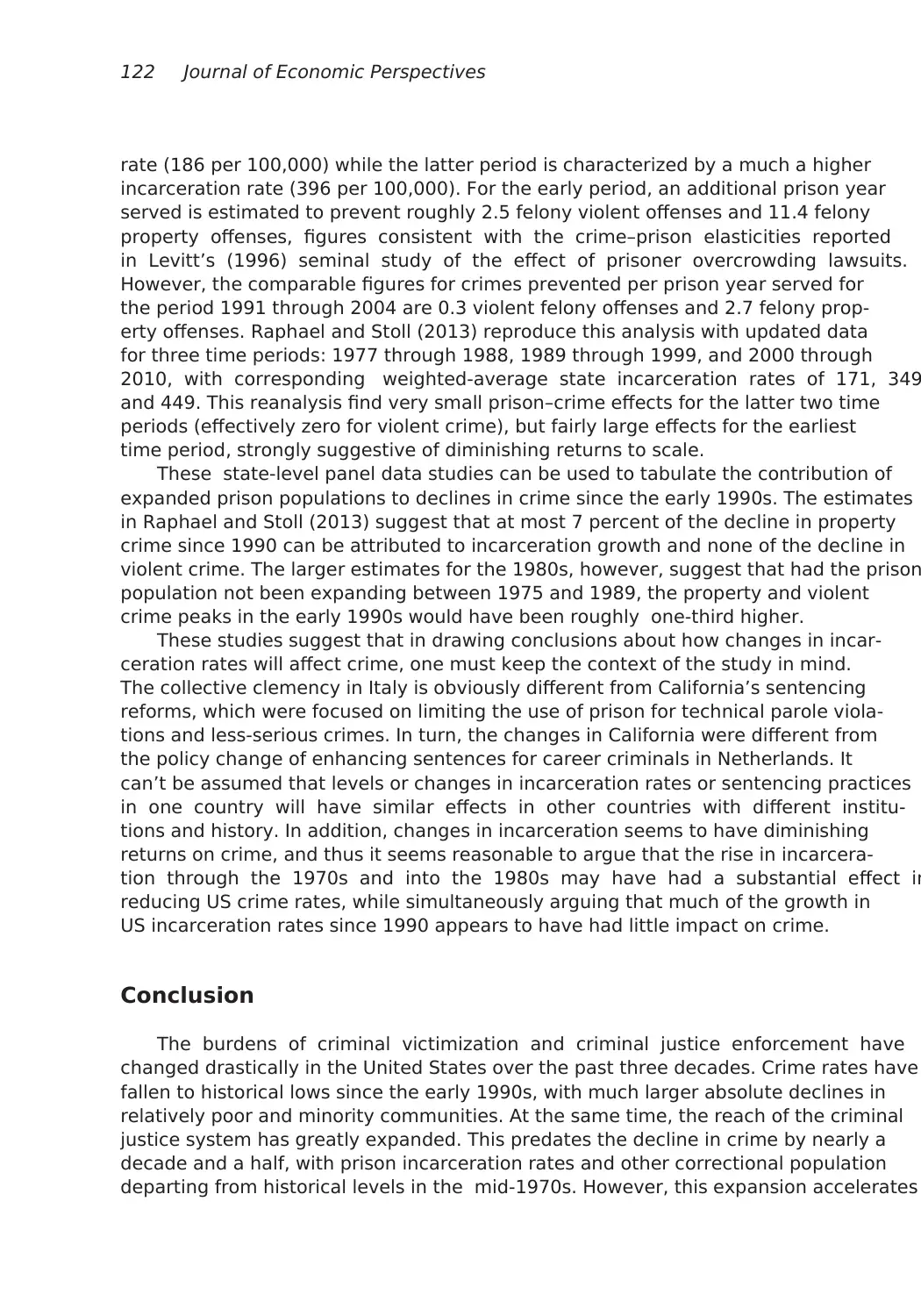
122 Journal of Economic Perspectives
rate (186 per 100,000) while the latter period is characterized by a much a higher
incarceration rate (396 per 100,000). For the early period, an additional prison year
served is estimated to prevent roughly 2.5 felony violent offenses and 11.4 felony
property offenses, figures consistent with the crime–prison elasticities reported
in Levitt’s (1996) seminal study of the effect of prisoner overcrowding lawsuits.
However, the comparable figures for crimes prevented per prison year served for
the period 1991 through 2004 are 0.3 violent felony offenses and 2.7 felony prop-
erty offenses. Raphael and Stoll (2013) reproduce this analysis with updated data
for three time periods: 1977 through 1988, 1989 through 1999, and 2000 through
2010, with corresponding weighted-average state incarceration rates of 171, 349
and 449. This reanalysis find very small prison–crime effects for the latter two time
periods (effectively zero for violent crime), but fairly large effects for the earliest
time period, strongly suggestive of diminishing returns to scale.
These state-level panel data studies can be used to tabulate the contribution of
expanded prison populations to declines in crime since the early 1990s. The estimates
in Raphael and Stoll (2013) suggest that at most 7 percent of the decline in property
crime since 1990 can be attributed to incarceration growth and none of the decline in
violent crime. The larger estimates for the 1980s, however, suggest that had the prison
population not been expanding between 1975 and 1989, the property and violent
crime peaks in the early 1990s would have been roughly one-third higher.
These studies suggest that in drawing conclusions about how changes in incar-
ceration rates will affect crime, one must keep the context of the study in mind.
The collective clemency in Italy is obviously different from California’s sentencing
reforms, which were focused on limiting the use of prison for technical parole viola-
tions and less-serious crimes. In turn, the changes in California were different from
the policy change of enhancing sentences for career criminals in Netherlands. It
can’t be assumed that levels or changes in incarceration rates or sentencing practices
in one country will have similar effects in other countries with different institu-
tions and history. In addition, changes in incarceration seems to have diminishing
returns on crime, and thus it seems reasonable to argue that the rise in incarcera-
tion through the 1970s and into the 1980s may have had a substantial effect in
reducing US crime rates, while simultaneously arguing that much of the growth in
US incarceration rates since 1990 appears to have had little impact on crime.
Conclusion
The burdens of criminal victimization and criminal justice enforcement have
changed drastically in the United States over the past three decades. Crime rates have
fallen to historical lows since the early 1990s, with much larger absolute declines in
relatively poor and minority communities. At the same time, the reach of the criminal
justice system has greatly expanded. This predates the decline in crime by nearly a
decade and a half, with prison incarceration rates and other correctional population
departing from historical levels in the mid-1970s. However, this expansion accelerates
rate (186 per 100,000) while the latter period is characterized by a much a higher
incarceration rate (396 per 100,000). For the early period, an additional prison year
served is estimated to prevent roughly 2.5 felony violent offenses and 11.4 felony
property offenses, figures consistent with the crime–prison elasticities reported
in Levitt’s (1996) seminal study of the effect of prisoner overcrowding lawsuits.
However, the comparable figures for crimes prevented per prison year served for
the period 1991 through 2004 are 0.3 violent felony offenses and 2.7 felony prop-
erty offenses. Raphael and Stoll (2013) reproduce this analysis with updated data
for three time periods: 1977 through 1988, 1989 through 1999, and 2000 through
2010, with corresponding weighted-average state incarceration rates of 171, 349
and 449. This reanalysis find very small prison–crime effects for the latter two time
periods (effectively zero for violent crime), but fairly large effects for the earliest
time period, strongly suggestive of diminishing returns to scale.
These state-level panel data studies can be used to tabulate the contribution of
expanded prison populations to declines in crime since the early 1990s. The estimates
in Raphael and Stoll (2013) suggest that at most 7 percent of the decline in property
crime since 1990 can be attributed to incarceration growth and none of the decline in
violent crime. The larger estimates for the 1980s, however, suggest that had the prison
population not been expanding between 1975 and 1989, the property and violent
crime peaks in the early 1990s would have been roughly one-third higher.
These studies suggest that in drawing conclusions about how changes in incar-
ceration rates will affect crime, one must keep the context of the study in mind.
The collective clemency in Italy is obviously different from California’s sentencing
reforms, which were focused on limiting the use of prison for technical parole viola-
tions and less-serious crimes. In turn, the changes in California were different from
the policy change of enhancing sentences for career criminals in Netherlands. It
can’t be assumed that levels or changes in incarceration rates or sentencing practices
in one country will have similar effects in other countries with different institu-
tions and history. In addition, changes in incarceration seems to have diminishing
returns on crime, and thus it seems reasonable to argue that the rise in incarcera-
tion through the 1970s and into the 1980s may have had a substantial effect in
reducing US crime rates, while simultaneously arguing that much of the growth in
US incarceration rates since 1990 appears to have had little impact on crime.
Conclusion
The burdens of criminal victimization and criminal justice enforcement have
changed drastically in the United States over the past three decades. Crime rates have
fallen to historical lows since the early 1990s, with much larger absolute declines in
relatively poor and minority communities. At the same time, the reach of the criminal
justice system has greatly expanded. This predates the decline in crime by nearly a
decade and a half, with prison incarceration rates and other correctional population
departing from historical levels in the mid-1970s. However, this expansion accelerates
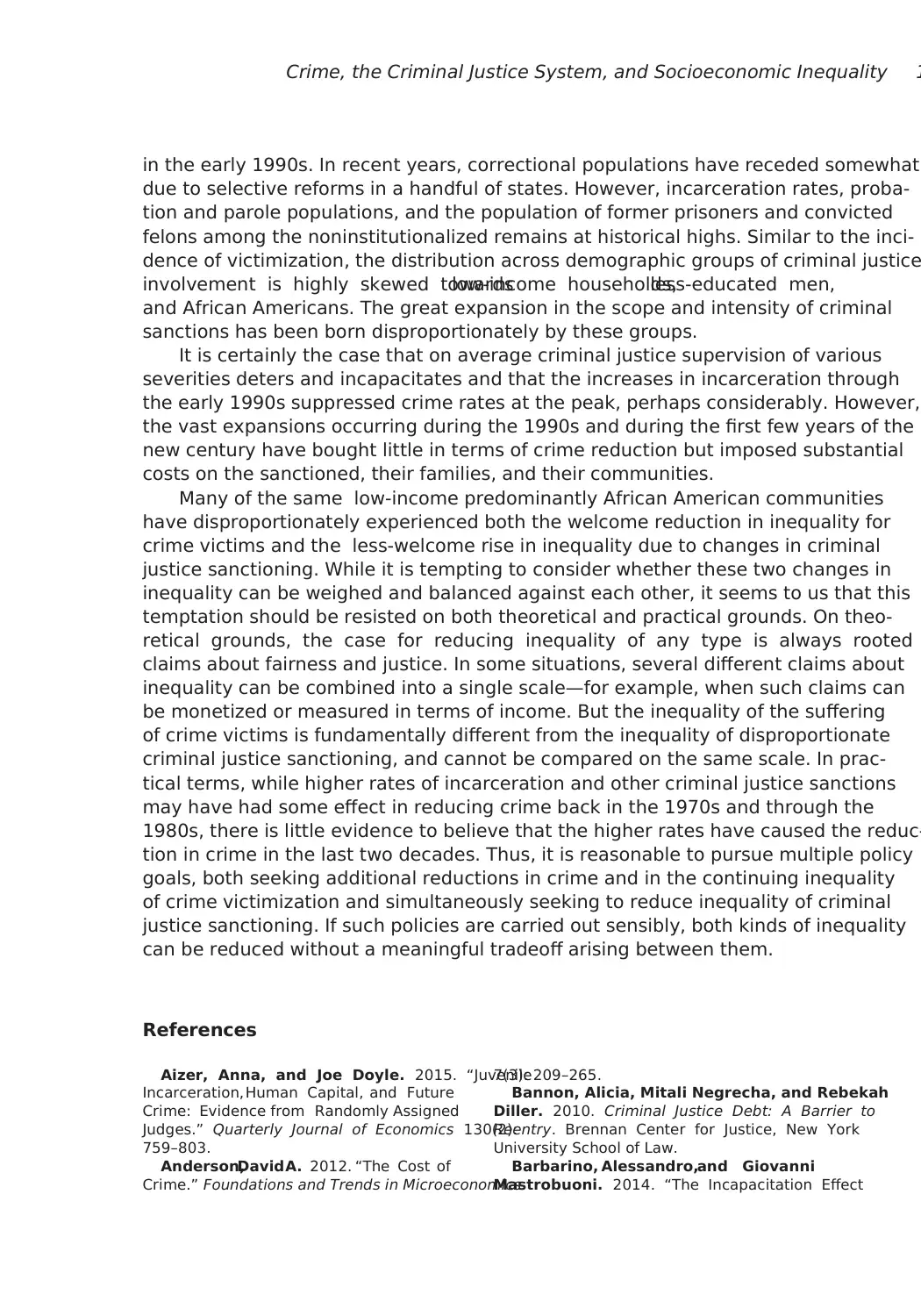
Crime, the Criminal Justice System, and Socioeconomic Inequality 1
in the early 1990s. In recent years, correctional populations have receded somewhat,
due to selective reforms in a handful of states. However, incarceration rates, proba-
tion and parole populations, and the population of former prisoners and convicted
felons among the noninstitutionalized remains at historical highs. Similar to the inci-
dence of victimization, the distribution across demographic groups of criminal justice
involvement is highly skewed towardslow-income households,less-educated men,
and African Americans. The great expansion in the scope and intensity of criminal
sanctions has been born disproportionately by these groups.
It is certainly the case that on average criminal justice supervision of various
severities deters and incapacitates and that the increases in incarceration through
the early 1990s suppressed crime rates at the peak, perhaps considerably. However,
the vast expansions occurring during the 1990s and during the first few years of the
new century have bought little in terms of crime reduction but imposed substantial
costs on the sanctioned, their families, and their communities.
Many of the same low-income predominantly African American communities
have disproportionately experienced both the welcome reduction in inequality for
crime victims and the less-welcome rise in inequality due to changes in criminal
justice sanctioning. While it is tempting to consider whether these two changes in
inequality can be weighed and balanced against each other, it seems to us that this
temptation should be resisted on both theoretical and practical grounds. On theo-
retical grounds, the case for reducing inequality of any type is always rooted
claims about fairness and justice. In some situations, several different claims about
inequality can be combined into a single scale—for example, when such claims can
be monetized or measured in terms of income. But the inequality of the suffering
of crime victims is fundamentally different from the inequality of disproportionate
criminal justice sanctioning, and cannot be compared on the same scale. In prac-
tical terms, while higher rates of incarceration and other criminal justice sanctions
may have had some effect in reducing crime back in the 1970s and through the
1980s, there is little evidence to believe that the higher rates have caused the reduc-
tion in crime in the last two decades. Thus, it is reasonable to pursue multiple policy
goals, both seeking additional reductions in crime and in the continuing inequality
of crime victimization and simultaneously seeking to reduce inequality of criminal
justice sanctioning. If such policies are carried out sensibly, both kinds of inequality
can be reduced without a meaningful tradeoff arising between them.
References
Aizer, Anna, and Joe Doyle. 2015. “Juvenile
Incarceration, Human Capital, and Future
Crime: Evidence from Randomly Assigned
Judges.” Quarterly Journal of Economics 130(2):
759–803.
Anderson,David A. 2012. “The Cost of
Crime.” Foundations and Trends in Microeconomics
7(3): 209–265.
Bannon, Alicia, Mitali Negrecha, and Rebekah
Diller. 2010. Criminal Justice Debt: A Barrier to
Reentry. Brennan Center for Justice, New York
University School of Law.
Barbarino, Alessandro,and Giovanni
Mastrobuoni. 2014. “The Incapacitation Effect
in the early 1990s. In recent years, correctional populations have receded somewhat,
due to selective reforms in a handful of states. However, incarceration rates, proba-
tion and parole populations, and the population of former prisoners and convicted
felons among the noninstitutionalized remains at historical highs. Similar to the inci-
dence of victimization, the distribution across demographic groups of criminal justice
involvement is highly skewed towardslow-income households,less-educated men,
and African Americans. The great expansion in the scope and intensity of criminal
sanctions has been born disproportionately by these groups.
It is certainly the case that on average criminal justice supervision of various
severities deters and incapacitates and that the increases in incarceration through
the early 1990s suppressed crime rates at the peak, perhaps considerably. However,
the vast expansions occurring during the 1990s and during the first few years of the
new century have bought little in terms of crime reduction but imposed substantial
costs on the sanctioned, their families, and their communities.
Many of the same low-income predominantly African American communities
have disproportionately experienced both the welcome reduction in inequality for
crime victims and the less-welcome rise in inequality due to changes in criminal
justice sanctioning. While it is tempting to consider whether these two changes in
inequality can be weighed and balanced against each other, it seems to us that this
temptation should be resisted on both theoretical and practical grounds. On theo-
retical grounds, the case for reducing inequality of any type is always rooted
claims about fairness and justice. In some situations, several different claims about
inequality can be combined into a single scale—for example, when such claims can
be monetized or measured in terms of income. But the inequality of the suffering
of crime victims is fundamentally different from the inequality of disproportionate
criminal justice sanctioning, and cannot be compared on the same scale. In prac-
tical terms, while higher rates of incarceration and other criminal justice sanctions
may have had some effect in reducing crime back in the 1970s and through the
1980s, there is little evidence to believe that the higher rates have caused the reduc-
tion in crime in the last two decades. Thus, it is reasonable to pursue multiple policy
goals, both seeking additional reductions in crime and in the continuing inequality
of crime victimization and simultaneously seeking to reduce inequality of criminal
justice sanctioning. If such policies are carried out sensibly, both kinds of inequality
can be reduced without a meaningful tradeoff arising between them.
References
Aizer, Anna, and Joe Doyle. 2015. “Juvenile
Incarceration, Human Capital, and Future
Crime: Evidence from Randomly Assigned
Judges.” Quarterly Journal of Economics 130(2):
759–803.
Anderson,David A. 2012. “The Cost of
Crime.” Foundations and Trends in Microeconomics
7(3): 209–265.
Bannon, Alicia, Mitali Negrecha, and Rebekah
Diller. 2010. Criminal Justice Debt: A Barrier to
Reentry. Brennan Center for Justice, New York
University School of Law.
Barbarino, Alessandro,and Giovanni
Mastrobuoni. 2014. “The Incapacitation Effect
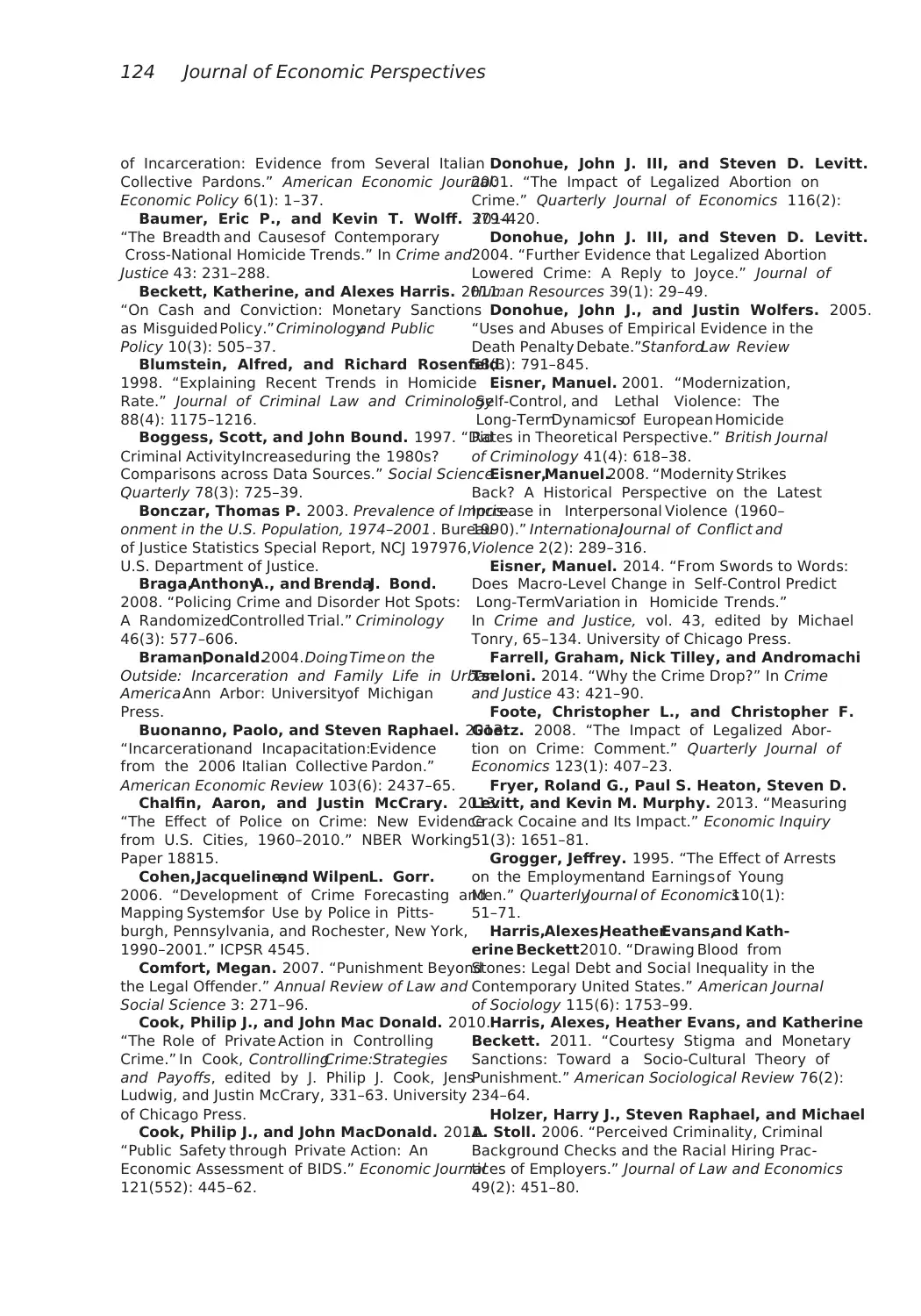
124 Journal of Economic Perspectives
of Incarceration: Evidence from Several Italian
Collective Pardons.” American Economic Journal:
Economic Policy 6(1): 1–37.
Baumer, Eric P., and Kevin T. Wolff. 2014.
“The Breadth and Causes of Contemporary
Cross-National Homicide Trends.” In Crime and
Justice 43: 231–288.
Beckett, Katherine, and Alexes Harris. 2011.
“On Cash and Conviction: Monetary Sanctions
as Misguided Policy.” Criminologyand Public
Policy 10(3): 505–37.
Blumstein, Alfred, and Richard Rosenfeld.
1998. “Explaining Recent Trends in Homicide
Rate.” Journal of Criminal Law and Criminology
88(4): 1175–1216.
Boggess, Scott, and John Bound. 1997. “Did
Criminal ActivityIncreaseduring the 1980s?
Comparisons across Data Sources.” Social Science
Quarterly 78(3): 725–39.
Bonczar, Thomas P. 2003. Prevalence of Impris-
onment in the U.S. Population, 1974–2001. Bureau
of Justice Statistics Special Report, NCJ 197976,
U.S. Department of Justice.
Braga,AnthonyA., and BrendaJ. Bond.
2008. “Policing Crime and Disorder Hot Spots:
A RandomizedControlled Trial.” Criminology
46(3): 577–606.
Braman,Donald.2004. Doing Time on the
Outside: Incarceration and Family Life in Urban
America.Ann Arbor: Universityof Michigan
Press.
Buonanno, Paolo, and Steven Raphael. 2013.
“Incarcerationand Incapacitation:Evidence
from the 2006 Italian Collective Pardon.”
American Economic Review 103(6): 2437–65.
Chalfin, Aaron, and Justin McCrary. 2013.
“The Effect of Police on Crime: New Evidence
from U.S. Cities, 1960–2010.” NBER Working
Paper 18815.
Cohen,Jacqueline,and WilpenL. Gorr.
2006. “Development of Crime Forecasting and
Mapping Systemsfor Use by Police in Pitts-
burgh, Pennsylvania, and Rochester, New York,
1990–2001.” ICPSR 4545.
Comfort, Megan. 2007. “Punishment Beyond
the Legal Offender.” Annual Review of Law and
Social Science 3: 271–96.
Cook, Philip J., and John Mac Donald. 2010.
“The Role of Private Action in Controlling
Crime.” In Cook, ControllingCrime:Strategies
and Payoffs, edited by J. Philip J. Cook, Jens
Ludwig, and Justin McCrary, 331–63. University
of Chicago Press.
Cook, Philip J., and John MacDonald. 2011.
“Public Safety through Private Action: An
Economic Assessment of BIDS.” Economic Journal
121(552): 445–62.
Donohue, John J. III, and Steven D. Levitt.
2001. “The Impact of Legalized Abortion on
Crime.” Quarterly Journal of Economics 116(2):
379–420.
Donohue, John J. III, and Steven D. Levitt.
2004. “Further Evidence that Legalized Abortion
Lowered Crime: A Reply to Joyce.” Journal of
Human Resources 39(1): 29–49.
Donohue, John J., and Justin Wolfers. 2005.
“Uses and Abuses of Empirical Evidence in the
Death Penalty Debate.”StanfordLaw Review
58(3): 791–845.
Eisner, Manuel. 2001. “Modernization,
Self-Control, and Lethal Violence: The
Long-TermDynamicsof European Homicide
Rates in Theoretical Perspective.” British Journal
of Criminology 41(4): 618–38.
Eisner,Manuel.2008. “Modernity Strikes
Back? A Historical Perspective on the Latest
Increase in Interpersonal Violence (1960–
1990).” InternationalJournal of Conflict and
Violence 2(2): 289–316.
Eisner, Manuel. 2014. “From Swords to Words:
Does Macro-Level Change in Self-Control Predict
Long-TermVariation in Homicide Trends.”
In Crime and Justice, vol. 43, edited by Michael
Tonry, 65–134. University of Chicago Press.
Farrell, Graham, Nick Tilley, and Andromachi
Tseloni. 2014. “Why the Crime Drop?” In Crime
and Justice 43: 421–90.
Foote, Christopher L., and Christopher F.
Goetz. 2008. “The Impact of Legalized Abor-
tion on Crime: Comment.” Quarterly Journal of
Economics 123(1): 407–23.
Fryer, Roland G., Paul S. Heaton, Steven D.
Levitt, and Kevin M. Murphy. 2013. “Measuring
Crack Cocaine and Its Impact.” Economic Inquiry
51(3): 1651–81.
Grogger, Jeffrey. 1995. “The Effect of Arrests
on the Employmentand Earnings of Young
Men.” QuarterlyJournal of Economics110(1):
51–71.
Harris,Alexes,HeatherEvans,and Kath-
erine Beckett.2010. “Drawing Blood from
Stones: Legal Debt and Social Inequality in the
Contemporary United States.” American Journal
of Sociology 115(6): 1753–99.
Harris, Alexes, Heather Evans, and Katherine
Beckett. 2011. “Courtesy Stigma and Monetary
Sanctions: Toward a Socio-Cultural Theory of
Punishment.” American Sociological Review 76(2):
234–64.
Holzer, Harry J., Steven Raphael, and Michael
A. Stoll. 2006. “Perceived Criminality, Criminal
Background Checks and the Racial Hiring Prac-
tices of Employers.” Journal of Law and Economics
49(2): 451–80.
of Incarceration: Evidence from Several Italian
Collective Pardons.” American Economic Journal:
Economic Policy 6(1): 1–37.
Baumer, Eric P., and Kevin T. Wolff. 2014.
“The Breadth and Causes of Contemporary
Cross-National Homicide Trends.” In Crime and
Justice 43: 231–288.
Beckett, Katherine, and Alexes Harris. 2011.
“On Cash and Conviction: Monetary Sanctions
as Misguided Policy.” Criminologyand Public
Policy 10(3): 505–37.
Blumstein, Alfred, and Richard Rosenfeld.
1998. “Explaining Recent Trends in Homicide
Rate.” Journal of Criminal Law and Criminology
88(4): 1175–1216.
Boggess, Scott, and John Bound. 1997. “Did
Criminal ActivityIncreaseduring the 1980s?
Comparisons across Data Sources.” Social Science
Quarterly 78(3): 725–39.
Bonczar, Thomas P. 2003. Prevalence of Impris-
onment in the U.S. Population, 1974–2001. Bureau
of Justice Statistics Special Report, NCJ 197976,
U.S. Department of Justice.
Braga,AnthonyA., and BrendaJ. Bond.
2008. “Policing Crime and Disorder Hot Spots:
A RandomizedControlled Trial.” Criminology
46(3): 577–606.
Braman,Donald.2004. Doing Time on the
Outside: Incarceration and Family Life in Urban
America.Ann Arbor: Universityof Michigan
Press.
Buonanno, Paolo, and Steven Raphael. 2013.
“Incarcerationand Incapacitation:Evidence
from the 2006 Italian Collective Pardon.”
American Economic Review 103(6): 2437–65.
Chalfin, Aaron, and Justin McCrary. 2013.
“The Effect of Police on Crime: New Evidence
from U.S. Cities, 1960–2010.” NBER Working
Paper 18815.
Cohen,Jacqueline,and WilpenL. Gorr.
2006. “Development of Crime Forecasting and
Mapping Systemsfor Use by Police in Pitts-
burgh, Pennsylvania, and Rochester, New York,
1990–2001.” ICPSR 4545.
Comfort, Megan. 2007. “Punishment Beyond
the Legal Offender.” Annual Review of Law and
Social Science 3: 271–96.
Cook, Philip J., and John Mac Donald. 2010.
“The Role of Private Action in Controlling
Crime.” In Cook, ControllingCrime:Strategies
and Payoffs, edited by J. Philip J. Cook, Jens
Ludwig, and Justin McCrary, 331–63. University
of Chicago Press.
Cook, Philip J., and John MacDonald. 2011.
“Public Safety through Private Action: An
Economic Assessment of BIDS.” Economic Journal
121(552): 445–62.
Donohue, John J. III, and Steven D. Levitt.
2001. “The Impact of Legalized Abortion on
Crime.” Quarterly Journal of Economics 116(2):
379–420.
Donohue, John J. III, and Steven D. Levitt.
2004. “Further Evidence that Legalized Abortion
Lowered Crime: A Reply to Joyce.” Journal of
Human Resources 39(1): 29–49.
Donohue, John J., and Justin Wolfers. 2005.
“Uses and Abuses of Empirical Evidence in the
Death Penalty Debate.”StanfordLaw Review
58(3): 791–845.
Eisner, Manuel. 2001. “Modernization,
Self-Control, and Lethal Violence: The
Long-TermDynamicsof European Homicide
Rates in Theoretical Perspective.” British Journal
of Criminology 41(4): 618–38.
Eisner,Manuel.2008. “Modernity Strikes
Back? A Historical Perspective on the Latest
Increase in Interpersonal Violence (1960–
1990).” InternationalJournal of Conflict and
Violence 2(2): 289–316.
Eisner, Manuel. 2014. “From Swords to Words:
Does Macro-Level Change in Self-Control Predict
Long-TermVariation in Homicide Trends.”
In Crime and Justice, vol. 43, edited by Michael
Tonry, 65–134. University of Chicago Press.
Farrell, Graham, Nick Tilley, and Andromachi
Tseloni. 2014. “Why the Crime Drop?” In Crime
and Justice 43: 421–90.
Foote, Christopher L., and Christopher F.
Goetz. 2008. “The Impact of Legalized Abor-
tion on Crime: Comment.” Quarterly Journal of
Economics 123(1): 407–23.
Fryer, Roland G., Paul S. Heaton, Steven D.
Levitt, and Kevin M. Murphy. 2013. “Measuring
Crack Cocaine and Its Impact.” Economic Inquiry
51(3): 1651–81.
Grogger, Jeffrey. 1995. “The Effect of Arrests
on the Employmentand Earnings of Young
Men.” QuarterlyJournal of Economics110(1):
51–71.
Harris,Alexes,HeatherEvans,and Kath-
erine Beckett.2010. “Drawing Blood from
Stones: Legal Debt and Social Inequality in the
Contemporary United States.” American Journal
of Sociology 115(6): 1753–99.
Harris, Alexes, Heather Evans, and Katherine
Beckett. 2011. “Courtesy Stigma and Monetary
Sanctions: Toward a Socio-Cultural Theory of
Punishment.” American Sociological Review 76(2):
234–64.
Holzer, Harry J., Steven Raphael, and Michael
A. Stoll. 2006. “Perceived Criminality, Criminal
Background Checks and the Racial Hiring Prac-
tices of Employers.” Journal of Law and Economics
49(2): 451–80.
Secure Best Marks with AI Grader
Need help grading? Try our AI Grader for instant feedback on your assignments.
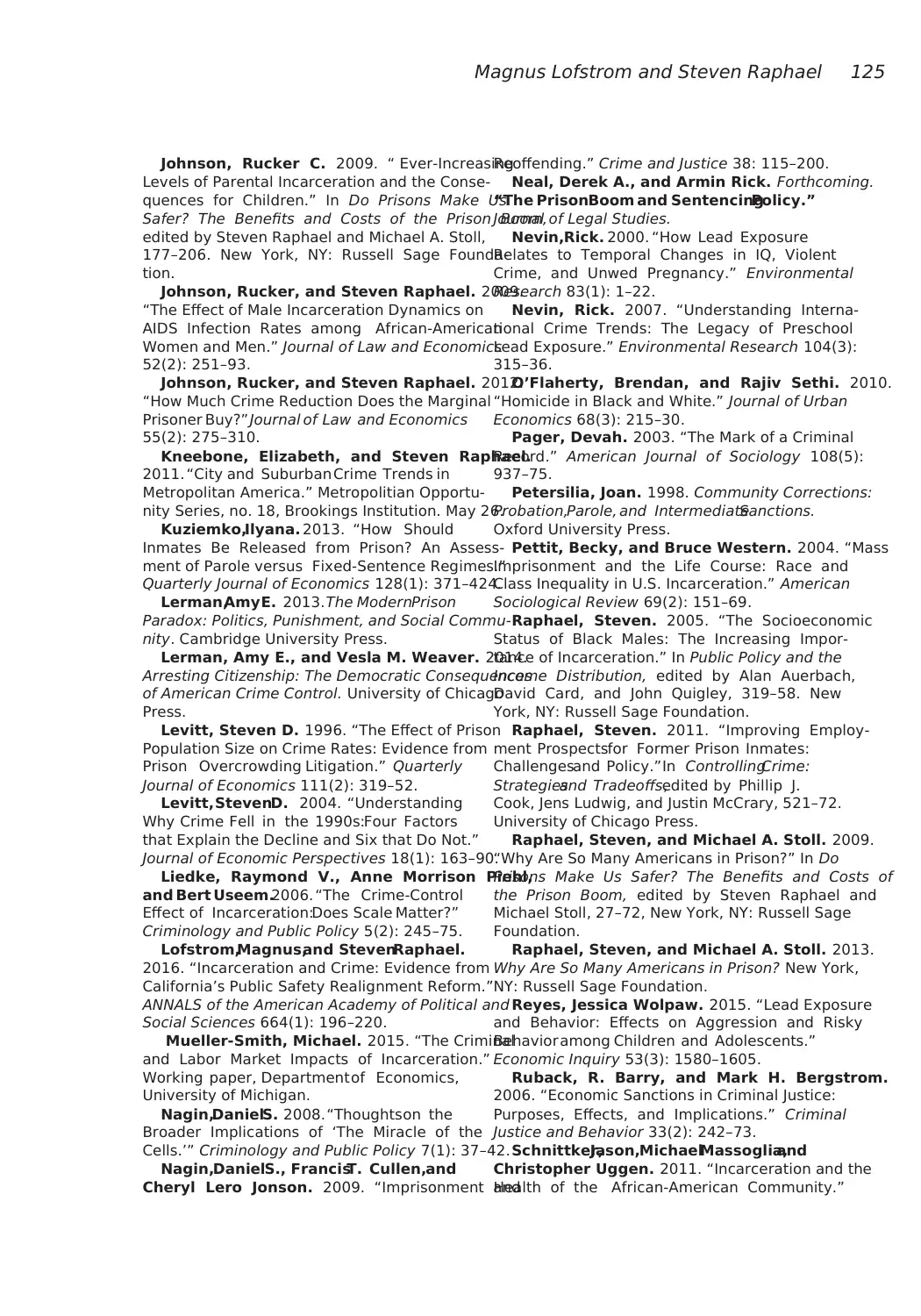
Magnus Lofstrom and Steven Raphael 125
Johnson, Rucker C. 2009. “ Ever-Increasing
Levels of Parental Incarceration and the Conse-
quences for Children.” In Do Prisons Make Us
Safer? The Benefits and Costs of the Prison Boom,
edited by Steven Raphael and Michael A. Stoll,
177–206. New York, NY: Russell Sage Founda-
tion.
Johnson, Rucker, and Steven Raphael. 2009.
“The Effect of Male Incarceration Dynamics on
AIDS Infection Rates among African-American
Women and Men.” Journal of Law and Economics
52(2): 251–93.
Johnson, Rucker, and Steven Raphael. 2012.
“How Much Crime Reduction Does the Marginal
Prisoner Buy?” Journal of Law and Economics
55(2): 275–310.
Kneebone, Elizabeth, and Steven Raphael.
2011. “City and Suburban Crime Trends in
Metropolitan America.” Metropolitian Opportu-
nity Series, no. 18, Brookings Institution. May 26.
Kuziemko,Ilyana. 2013. “How Should
Inmates Be Released from Prison? An Assess-
ment of Parole versus Fixed-Sentence Regimes.”
Quarterly Journal of Economics 128(1): 371–424.
Lerman,Amy E. 2013. The ModernPrison
Paradox: Politics, Punishment, and Social Commu-
nity. Cambridge University Press.
Lerman, Amy E., and Vesla M. Weaver. 2014.
Arresting Citizenship: The Democratic Consequences
of American Crime Control. University of Chicago
Press.
Levitt, Steven D. 1996. “The Effect of Prison
Population Size on Crime Rates: Evidence from
Prison Overcrowding Litigation.” Quarterly
Journal of Economics 111(2): 319–52.
Levitt, StevenD. 2004. “Understanding
Why Crime Fell in the 1990s:Four Factors
that Explain the Decline and Six that Do Not.”
Journal of Economic Perspectives 18(1): 163–90.
Liedke, Raymond V., Anne Morrison Piehl,
and Bert Useem.2006. “The Crime-Control
Effect of Incarceration:Does Scale Matter?”
Criminology and Public Policy 5(2): 245–75.
Lofstrom,Magnus,and StevenRaphael.
2016. “Incarceration and Crime: Evidence from
California’s Public Safety Realignment Reform.”
ANNALS of the American Academy of Political and
Social Sciences 664(1): 196–220.
Mueller-Smith, Michael. 2015. “The Criminal
and Labor Market Impacts of Incarceration.”
Working paper, Department of Economics,
University of Michigan.
Nagin,DanielS. 2008. “Thoughts on the
Broader Implications of ‘The Miracle of the
Cells.’” Criminology and Public Policy 7(1): 37–42.
Nagin,DanielS., FrancisT. Cullen,and
Cheryl Lero Jonson. 2009. “Imprisonment and
Reoffending.” Crime and Justice 38: 115–200.
Neal, Derek A., and Armin Rick. Forthcoming.
“The PrisonBoom and SentencingPolicy.”
Journal of Legal Studies.
Nevin,Rick. 2000. “How Lead Exposure
Relates to Temporal Changes in IQ, Violent
Crime, and Unwed Pregnancy.” Environmental
Research 83(1): 1–22.
Nevin, Rick. 2007. “Understanding Interna-
tional Crime Trends: The Legacy of Preschool
Lead Exposure.” Environmental Research 104(3):
315–36.
O’Flaherty, Brendan, and Rajiv Sethi. 2010.
“Homicide in Black and White.” Journal of Urban
Economics 68(3): 215–30.
Pager, Devah. 2003. “The Mark of a Criminal
Record.” American Journal of Sociology 108(5):
937–75.
Petersilia, Joan. 1998. Community Corrections:
Probation,Parole, and IntermediateSanctions.
Oxford University Press.
Pettit, Becky, and Bruce Western. 2004. “Mass
Imprisonment and the Life Course: Race and
Class Inequality in U.S. Incarceration.” American
Sociological Review 69(2): 151–69.
Raphael, Steven. 2005. “The Socioeconomic
Status of Black Males: The Increasing Impor-
tance of Incarceration.” In Public Policy and the
Income Distribution, edited by Alan Auerbach,
David Card, and John Quigley, 319–58. New
York, NY: Russell Sage Foundation.
Raphael, Steven. 2011. “Improving Employ-
ment Prospectsfor Former Prison Inmates:
Challengesand Policy.” In ControllingCrime:
Strategiesand Tradeoffs,edited by Phillip J.
Cook, Jens Ludwig, and Justin McCrary, 521–72.
University of Chicago Press.
Raphael, Steven, and Michael A. Stoll. 2009.
“Why Are So Many Americans in Prison?” In Do
Prisons Make Us Safer? The Benefits and Costs of
the Prison Boom, edited by Steven Raphael and
Michael Stoll, 27–72, New York, NY: Russell Sage
Foundation.
Raphael, Steven, and Michael A. Stoll. 2013.
Why Are So Many Americans in Prison? New York,
NY: Russell Sage Foundation.
Reyes, Jessica Wolpaw. 2015. “Lead Exposure
and Behavior: Effects on Aggression and Risky
Behavior among Children and Adolescents.”
Economic Inquiry 53(3): 1580–1605.
Ruback, R. Barry, and Mark H. Bergstrom.
2006. “Economic Sanctions in Criminal Justice:
Purposes, Effects, and Implications.” Criminal
Justice and Behavior 33(2): 242–73.
Schnittker,Jason,MichaelMassoglia,and
Christopher Uggen. 2011. “Incarceration and the
Health of the African-American Community.”
Johnson, Rucker C. 2009. “ Ever-Increasing
Levels of Parental Incarceration and the Conse-
quences for Children.” In Do Prisons Make Us
Safer? The Benefits and Costs of the Prison Boom,
edited by Steven Raphael and Michael A. Stoll,
177–206. New York, NY: Russell Sage Founda-
tion.
Johnson, Rucker, and Steven Raphael. 2009.
“The Effect of Male Incarceration Dynamics on
AIDS Infection Rates among African-American
Women and Men.” Journal of Law and Economics
52(2): 251–93.
Johnson, Rucker, and Steven Raphael. 2012.
“How Much Crime Reduction Does the Marginal
Prisoner Buy?” Journal of Law and Economics
55(2): 275–310.
Kneebone, Elizabeth, and Steven Raphael.
2011. “City and Suburban Crime Trends in
Metropolitan America.” Metropolitian Opportu-
nity Series, no. 18, Brookings Institution. May 26.
Kuziemko,Ilyana. 2013. “How Should
Inmates Be Released from Prison? An Assess-
ment of Parole versus Fixed-Sentence Regimes.”
Quarterly Journal of Economics 128(1): 371–424.
Lerman,Amy E. 2013. The ModernPrison
Paradox: Politics, Punishment, and Social Commu-
nity. Cambridge University Press.
Lerman, Amy E., and Vesla M. Weaver. 2014.
Arresting Citizenship: The Democratic Consequences
of American Crime Control. University of Chicago
Press.
Levitt, Steven D. 1996. “The Effect of Prison
Population Size on Crime Rates: Evidence from
Prison Overcrowding Litigation.” Quarterly
Journal of Economics 111(2): 319–52.
Levitt, StevenD. 2004. “Understanding
Why Crime Fell in the 1990s:Four Factors
that Explain the Decline and Six that Do Not.”
Journal of Economic Perspectives 18(1): 163–90.
Liedke, Raymond V., Anne Morrison Piehl,
and Bert Useem.2006. “The Crime-Control
Effect of Incarceration:Does Scale Matter?”
Criminology and Public Policy 5(2): 245–75.
Lofstrom,Magnus,and StevenRaphael.
2016. “Incarceration and Crime: Evidence from
California’s Public Safety Realignment Reform.”
ANNALS of the American Academy of Political and
Social Sciences 664(1): 196–220.
Mueller-Smith, Michael. 2015. “The Criminal
and Labor Market Impacts of Incarceration.”
Working paper, Department of Economics,
University of Michigan.
Nagin,DanielS. 2008. “Thoughts on the
Broader Implications of ‘The Miracle of the
Cells.’” Criminology and Public Policy 7(1): 37–42.
Nagin,DanielS., FrancisT. Cullen,and
Cheryl Lero Jonson. 2009. “Imprisonment and
Reoffending.” Crime and Justice 38: 115–200.
Neal, Derek A., and Armin Rick. Forthcoming.
“The PrisonBoom and SentencingPolicy.”
Journal of Legal Studies.
Nevin,Rick. 2000. “How Lead Exposure
Relates to Temporal Changes in IQ, Violent
Crime, and Unwed Pregnancy.” Environmental
Research 83(1): 1–22.
Nevin, Rick. 2007. “Understanding Interna-
tional Crime Trends: The Legacy of Preschool
Lead Exposure.” Environmental Research 104(3):
315–36.
O’Flaherty, Brendan, and Rajiv Sethi. 2010.
“Homicide in Black and White.” Journal of Urban
Economics 68(3): 215–30.
Pager, Devah. 2003. “The Mark of a Criminal
Record.” American Journal of Sociology 108(5):
937–75.
Petersilia, Joan. 1998. Community Corrections:
Probation,Parole, and IntermediateSanctions.
Oxford University Press.
Pettit, Becky, and Bruce Western. 2004. “Mass
Imprisonment and the Life Course: Race and
Class Inequality in U.S. Incarceration.” American
Sociological Review 69(2): 151–69.
Raphael, Steven. 2005. “The Socioeconomic
Status of Black Males: The Increasing Impor-
tance of Incarceration.” In Public Policy and the
Income Distribution, edited by Alan Auerbach,
David Card, and John Quigley, 319–58. New
York, NY: Russell Sage Foundation.
Raphael, Steven. 2011. “Improving Employ-
ment Prospectsfor Former Prison Inmates:
Challengesand Policy.” In ControllingCrime:
Strategiesand Tradeoffs,edited by Phillip J.
Cook, Jens Ludwig, and Justin McCrary, 521–72.
University of Chicago Press.
Raphael, Steven, and Michael A. Stoll. 2009.
“Why Are So Many Americans in Prison?” In Do
Prisons Make Us Safer? The Benefits and Costs of
the Prison Boom, edited by Steven Raphael and
Michael Stoll, 27–72, New York, NY: Russell Sage
Foundation.
Raphael, Steven, and Michael A. Stoll. 2013.
Why Are So Many Americans in Prison? New York,
NY: Russell Sage Foundation.
Reyes, Jessica Wolpaw. 2015. “Lead Exposure
and Behavior: Effects on Aggression and Risky
Behavior among Children and Adolescents.”
Economic Inquiry 53(3): 1580–1605.
Ruback, R. Barry, and Mark H. Bergstrom.
2006. “Economic Sanctions in Criminal Justice:
Purposes, Effects, and Implications.” Criminal
Justice and Behavior 33(2): 242–73.
Schnittker,Jason,MichaelMassoglia,and
Christopher Uggen. 2011. “Incarceration and the
Health of the African-American Community.”
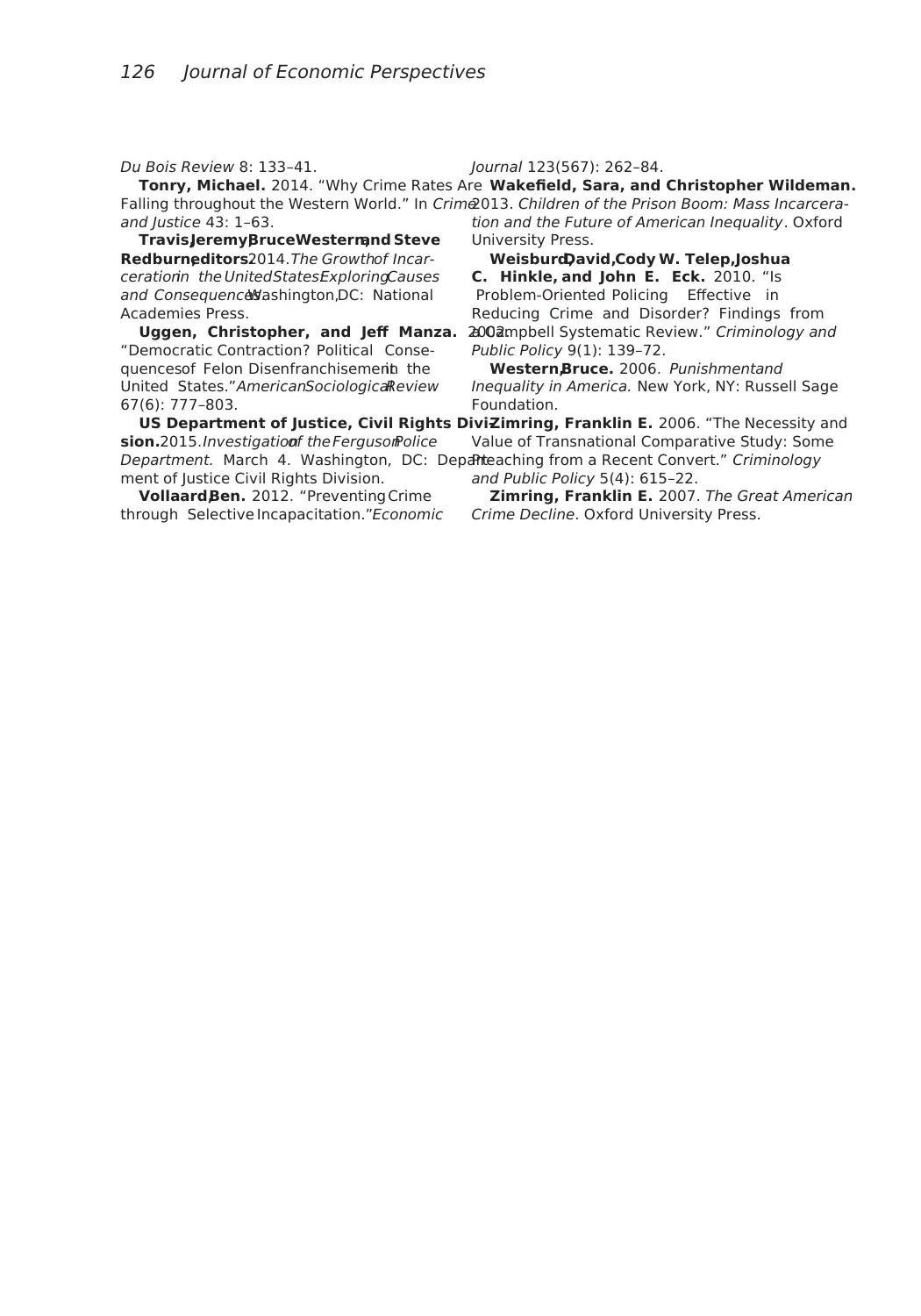
126 Journal of Economic Perspectives
Du Bois Review 8: 133–41.
Tonry, Michael. 2014. “Why Crime Rates Are
Falling throughout the Western World.” In Crime
and Justice 43: 1–63.
Travis,Jeremy,BruceWestern,and Steve
Redburn,editors.2014. The Growthof Incar-
cerationin the United States:ExploringCauses
and Consequences.Washington,DC: National
Academies Press.
Uggen, Christopher, and Jeff Manza. 2002.
“Democratic Contraction? Political Conse-
quencesof Felon Disenfranchisementin the
United States.”AmericanSociologicalReview
67(6): 777–803.
US Department of Justice, Civil Rights Divi-
sion.2015. Investigationof the FergusonPolice
Department. March 4. Washington, DC: Depart-
ment of Justice Civil Rights Division.
Vollaard,Ben. 2012. “Preventing Crime
through Selective Incapacitation.”Economic
Journal 123(567): 262–84.
Wakefield, Sara, and Christopher Wildeman.
2013. Children of the Prison Boom: Mass Incarcera-
tion and the Future of American Inequality. Oxford
University Press.
Weisburd,David,Cody W. Telep,Joshua
C. Hinkle, and John E. Eck. 2010. “Is
Problem-Oriented Policing Effective in
Reducing Crime and Disorder? Findings from
a Campbell Systematic Review.” Criminology and
Public Policy 9(1): 139–72.
Western,Bruce. 2006. Punishmentand
Inequality in America. New York, NY: Russell Sage
Foundation.
Zimring, Franklin E. 2006. “The Necessity and
Value of Transnational Comparative Study: Some
Preaching from a Recent Convert.” Criminology
and Public Policy 5(4): 615–22.
Zimring, Franklin E. 2007. The Great American
Crime Decline. Oxford University Press.
Du Bois Review 8: 133–41.
Tonry, Michael. 2014. “Why Crime Rates Are
Falling throughout the Western World.” In Crime
and Justice 43: 1–63.
Travis,Jeremy,BruceWestern,and Steve
Redburn,editors.2014. The Growthof Incar-
cerationin the United States:ExploringCauses
and Consequences.Washington,DC: National
Academies Press.
Uggen, Christopher, and Jeff Manza. 2002.
“Democratic Contraction? Political Conse-
quencesof Felon Disenfranchisementin the
United States.”AmericanSociologicalReview
67(6): 777–803.
US Department of Justice, Civil Rights Divi-
sion.2015. Investigationof the FergusonPolice
Department. March 4. Washington, DC: Depart-
ment of Justice Civil Rights Division.
Vollaard,Ben. 2012. “Preventing Crime
through Selective Incapacitation.”Economic
Journal 123(567): 262–84.
Wakefield, Sara, and Christopher Wildeman.
2013. Children of the Prison Boom: Mass Incarcera-
tion and the Future of American Inequality. Oxford
University Press.
Weisburd,David,Cody W. Telep,Joshua
C. Hinkle, and John E. Eck. 2010. “Is
Problem-Oriented Policing Effective in
Reducing Crime and Disorder? Findings from
a Campbell Systematic Review.” Criminology and
Public Policy 9(1): 139–72.
Western,Bruce. 2006. Punishmentand
Inequality in America. New York, NY: Russell Sage
Foundation.
Zimring, Franklin E. 2006. “The Necessity and
Value of Transnational Comparative Study: Some
Preaching from a Recent Convert.” Criminology
and Public Policy 5(4): 615–22.
Zimring, Franklin E. 2007. The Great American
Crime Decline. Oxford University Press.
1 out of 24
Your All-in-One AI-Powered Toolkit for Academic Success.
+13062052269
info@desklib.com
Available 24*7 on WhatsApp / Email
![[object Object]](/_next/static/media/star-bottom.7253800d.svg)
Unlock your academic potential
© 2024 | Zucol Services PVT LTD | All rights reserved.